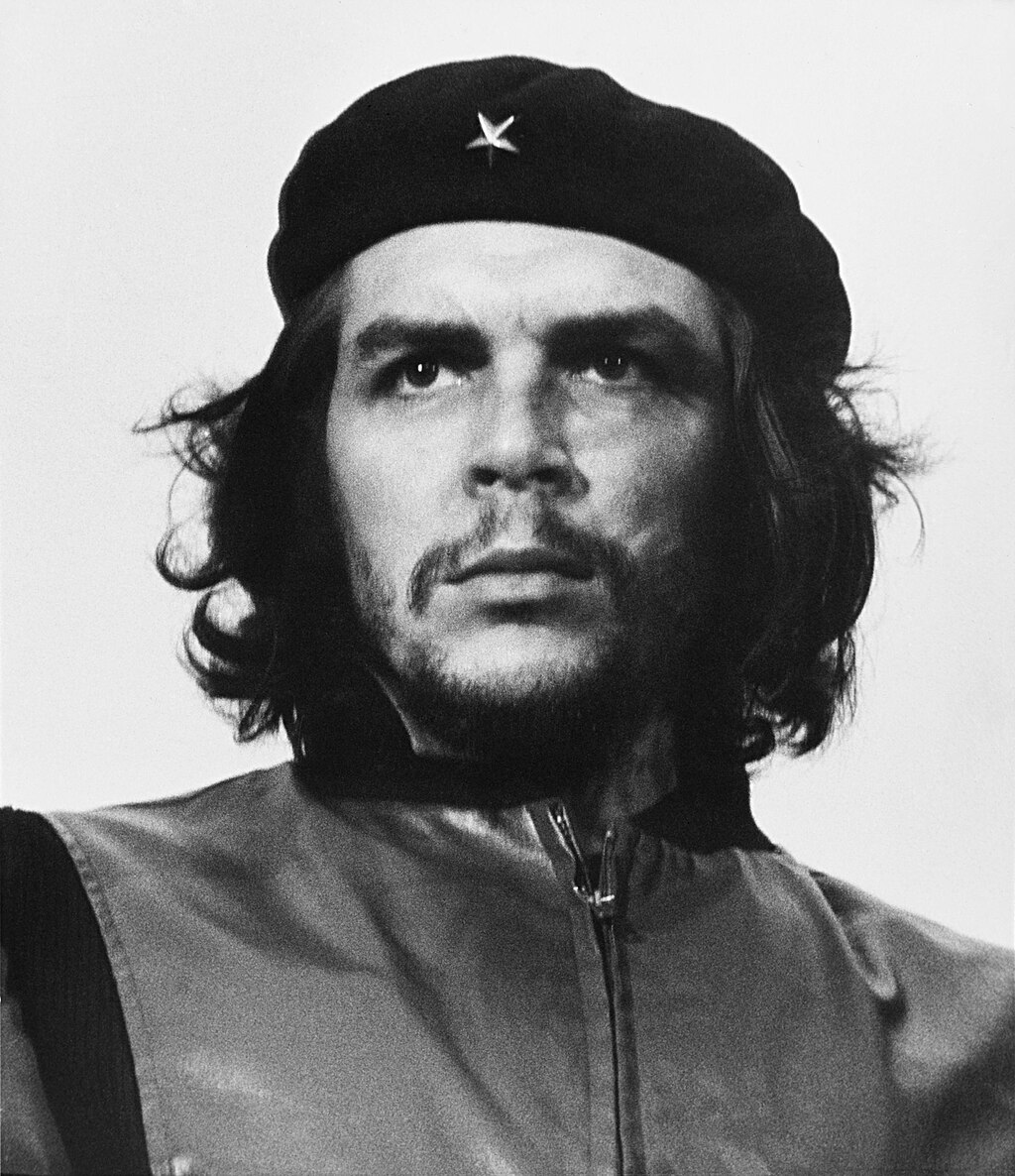
チェ・ゲバラ
Ernesto "Che" Guevara,
1928-1967
☆エルネスト・チェ・ゲバラ[チェはニックネーム](1928年5月14 日 - 1967年10月9日)は、アルゼンチンのマルクス主義革命家、医師、作家、ゲリラ指導者、外交官、政治家、軍事理論家。キューバ革命の主要人物であり、 その様式化された肖像は、反文化の象徴として、また大衆文化における世界的なシンボルとして広く知られている(→エルネスト・チェ・ゲバラ年譜)。
| Ernesto "Che" Guevara[b]
(14 May 1928[a] – 9 October 1967) was an Argentine Marxist
revolutionary, physician, author, guerrilla leader, diplomat,
politician and military theorist. A major figure of the Cuban
Revolution, his stylized visage has become a countercultural symbol of
rebellion and global insignia in popular culture.[6] As a young medical student, Guevara travelled throughout South America and was appalled by the poverty, hunger, and disease he witnessed.[7][8] His burgeoning desire to help overturn what he saw as the capitalist exploitation of Latin America by the United States prompted his involvement in Guatemala's social reforms under President Jacobo Árbenz, whose eventual CIA-assisted overthrow at the behest of the United Fruit Company solidified Guevara's political ideology.[7] Later in Mexico City, Guevara met Raúl and Fidel Castro, joined their 26th of July Movement, and sailed to Cuba aboard the yacht Granma with the intention of overthrowing US-backed dictator Fulgencio Batista.[9] Guevara soon rose to prominence among the insurgents, was promoted to second-in-command, and played a pivotal role in the two-year guerrilla campaign which deposed the Batista regime.[10] After the Cuban Revolution, Guevara played key roles in the new government. These included reviewing the appeals and death sentences for those convicted as war criminals during the revolutionary tribunals,[11] instituting agrarian land reform as minister of industries, helping spearhead a successful nationwide literacy campaign, serving as both president of the National Bank and instructional director for Cuba's armed forces, and traversing the globe as a diplomat on behalf of Cuban socialism. Such positions also allowed him to play a central role in training the militia forces who repelled the Bay of Pigs Invasion,[12] and bringing Soviet nuclear-armed ballistic missiles to Cuba, a decision which ultimately precipitated the 1962 Cuban Missile Crisis.[13] Additionally, Guevara was a prolific writer and diarist, composing a seminal guerrilla warfare manual, along with a best-selling memoir about his youthful continental motorcycle journey. His experiences and studying of Marxism–Leninism led him to posit that the Third World's underdevelopment and dependence was an intrinsic result of imperialism, neocolonialism, and monopoly capitalism, with the only remedies being proletarian internationalism and world revolution.[14][15] Guevara left Cuba in 1965 to foment continental revolutions across both Africa and South America,[16] first unsuccessfully in Congo-Kinshasa and later in Bolivia, where he was captured by CIA-assisted Bolivian forces and summarily executed.[17] Guevara remains both a revered and reviled historical figure, polarized in the collective imagination in a multitude of biographies, memoirs, essays, documentaries, songs, and films. As a result of his perceived martyrdom, poetic invocations for class struggle, and desire to create the consciousness of a "new man" driven by moral rather than material incentives,[18] Guevara has evolved into a quintessential icon of various leftist movements. In contrast, his critics on the political right accuse him of promoting authoritarianism and endorsing violence against his political opponents. Despite disagreements on his legacy, Time named him one of the 100 most influential people of the 20th century,[19] while an Alberto Korda photograph of him, titled Guerrillero Heroico, was cited by the Maryland Institute College of Art as "the most famous photograph in the world".[20] |
エルネスト・チェ・ゲバラ[チェはニックネーム](1928年5月14
日 -
1967年10月9日)は、アルゼンチンのマルクス主義革命家、医師、作家、ゲリラ指導者、外交官、政治家、軍事理論家。キューバ革命の主要人物であり、
その様式化された肖像は、反文化の象徴として、また大衆文化における世界的なシンボルとして広く知られている。[6] 若い医学生だったゲバラは、南米を旅し、そこで目にした貧困、飢餓、病気の現実に衝撃を受けた。[7][8] 彼が目にしたアメリカ合衆国によるラテンアメリカへの資本主義的搾取を覆すための援助への強い願望が、ゲバラをグアテマラの社会改革に参画させるきっかけ となった。この改革は、ジャコボ・アルベンス大統領の下で行われたが、最終的にアメリカ合衆国中央情報局(CIA)の支援を受けたユナイテッド・フルー ツ・カンパニーの要請によりアルベンス政権が転覆されたことで、ゲバラの政治思想が固まった。[7] その後、メキシコシティでラウル・カストロとフィデル・カストロと出会い、彼らの「7月26日運動」に参加し、米国が支援する独裁者フルヘンシオ・バティ スタを転覆させる目的で、ヨット「グランマ」に乗ってキューバに渡った。[9] ゲバラはすぐに反乱軍の中で頭角を現し、副司令官に昇進し、2年にわたるゲリラ戦において、バティスタ政権を転覆させる上で重要な役割を果たした。 [10] キューバ革命後、ゲバラは新政府で重要な役割を果たした。その中には、革命裁判で戦争犯罪者として有罪判決を受けた者たちの控訴と死刑判決の見直し [11]、産業大臣として農業土地改革の実施、全国的な識字運動の成功の指揮、国立銀行総裁およびキューバ軍教育担当長官の職務、キューバ社会主義の外交 官として世界中を飛び回る活動などが含まれる。これらの役職を通じて、彼はピッグス湾侵攻を撃退した民兵部隊の訓練[12]や、ソ連の核搭載弾道ミサイル のキューバ配備を推進する役割を果たした。この決定は、1962年のキューバミサイル危機を招くことになった。[13] ゲバラは多作な作家兼日記作家でもあり、ゲリラ戦術の古典的なマニュアルを執筆し、若き日の大陸横断モーターサイクル旅行のベストセラー回顧録も残した。 マルクス・レーニン主義の研究を通じて、彼は第三世界の後進性と依存は帝国主義、新植民地主義、独占資本主義の必然的な結果であり、唯一の解決策はプロレ タリア国際主義と世界革命であると主張した。[14][15] グエバラは1965年にキューバを離れ、アフリカと南米で大陸規模の革命を扇動した[16]。まずコンゴ・キンシャサで失敗し、その後ボリビアでCIAの 支援を受けたボリビア軍に捕らえられ、即決処刑された[17]。 ゲバラは、数多くの伝記、回顧録、エッセイ、ドキュメンタリー、歌、映画などで、集団的想像力の中で二極化され、尊敬と非難の両方を浴びる歴史上の人物と して今なお残っています。彼の殉教とみなされる死、階級闘争を唱える詩的な呼びかけ、物質的な動機ではなく道徳的な動機によって「新しい人間」の意識を創 造したいという願望[18] の結果、ゲバラはさまざまな左翼運動の象徴的な人物へと進化しました。一方、政治的な右派は、ゲバラを権威主義を助長し、政敵に対する暴力を容認した人物 だと非難している。彼の遺産については意見が分かれているが、タイム誌はゲバラを 20 世紀の最も影響力のある 100 人の 1 人に選び[19]、アルベルト・コルダが撮影したゲバラの写真「ゲリレロ・エロイコ」は、メリーランド芸術大学から「世界で最も有名な写真」に選ばれた [20]。 |
Early life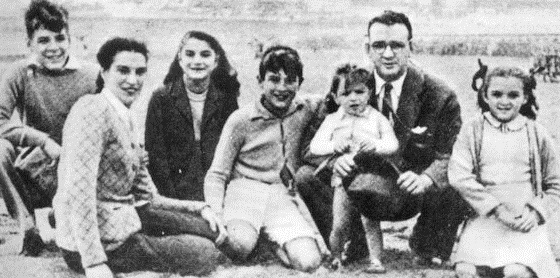 A teenage Ernesto (left) with his parents and siblings, c. 1944, seated beside him from left to right: Celia (mother), Celia (sister), Roberto, Juan Martín, Ernesto (father) and Ana María Ernesto Guevara was born to Ernesto Guevara Lynch and Celia de la Serna y Llosa, on 14 May 1928,[a] in Rosario, Argentina. Although the legal name on his birth certificate was "Ernesto Guevara", his name sometimes appears with "de la Serna" or "Lynch" accompanying it.[21] He was the eldest of five children in an upper-class Argentine family of pre-independence immigrants that have Spanish, Basque, and Irish ancestry.[22][23][c] Two of Guevara's notable 18th-century ancestors included Luis María Peralta, a prominent Spanish landowner in colonial California, and Patrick Lynch, who emigrated from Ireland to the Río de la Plata Governorate.[24][25] Referring to Che's "restless" nature, his father declared "the first thing to note is that in my son's veins flowed the blood of the Irish rebels".[26] Che Guevara was fond of Ireland, and according to Irish actress Maureen O'Hara, "Che would talk about Ireland and all the guerilla warfare that had taken place there. He knew every battle in Ireland and all of its history" and told her that everything he knew about Ireland he learned on his grandmother's knee.[27] Early on in life, Ernestito (as he was then called) developed an "affinity for the poor".[28] Growing up in a family with leftist leanings, Guevara was introduced to a wide spectrum of political perspectives even as a boy.[29] His father, a staunch supporter of Republicans from the Spanish Civil War, would host veterans from the conflict in the Guevara home.[30] As a young man, he briefly contemplated a career selling insecticides, and set up a laboratory in his family's garage to experiment with effective mixtures of talc and gammaxene under the brand name Vendaval, but was forced to abandon his efforts after suffering a severe asthmatic reaction to the chemicals.[31] Despite numerous bouts of acute asthma that were to affect him throughout his life, he excelled as an athlete, enjoying swimming, football, golf, and shooting, while also becoming an "untiring" cyclist.[32][33] He was an avid rugby union player.[34] Several sources say he first played for Estudiantes of Córdoba, then San Isidro Club (1947), Yporá Rugby Club (1948), and Atalaya Polo Club (1949),[35][36][37] although other sources claim he played for Club Universitario de Buenos Aires (CUBA),[38] at fly-half. His rugby playing earned him the nickname "Fuser"—a contraction of El Furibundo (furious) and his mother's surname, de la Serna—for his aggressive style of play.[39] |
幼年時代 1944年頃、両親と兄弟たちと一緒に写る10代のエルネスト(左)。左から右へ、セリア(母)、セリア(姉)、ロベルト、フアン・マルティン、エルネスト(父)、アナ・マリア。 エルネスト・ゲバラは、1928年5月14日、アルゼンチンのロサリオで、エルネスト・ゲバラ・リンチとセリア・デ・ラ・セルナ・イ・ロサの間に生まれ た。出生証明書上の正式な名前は「エルネスト・ゲバラ」だったが、名前には「デ・ラ・セルナ」または「リンチ」が付くこともある。[21] 彼は、スペイン、バスク、アイルランド系の祖先を持つ、独立前の移民のアルゼンチン人上流階級の家庭で5人兄弟の長男として生まれた。[22][23] [c] グエラの18世紀の著名な先祖には、植民地時代のカリフォルニアで著名なスペインの土地所有者であったルイス・マリア・ペラルタと、アイルランドからリ オ・デ・ラ・プラタ総督府に移住したパトリック・リンチが含まれる。[24][25] チェの「落ち着きのない」性格について、彼の父親は「まず最初に指摘すべきは、私の息子の血管にはアイルランドの反乱軍の血が流れていることだ」と述べ た。[26] チェ・ゲバラはアイルランドを愛し、アイルランドの女優モーリーン・オハラによると、「チェはアイルランドとそこで行われたゲリラ戦争についてよく話し た。彼はアイルランドのすべての戦いと歴史を知っていた」と語り、アイルランドについて知っていることはすべて祖母の膝の上で学んだと彼女に話した。 [27] 幼少期から、エルネスト(当時の名前)は「貧しい人々への親近感」を育んだ。[28] 左派傾向のある家庭で育ったゲバラは、少年時代から幅広い政治的見解に触れた。[29] スペイン内戦では共和派を熱烈に支持していた父親は、ゲバラの家に内戦退役軍人を宿泊させていた[30]。若い頃、彼は殺虫剤の販売職を短期間検討し、家 族のガレージに実験室を設立して、タルクとガンマキセンの有効な混合物を「ベンダバル」という商品名で開発したが、化学物質による重度の喘息発作に悩まさ れ、その努力を断念せざるを得なかった。[31] 生涯にわたって何度も急性喘息の発作に悩まされたにもかかわらず、彼は水泳、サッカー、ゴルフ、射撃などのスポーツに秀で、また「疲れ知らずの」サイクリ ストとしても知られていた。[32][33] 彼は熱心なラグビーユニオン選手だった。[34] いくつかの情報源によると、彼は最初にコルドバのエストゥディアンテスでプレーし、その後、サン・イシドロ・クラブ(1947年)、イポラ・ラグビー・ク ラブ(1948年)、アタラヤ・ポロ・クラブ(1949年)でプレーした。[35][36][37] 他の資料では、ブエノスアイレス大学クラブ(CUBA)でフライハーフとしてプレーしたとされている。[38] ラグビーでのプレーから、彼の攻撃的なプレイスタイルから「フサー」というニックネームが付けられた。これは「エル・フリブンド(激しい)」と母親の姓 「デ・ラ・セルナ」を組み合わせたもの。[39] |
| Intellectual and literary interests Guevara learned chess from his father and began participating in local tournaments by the age of 12. During adolescence and throughout his life, he was passionate about poetry, especially that of Pablo Neruda, John Keats, Antonio Machado, Federico García Lorca, Gabriela Mistral, César Vallejo, and Walt Whitman.[40] He could also recite Rudyard Kipling's If— and José Hernández's Martín Fierro by heart.[40] The Guevara home contained more than 3,000 books, which allowed Guevara to be an enthusiastic and eclectic reader, with interests including Karl Marx, William Faulkner, André Gide, Emilio Salgari, and Jules Verne.[41] Additionally, he enjoyed the works of Jawaharlal Nehru, Franz Kafka, Albert Camus, Vladimir Lenin, and Jean-Paul Sartre, as well as Anatole France, Friedrich Engels, H. G. Wells, and Robert Frost.[42] As he grew older, he developed an interest in the Latin American writers Horacio Quiroga, Ciro Alegría, Jorge Icaza, Rubén Darío, and Miguel Asturias.[42] Many of these authors' ideas he cataloged in his own handwritten notebooks of concepts, definitions, and philosophies of influential intellectuals. These included composing analytical sketches of Buddha and Aristotle, along with examining Bertrand Russell on love and patriotism, Jack London on society, and Nietzsche on the idea of death. Sigmund Freud's ideas fascinated him as he quoted him on a variety of topics from dreams and libido to narcissism and the Oedipus complex.[42] His favorite subjects in school included philosophy, mathematics, engineering, political science, sociology, history, and archaeology.[43][44] A CIA "biographical and personality report", dated 13 February 1958 and declassified decades later, made note of Guevara's range of academic interests and intellect – describing him as "quite well read", while adding that "Che is fairly intellectual for a Latino".[45] |
知的・文学的関心 ゲバラは父親からチェスを学び、12歳の頃から地元のトーナメントに出場し始めた。青年期から生涯を通じて、彼は詩、特にパブロ・ネルーダ、ジョン・キー ツ、アントニオ・マチャド、フェデリコ・ガルシア・ロルカ、ガブリエラ・ミストラル、セサル・ヴァレーホ、ウォルト・ホイットマンの詩に情熱を注いだ。 [40] また、ラドヤード・キップリングの『もし』とホセ・エルナンデスの『マルティン・フィエロ』を暗唱することもできた。[40] グエバラの自宅には3,000冊以上の本があり、グエバラはカール・マルクス、ウィリアム・フォークナー、アンドレ・ジッド、エミリオ・サルガリ、ジュー ル・ヴェルヌなど、幅広い分野に熱心な読書家だった。[41] さらに、ジャワハルラール・ネルー、フランツ・カフカ、アルベール・カミュ、ウラジーミル・レーニン、ジャン=ポール・サルトル、アナトール・フランス、 フリードリヒ・エンゲルス、H. G. ウェルズ、ロバート・フロストなどの作品も好んだ。[42] 年を重ねるにつれて、彼はラテンアメリカの作家、オラシオ・キロガ、シロ・アレグリア、ホルヘ・イカサ、ルベン・ダリオ、ミゲル・アストゥリアスに興味を 持つようになった。[42] これらの作家の考えの多くは、影響力のある知識人の概念、定義、哲学を自分の手書きのノートにまとめました。その中には、仏陀やアリストテレスの分析的ス ケッチ、バートランド・ラッセルによる愛と愛国心、ジャック・ロンドンによる社会、ニーチェによる死の概念についての考察などが含まれていた。彼は、夢や 性欲からナルシシズム、エディプスコンプレックスに至るまで、さまざまなトピックについて引用しながら、ジークムント・フロイトの思想に魅了されていた [42]。学校での好きな科目には、哲学、数学、工学、政治学、社会学、歴史、考古学があった。[43][44] 1958年2月13日付のCIAの「経歴および性格報告書」は、数十年後に機密解除され、ゲバラの幅広い学問的関心と知性を指摘し、彼を「かなり博識」と 評し、「ラテン系としてはかなり知的な人物」と付け加えている。[45] |
| Motorcycle journey Main article: The Motorcycle Diaries (book) 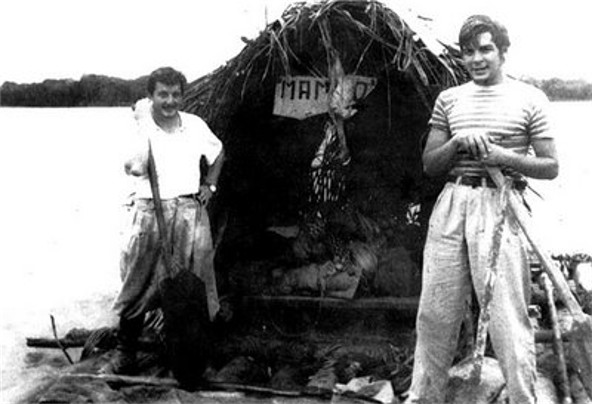 black and white photograph of two men on a raft, fitted with a large hut. The far bank of the river is visible in the far distance Guevara (right) with Alberto Granado (left) in June 1952 on the Amazon River aboard their "Mambo-Tango" wooden raft, which was a gift from the lepers whom they had treated[46] In 1948, Guevara entered the University of Buenos Aires to study medicine. His "hunger to explore the world"[47] led him to intersperse his collegiate pursuits with two long introspective journeys that fundamentally changed the way he viewed himself and the contemporary economic conditions in Latin America. The first expedition, in 1950, was a 4,500-kilometer (2,800 mi) solo trip through the rural provinces of northern Argentina on a bicycle on which he had installed a small engine.[48] Guevara then spent six months working as a nurse at sea on Argentina's merchant marine freighters and oil tankers.[49] His second expedition, in 1951, was a nine-month, 8,000-kilometer (5,000 mi) continental motorcycle trek through part of South America. For the latter, he took a year off from his studies to embark with his friend, Alberto Granado, with the final goal of spending a few weeks volunteering at the San Pablo leper colony in Peru, on the banks of the Amazon River.[50] 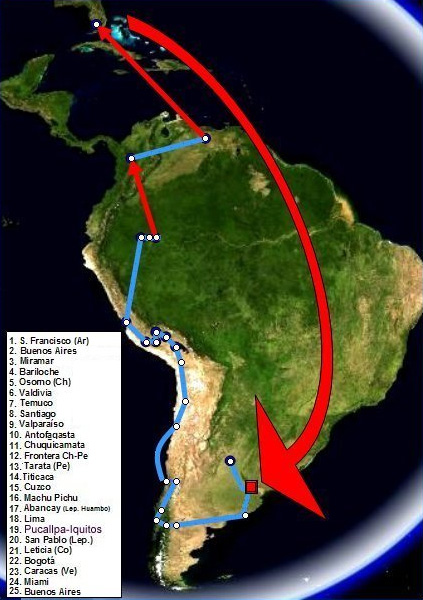 A map of Guevara's 1952 trip with Alberto Granado (The red arrows correspond to air travel.) In Chile, Guevara was angered by the working conditions of the miners at Anaconda's Chuquicamata copper mine, moved by his overnight encounter in the Atacama Desert with a persecuted communist couple who did not even own a blanket, describing them as "the shivering flesh-and-blood victims of capitalist exploitation".[51] On the way to Machu Picchu he was stunned by the crushing poverty of the remote rural areas, where peasant farmers worked small plots of land owned by wealthy landlords.[52] Later on his journey, Guevara was especially impressed by the camaraderie among the people living in a leper colony, stating, "The highest forms of human solidarity and loyalty arise among such lonely and desperate people."[52] Guevara used notes taken during this trip to write an account (not published until 1995), titled The Motorcycle Diaries, which later became a New York Times best seller,[53] and was adapted into a 2004 film of the same name. A motorcycle journey the length of South America awakened him to the injustice of US domination in the hemisphere, and to the suffering colonialism brought to its original inhabitants. —George Galloway, British politician, 2006[54] The journey took Guevara through Argentina, Chile, Peru, Ecuador, Colombia, Venezuela, Panama, and Miami, Florida, for 20 days,[55] before returning home to Buenos Aires. By the end of the trip, he came to view Latin America not as a collection of separate nations, but as a single entity requiring a continent-wide liberation strategy. His conception of a borderless, united Hispanic America sharing a common Latino heritage was a theme that recurred prominently during his later revolutionary activities. Upon returning to Argentina, he completed his studies and received his medical degree in June 1953.[56][57] Guevara later remarked that, through his travels in Latin America, he came in "close contact with poverty, hunger and disease" along with the "inability to treat a child because of lack of money" and "stupefaction provoked by the continual hunger and punishment" that leads a father to "accept the loss of a son as an unimportant accident". Guevara cited these experiences as convincing him that to "help these people", he needed to leave the realm of medicine and consider the political arena of armed struggle.[7] |
オートバイの旅 主な記事:オートバイ日記(書籍)  2人の男性が大きな小屋を付けた筏に乗っている白黒写真。遠くには川の対岸が見える 1952年6月、アマゾン川で「マンボ・タンゴ」と名付けた木製の筏に乗ったゲバラ(右)とアルベルト・グラナド(左)。この筏は、彼らが治療したハンセン病患者たちから贈られたものだった[46] 1948年、ゲバラはブエノスアイレス大学に入学し、医学を学んだ。彼の「世界を探求したいという渇望」[47]は、大学での学業と並行して、2度の長い 内省的な旅を挟むことになり、これが彼自身とラテンアメリカにおける当時の経済状況に対する見方を根本から変えることになった。最初の旅は1950年で、 アルゼンチン北部の農村地帯を自転車に小型エンジンを装着して4,500キロメートル(2,800マイル)を単独で走破した。[48] ゲバラはその後、アルゼンチンの商船の貨物船と石油タンカーで6ヶ月間、看護師として働いた。[49] 1951年の2度目の探検は、南米の一部を横断する9ヶ月間、8,000キロメートル(5,000マイル)のモーターサイクルの旅だった。この旅のため、 彼は学業を1年間休学し、友人アルベルト・グラナドと共に、ペルーのアマゾン川沿いにあるサン・パブロのハンセン病コロニーで数週間ボランティア活動を行 うことを最終目標として出発した。[50]  1952年にアルベルト・グラナドと行った旅の地図(赤い矢印は航空路)。 チリでは、アナコンダ社のチュキカマタ銅山で働く鉱夫たちの労働条件に怒りを覚えた。アタカマ砂漠で、毛布一つ持たない迫害された共産党員夫婦と一夜を共 に過ごし、彼らを「資本主義的搾取の震える生身の人間」と表現した。[51] マチュピチュに向かう途中、彼は、貧しい農民たちが裕福な地主が所有する小さな農地を耕作している、辺鄙な農村部の極度の貧困に衝撃を受けた[52]。旅 の途中、ゲバラは、ハンセン病の患者たちが暮らすコロニーで、彼ら間の仲間意識に特に感銘を受け、「このような孤独で絶望的な人々の中に、人間としての連 帯と忠誠の最高形態が生まれる」と述べた。[52] ゲバラはこの旅で取ったメモを基に、1995年に初めて出版された『モーターサイクル・ダイアリーズ』という著作を執筆した。この作品はのちにニューヨー ク・タイムズのベストセラーとなり、2004年に同名の映画化もされた。 南米を縦断するオートバイの旅は、この半球における米国の支配の不正と、その先住民たちに与えた植民地主義の苦悩に彼の目を覚まさせた。 —ジョージ・ギャロウェイ、英国の政治家、2006年[54] この旅は、ゲバラをアルゼンチン、チリ、ペルー、エクアドル、コロンビア、ベネズエラ、パナマ、そしてフロリダ州マイアミへと20日間かけて導き [55]、その後彼はブエノスアイレスの自宅に戻った。旅の終わりには、彼はラテンアメリカを別々の国民が集合した集合体ではなく、大陸全体の解放戦略を 必要とする単一の団体として捉えるようになった。共通のラテンアメリカの遺産を共有する、国境のない統一されたヒスパニック系アメリカという彼の構想は、 その後の革命活動において繰り返し登場するテーマとなった。アルゼンチンに戻った彼は、学業を修了し、1953年6月に医学の学位を取得した[56]。 [57] ゲバラは後に、ラテンアメリカを旅して、「貧困、飢餓、病気」に直面し、「お金がないために子供たちを治療できない」状況や、「絶え間ない飢餓と罰によっ て引き起こされる麻痺状態」が父親たちに「息子の死を些細な事故として受け入れる」ように仕向けることを知ったと語っている。ゲバラは、これらの経験か ら、「これらの人々を助ける」ためには、医学の分野を離れ、武力闘争という政治の分野に目を向ける必要があると確信したと述べている[7]。 |
| Early political activity Activism in Guatemala Main article: 1954 Guatemalan coup d'état Ernesto Guevara spent just over nine months in Guatemala. On 7 July 1953, Guevara set out again, this time to Bolivia, Peru, Ecuador, Panama, Costa Rica, Nicaragua, Honduras, and El Salvador. On 10 December 1953, before leaving for Guatemala, Guevara sent an update to his aunt Beatriz from San José, Costa Rica. In the letter Guevara speaks of traversing the dominion of the United Fruit Company, a journey which convinced him that the company's capitalist system was disadvantageous to the average citizen.[58] He adopted an aggressive tone to frighten his more conservative relatives, and the letter ends with Guevara swearing on an image of the then-recently deceased Joseph Stalin, not to rest until these "octopuses have been vanquished".[59] Later that month, Guevara arrived in Guatemala, where President Jacobo Árbenz headed a democratically elected government that, through land reform and other initiatives, was attempting to end the latifundia agricultural system. To accomplish this, President Árbenz had enacted a major land reform program, where all uncultivated portions of large land holdings were to be appropriated and redistributed to landless peasants. The largest land owner, and the one most affected by the reforms, was the United Fruit Company, from which the Árbenz government had already taken more than 225,000 acres (91,000 ha) of uncultivated land.[60] Pleased with the direction in which the nation was heading, Guevara decided to make his home in Guatemala to "perfect himself and accomplish whatever may be necessary in order to become a true revolutionary".[60][61] 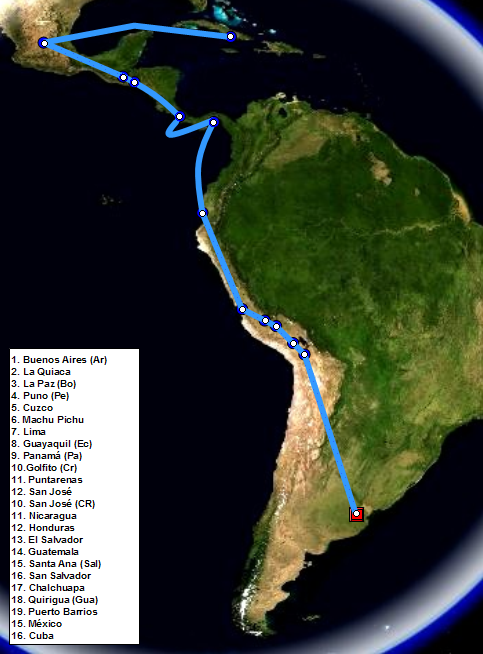 A map of Che Guevara's travels between 1953 and 1956, including his journey aboard the Granma In Guatemala City, Guevara sought out Hilda Gadea Acosta, a Peruvian economist who was politically well-connected as a member of the left-leaning, Alianza Popular Revolucionaria Americana (APRA). She introduced Guevara to a number of high-level officials in the Árbenz government. Guevara then established contact with a group of Cuban exiles linked to Fidel Castro through the 26 July 1953 attack on the Moncada Barracks in Santiago de Cuba. During this period, he acquired his famous nickname, due to his frequent use of the Argentine filler expression che (a multi-purpose discourse marker, like the syllable "eh" in Canadian English).[62] During his time in Guatemala, Guevara was hosted by other Central American exiles, one of whom, Helena Leiva de Holst, provided him with food and lodging,[63] discussed her travels to study Marxism in Russia and China,[64] and to whom Guevara dedicated a poem, "Invitación al camino".[65] In May 1954, a ship carrying infantry and light artillery weapons was dispatched by communist Czechoslovakia for the Árbenz government and arrived in Puerto Barrios.[66] As a result, the United States government—which since 1953 had been tasked by President Eisenhower to remove Árbenz from power in the multifaceted CIA operation code-named PBSuccess—responded by saturating Guatemala with anti-Árbenz propaganda through radio and air-dropped leaflets, and began bombing raids using unmarked airplanes.[67] The United States also sponsored an armed force of several hundred anti-Árbenz Guatemalan refugees and mercenaries headed by Carlos Castillo Armas to help remove the Árbenz government. On 27 June, Árbenz chose to resign.[68] This allowed Armas and his CIA-assisted forces to march into Guatemala City and establish a military junta, which elected Armas as president on 7 July.[69] The Armas regime then consolidated power by rounding up and executing suspected communists,[70] while crushing the previously flourishing labor unions[71] and reversing the previous agrarian reforms.[72] Guevara was eager to fight on behalf of Árbenz, and joined an armed militia organized by the communist youth for that purpose. However, frustrated with that group's inaction, Guevara soon returned to medical duties. Following the coup, he again volunteered to fight, but soon after, Árbenz took refuge in the Mexican embassy and told his foreign supporters to leave the country. Guevara's repeated calls to resist were noted by supporters of the coup, and he was marked for murder.[73] After Gadea was arrested, Guevara sought protection inside the Argentine consulate, where he remained until he received a safe-conduct pass some weeks later and made his way to Mexico.[74] The overthrow of the Árbenz government and establishment of the right-wing Armas dictatorship cemented Guevara's view of the United States as an imperialist power that opposed and attempted to destroy any government that sought to redress the socioeconomic inequality endemic to Latin America and other developing countries.[60] In speaking about the coup, Guevara stated: The last Latin American revolutionary democracy – that of Jacobo Árbenz – failed as a result of the cold premeditated aggression carried out by the United States. Its visible head was the Secretary of State John Foster Dulles, a man who, through a rare coincidence, was also a stockholder and attorney for the United Fruit Company.[73] Guevara's conviction strengthened that Marxism, achieved through armed struggle and defended by an armed populace, was the only way to rectify such conditions.[75] Gadea wrote later, "It was Guatemala which finally convinced him of the necessity for armed struggle and for taking the initiative against imperialism. By the time he left, he was sure of this."[76] |
初期の政治活動 グアテマラでの活動 主な記事:1954年のグアテマラのクーデター エルネスト・ゲバラはグアテマラに9ヶ月余りを過ごした。1953年7月7日、ゲバラは再び出発し、今回はボリビア、ペルー、エクアドル、パナマ、コスタ リカ、ニカラグア、ホンジュラス、エルサルバドルへ向かった。1953年12月10日、グアテマラへ向かう前に、ゲバラはコスタリカのサンホセから叔母の ベアトリスに近況報告を送った。その手紙でゲバラは、ユナイテッド・フルーツ・カンパニーの支配下にある地域を traversing した経験について述べ、その旅が同社の資本主義システムが一般市民に不利であることを確信させたと言及している。[58] 彼は保守的な親戚を脅かすために攻撃的なトーンを採用し、手紙は「これらの『タコ』が打ち倒されるまで休まない」と、当時最近死去したヨシフ・スターリン の肖像画に誓う言葉で結ばれている。[59] その月の後半、ゲバラはグアテマラに到着した。同国では、ジャコボ・アルベンス大統領が民主的に選出された政府を率い、土地改革をはじめとする措置を通じ て、大土地所有制(ラティフンディア)を廃止しようとしていた。この目的のため、アルベンス大統領は主要な土地改革プログラムを実施し、大規模な土地所有 者の未開墾地を没収し、土地を持たない農民に再分配する方針を打ち出した。最大の土地所有者であり、改革で最も影響を受けたのはユナイテッド・フルーツ・ カンパニーで、アルベンツ政権は既に同社から22万5,000エーカー(9万1,000ヘクタール)の未開墾地を接収していた。[60] 国の進む方向性に満足したゲバラは、グアテマラに定住し、「自分自身を完成させ、真の革命家になるために必要なことをすべて達成する」ことを決意した。 [60][61]  1953年から1956年にかけてのチェ・ゲバラの旅行ルート。グランマ号での航海も含まれる。 グアテマラシティで、ゲバラはペルーの経済学者で、左派の「アメリカ人民革命同盟」(APRA)のメンバーとして政治的に影響力のあるヒルダ・ガデア・ア コスタと出会った。彼女はゲバラをアルベンツ政権の高官たちに紹介した。その後、ゲバラは、1953年7月26日にサンティアゴ・デ・クーバのモンカダ兵 舎を襲撃した事件に関わった、フィデル・カストロと関係のあるキューバ亡命者たちとの接触を確立した。この期間、彼は、アルゼンチンでよく使われる間投詞 「チェ」(カナダ英語での「え」のような、さまざまな意味を持つ言説のマーカー)を頻繁に使用していたことから、その有名なニックネームを授けられた。 [62] グアテマラ滞在中、ゲバラは他の中央アメリカ亡命者たちから支援を受け、その一人であるヘレナ・レイバ・デ・ホルストからは食料と住居を提供された [63]。彼女はロシアと中国でマルクス主義を学ぶための旅について語り[64]、ゲバラは彼女に詩「Invitación al camino」を捧げた。[65] 1954年5月、共産主義のチェコスロバキアは、アルベンツ政権のために歩兵と軽砲兵の武器を積んだ船を派遣し、プエルト・バリオスに到着した。[66] これに対し、1953年からアイゼンハワー大統領の指示で、CIAの多面的な作戦「PBSuccess」を通じてアーベンツ政権の打倒を任務としていたア メリカ政府は、ラジオや空から散布されたビラを通じて反アーベンツ宣伝をグアテマラ全土に展開し、無標識の航空機による爆撃を開始した。[67] アメリカ合衆国はまた、カルロス・カスティージョ・アルマス率いる数百人の反アルベンツ派グアテマラ難民と傭兵からなる武装勢力を支援し、アルベンツ政権 の打倒を支援した。6月27日、アーベンツは辞任を表明した。[68] これにより、アルマスとCIAの支援を受けた勢力はグアテマラシティに進軍し、軍事政権を樹立。7月7日にアルマスが大統領に選出された。[69] アルマス政権は、共産主義者と疑われる人物を逮捕・処刑し、[70] 以前繁栄していた労働組合を弾圧し、[71] これまでの農業改革を撤回することで権力を固めた。[72] ゲバラはアルベンツのために戦うことを熱望し、その目的のために共産主義の若者たちによって組織された武装民兵に加わった。しかし、そのグループの無為無 策に不満を抱いたゲバラは、すぐに医療業務に戻った。クーデター後、彼は再び戦闘に参加することを志願したが、その直後、アルベンツはメキシコ大使館に避 難し、外国の支援者たちに国を離れるよう指示した。ゲバラの抵抗を呼びかける繰り返しの呼びかけはクーデター支持者に注目され、彼は暗殺対象に指定された [73]。ガデアが逮捕されると、ゲバラはアルゼンチン領事館内に保護を求め、数週間後に安全通行証を取得するまでそこに留まり、その後メキシコへ移動し た。[74] アルベンツ政権の打倒と、右翼のアルマス独裁政権の樹立は、ゲバラの、米国はラテンアメリカやその他の発展途上国に蔓延する社会経済的不平等を是正しよう とするあらゆる政権に反対し、その破壊を試みる帝国主義大国であるという見解を固めた。[60] クーデターについて、ゲバラは次のように述べている。 ラテンアメリカ最後の革命的民主主義政権——ヤコボ・アルベンツ政権——は、アメリカ合衆国によって計画的に実行された冷酷な侵略により崩壊した。その表 向きの首謀者は国務長官ジョン・フォスター・ダレスで、彼は偶然にもユナイテッド・フルーツ・カンパニーの株主兼弁護士でもあった。[73] ゲバラの信念は、武装闘争を通じて達成され、武装した民衆によって守られるマルクス主義が、このような状況を是正する唯一の道であるとの考えを強めた。 [75] ガデアは後に、「彼に武装闘争の必要性と帝国主義に対して主導権を握る必要性を確信させたのは、結局グアテマラだった。彼がグアテマラを去る頃には、彼は それを確信していた」と書いている。[76] |
Exile in Mexico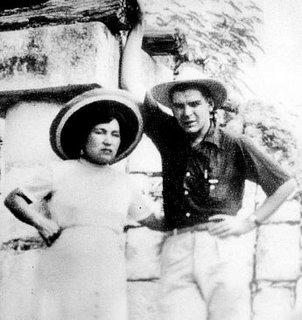 Guevara with his first wife Hilda Gadea at Chichen Itza during their honeymoon trip Guevara arrived in Mexico City on 21 September 1954, and worked in the allergy section of the General Hospital and at the Hospital Infantil de Mexico.[77][78] In addition he gave lectures on medicine at the Faculty of Medicine in the National Autonomous University of Mexico and worked as a news photographer for Latina News Agency.[79][80] His first wife Hilda notes in her memoir My Life with Che, that for a while, Guevara considered going to work as a doctor in Africa and that he continued to be deeply troubled by the poverty around him.[81] In one instance, Hilda describes Guevara's obsession with an elderly washerwoman whom he was treating, remarking that he saw her as "representative of the most forgotten and exploited class". Hilda later found a poem that Che had dedicated to the old woman, containing "a promise to fight for a better world, for a better life for all the poor and exploited".[81] During this time he renewed his friendship with Ñico López and the other Cuban exiles whom he had met in Guatemala. In June 1955, López introduced him to Raúl Castro, who subsequently introduced him to his older brother, Fidel Castro, the revolutionary leader who had formed the 26th of July Movement and was now plotting to overthrow the dictatorship of Fulgencio Batista. During a long conversation with Fidel on the night of their first meeting, Guevara concluded that the Cuban's cause was the one for which he had been searching and before daybreak he had signed up as a member of 26 July Movement.[82] Despite their "contrasting personalities", from this point on Che and Fidel began to foster what dual biographer Simon Reid-Henry deemed a "revolutionary friendship that would change the world" as a result of their coinciding commitment to anti-imperialism.[83] By this point in Guevara's life, he deemed that US-controlled conglomerates had installed and supported repressive regimes around the world. In this vein, he considered Batista a "U.S. puppet whose strings needed cutting".[84] Although he planned to be the group's combat medic, Guevara participated in the military training with the members of the Movement. The key portion of training involved learning hit and run tactics of guerrilla warfare. Guevara and the others underwent arduous 15-hour marches over mountains, across rivers, and through the dense undergrowth, learning and perfecting the procedures of ambush and quick retreat. From the start Guevara was instructor Alberto Bayo's "prize student" among those in training, scoring the highest on all of the tests given.[85] At the end of the course, he was named "the best guerrilla of them all" by General Bayo.[86] Guevara then married Hilda in Mexico in September 1955, before embarking on his plan to assist in the liberation of Cuba.[87] |
メキシコでの亡命 新婚旅行中のチチェン・イッツァで、最初の妻ヒルダ・ガデアとゲバラ ゲバラは1954年9月21日にメキシコシティに到着し、総合病院のアレルギー科とメキシコ小児病院で働いた[77]。[78] さらに、メキシコ国立自治大学医学部で医学の講義を行い、ラティーナ通信社の報道写真家としても働いた。[79][80] 彼の最初の妻ヒルダは回顧録『My Life with Che』の中で、ゲバラはしばらくの間、アフリカで医師として働くことを考え、周囲の貧困に深く悩んでいたと記している。[81] ある時、ヒルダはゲバラが治療していた高齢の洗濯婦への執着を記述し、彼を「最も忘れ去られ、搾取された階級の代表」と見なしていたと述べている。ヒルダ は後に、チェが老婦人に捧げた詩を発見し、その中で「より良い世界、すべての貧しい者や搾取された者のためのより良い生活のために戦う」という誓いが記さ れていた。[81] この間、彼はグアテマラで出会ったニコ・ロペスや他のキューバ亡命者たちとの友情を再び深めた。1955年6月、ロペスは彼をラウル・カストロに紹介し、 ラウルは彼を、7月26日運動を結成し、フルヘンシオ・バティスタの独裁政権の打倒を企てていた革命指導者である兄のフィデル・カストロに紹介した。最初 の出会いの夜、フィデルとの長い会話の末、ゲバラはキューバの闘いが自分が求めていたものだと確信し、夜明け前に7月26日運動のメンバーとして加入し た。[82] 「対照的な性格」にもかかわらず、この時点から、チェとフィデルは、反帝国主義への共通の決意から、2人の伝記作家サイモン・リード・ヘンリーが「世界を 変える革命的な友情」と表現する関係を築き始めた。[83] この時点でゲバラは、米国が支配する大企業が世界中に抑圧的な政権を樹立し、支援していると判断していた。この観点から、彼はバティスタを「米国が操る傀 儡」と見なし、その「糸を切る」必要があると考えた。[84] ゲバラはグループの戦闘衛生兵となる予定だったが、運動のメンバーとともに軍事訓練に参加した。訓練の核心部分は、ゲリラ戦のヒットアンドラン戦術の習得 だった。ゲバラと他のメンバーは、山を越え、川を渡り、密林を駆け抜ける過酷な15時間の行軍を繰り返し、待ち伏せと迅速な撤退の手順を学び、磨き上げ た。訓練開始から、ゲバラは指導者のアルベルト・バヨの「最優秀生徒」として、すべての試験で最高得点を獲得した。[85] コース終了時、ゲバラはバヨ将軍から「最も優秀なゲリラ」と称賛された。[86] ゲバラは1955年9月、メキシコでヒルダと結婚した後、キューバの解放を支援する計画に着手した。[87] |
| Cuban Revolution Main article: Cuban Revolution Granma invasion Further information: Landing of the Granma and Battle of Alegría de Pío 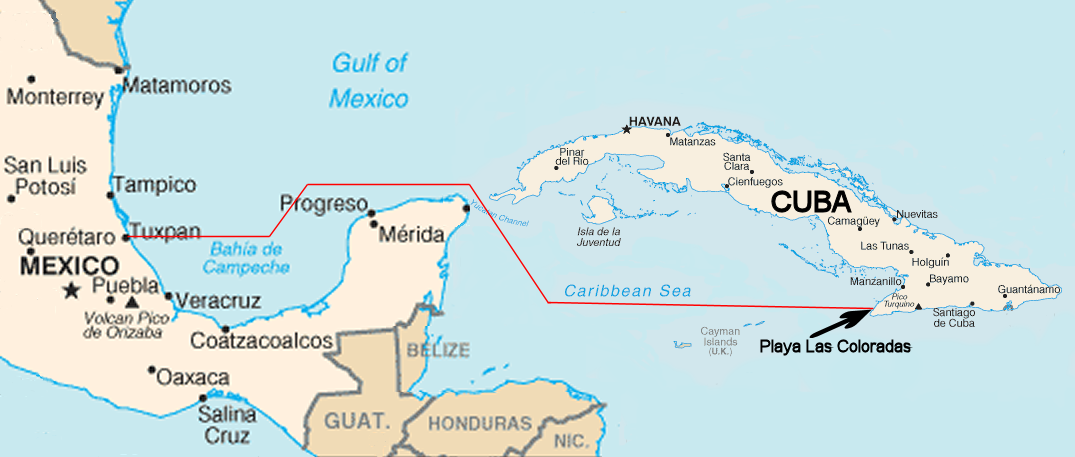 Journey of the yacht "Granma", from Mexico to Cuba 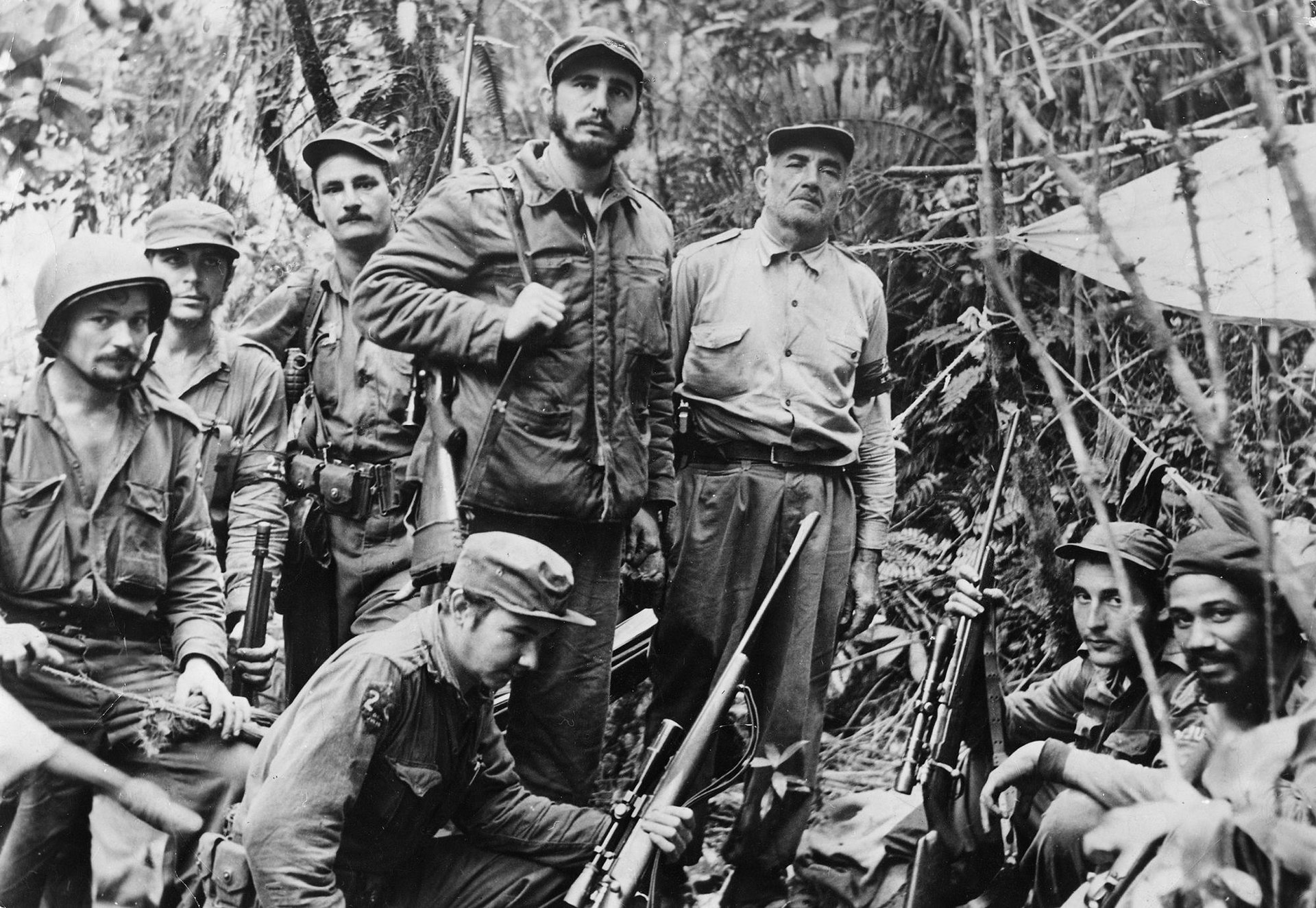 Granma survivors in the Sierra Maestra. Fidel Castro stands at center. Che Guevara stands second from left. The first step in Castro's revolutionary plan was an assault on Cuba from Mexico via the Granma, an old, leaky cabin cruiser. They set out for Cuba on 25 November 1956. Attacked by Batista's military soon after landing, many of the 82 men were either killed in the attack or executed upon capture; only 22 found each other afterwards.[88] During this initial bloody confrontation, Guevara laid down his medical supplies and picked up a box of ammunition dropped by a fleeing comrade, proving to be a symbolic moment in Che's life.[89] Only a small band of revolutionaries survived to re-group as a bedraggled fighting force deep in the Sierra Maestra mountains, where they received support from the urban guerrilla network of Frank País, the 26 July Movement, and local campesinos. With the group withdrawn to the Sierra, the world wondered whether Castro was alive or dead until early 1957, when an interview by Herbert Matthews appeared in The New York Times. The article presented a lasting, almost mythical image for Castro and the guerrillas. Guevara was not present for the interview, but in the coming months he began to realize the importance of the media in their struggle. Meanwhile, as supplies and morale diminished, and with an allergy to mosquito bites which resulted in agonizing walnut-sized cysts on his body,[90] Guevara considered these "the most painful days of the war".[91] During Guevara's time living hidden among the poor subsistence farmers of the Sierra Maestra mountains, he discovered that there were no schools, no electricity, minimal access to healthcare, and more than 40 percent of the adults were illiterate.[92] As the war continued, Guevara became an integral part of the rebel army and "convinced Castro with competence, diplomacy and patience".[10] Guevara set up factories to make grenades, built ovens to bake bread, and organized schools to teach illiterate campesinos to read and write.[10] Moreover, Guevara established health clinics, workshops to teach military tactics, and a newspaper to disseminate information.[93] The man whom Time dubbed three years later "Castro's brain" at this point was promoted by Fidel Castro to Comandante (commander) of a second army column.[10] |
キューバ革命 主な記事:キューバ革命 グランマ号侵攻 詳細情報:グランマ号の上陸とアレグリア・デ・ピオの戦い  ヨット「グランマ号」のメキシコからキューバへの航海  シエラ・マエストラのグランマ号生存者たち。中央に立つのがフィデル・カストロ、左から2番目がチェ・ゲバラ。 カストロの革命計画の最初のステップは、古い漏れの多いキャビンクルーザー「グランマ」でメキシコからキューバへの襲撃だった。彼らは1956年11月 25日にキューバに向けて出航した。上陸直後、バティスタの軍隊に攻撃され、82人のうち多くの者が攻撃で死亡または捕虜となり処刑された。その後、22 人だけが再会した。[88] この最初の血なまぐさい戦闘中、ゲバラは医療用品を捨て、逃げる同志が落とした弾薬箱を拾い上げた。これはチェの人生における象徴的な瞬間となった。 [89] ごく少数の革命軍だけが生き残り、シエラ・マエストラ山脈の奥深くで、フランク・パイス、7月26日運動、地元の農民たちによる都市ゲリラネットワークの 支援を受けて、みすぼらしい戦闘部隊として再編成された。グループがシエラに撤退すると、1957年初頭、ハーバート・マシューズによるインタビューが ニューヨーク・タイムズに掲載されるまで、カストロが生きているのか死んでいるのか、世界は疑問に思っていた。この記事は、カストロとゲリラたちにとっ て、永続的でほぼ神話的なイメージを提示した。ゲバラはインタビューには出席しなかったが、その後の数ヶ月で、メディアが彼らの闘争における重要性を認識 し始めた。一方、物資と士気が低下し、蚊の刺咬に対するアレルギーにより、体中にクルミ大の痛みを伴う腫れ物ができた[90] ゲバラは、この期間を「戦争で最も痛ましい日々」と回想している。[91] ゲバラは、シエラ・マエストラ山脈の貧しい自給自足農民たちの間に隠れて暮らしていた頃、学校も電気も、医療もほとんどなく、成人の 40% 以上が無学であることを知った[92]。戦争が続く中、ゲバラは反乱軍の不可欠な一員となり、「その能力、外交手腕、忍耐力によってカストロを納得させ た」[10]。ゲバラは手榴弾を製造する工場を設立し、パンを焼くオーブンを建設し、文盲の農民たちに読み書きを教える学校を組織した[10]。さらに、 保健所、軍事戦術を教えるワークショップ、情報を広める新聞も設立した。[93] 3年後、タイム誌が「カストロの頭脳」と称したこの男は、フィデル・カストロによって第2軍団の司令官(コマンダンテ)に昇進した。[10] |
| Role as commander As second-in-command, Guevara was a harsh disciplinarian who sometimes shot defectors. Deserters were punished as traitors, and Guevara was known to send squads to track those seeking to abandon their duties.[94] As a result, Guevara became feared for his brutality and ruthlessness.[95] During the guerrilla campaign, Guevara was also responsible for the summary executions of a number of men accused of being informers, deserters, or spies.[96] In his diaries, Guevara described the first such execution, of Eutimio Guerra, a peasant who had acted as a guide for the Castrist guerrillas, but admitted treason when it was discovered he accepted the promise of ten thousand pesos for repeatedly giving away the rebels' position for attack by the Cuban air force.[97] Such information also allowed Batista's army to burn the homes of peasants sympathetic to the revolution.[97] Upon Guerra's request that they "end his life quickly",[97] Che stepped forward and shot him in the head, writing "The situation was uncomfortable for the people and for Eutimio so I ended the problem giving him a shot with a .32 pistol in the right side of the brain, with exit orifice in the right temporal [lobe]."[98] His scientific notations and matter-of-fact description suggested to one biographer a "remarkable detachment to violence" by that point in the war.[98] Later, Guevara published a literary account of the incident, titled "Death of a Traitor", where he transfigured Eutimio's betrayal and pre-execution request that the revolution "take care of his children", into a "revolutionary parable about redemption through sacrifice".[98] 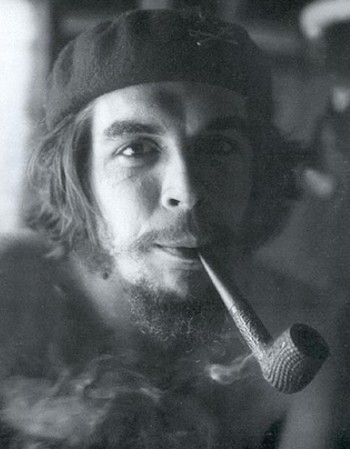 Guevara at his guerrilla base in the Escambray Mountains Although he maintained a demanding and harsh disposition, Guevara also viewed his role of commander as one of a teacher, entertaining his men during breaks between engagements with readings from the likes of Robert Louis Stevenson, Miguel de Cervantes, and Spanish lyric poets.[99] Together with this role, and inspired by José Martí's principle of "literacy without borders", Guevara further ensured that his rebel fighters made daily time to teach the uneducated campesinos with whom they lived and fought to read and write, in what Guevara termed the "battle against ignorance".[92] Tomás Alba, who fought under Guevara's command, later stated that "Che was loved, in spite of being stern and demanding. We would (have) given our life for him."[100] His commanding officer, Fidel Castro, described Guevara as intelligent, daring, and an exemplary leader who "had great moral authority over his troops".[101] Castro further remarked that Guevara took too many risks, even having a "tendency toward foolhardiness".[102] Guevara's teenage lieutenant, Joel Iglesias, recounts such actions in his diary, noting that Guevara's behavior in combat even brought admiration from the enemy. On one occasion Iglesias recounts the time he had been wounded in battle, stating "Che ran out to me, defying the bullets, threw me over his shoulder, and got me out of there. The guards didn't dare fire at him ... later they told me he made a great impression on them when they saw him run out with his pistol stuck in his belt, ignoring the danger, they didn't dare shoot."[103] Guevara was instrumental in creating the clandestine radio station Radio Rebelde (Rebel Radio) in February 1958, which broadcast news to the Cuban people with statements by 26 July movement, and provided radiotelephone communication between the growing number of rebel columns across the island. Guevara had apparently been inspired to create the station by observing the effectiveness of CIA supplied radio in Guatemala in ousting the government of Jacobo Árbenz Guzmán.[104] To quell the rebellion, Cuban government troops began executing rebel prisoners on the spot, and regularly rounded up, tortured, and shot civilians as a tactic of intimidation.[105] By March 1958, the continued atrocities carried out by Batista's forces led the United States to stop selling arms to the Cuban government.[93] Then, in late July 1958, Guevara played a critical role in the Battle of Las Mercedes by using his column to halt a force of 1,500 men called up by Batista's General Cantillo in a plan to encircle and destroy Castro's forces. Years later, Major Larry Bockman of the United States Marine Corps analyzed and described Che's tactical appreciation of this battle as "brilliant".[106] During this time Guevara also became an "expert" at leading hit-and-run tactics against Batista's army, and then fading back into the countryside before the army could counterattack.[107] |
指揮官としての役割 副司令官として、ゲバラは厳格な規律主義者であり、脱走者を射殺することさえあった。脱走者は反逆者として処罰され、ゲバラは任務放棄を企てる者たちを捜 索する部隊を派遣することで知られていた。[94] その結果、ゲバラは残虐さと冷酷さで恐れられるようになった。[95] ゲリラ戦中、ゲバラはスパイ、脱走兵、またはスパイの容疑をかけられた複数の男性に対する即決処刑にも責任を負っていた。[96] ゲバラの日記には、最初のそのような処刑の記録がある。対象は、カストロ派ゲリラの案内役を務めていた農民のエウティミオ・ゲラで、キューバ空軍の攻撃の ために反乱軍の位置を繰り返し漏らした見返りに1万ペソの約束を受けたことを自白した。[97] この情報は、バティスタ軍が革命に同情する農民の自宅を焼くのに利用された。[97] ゲラが「早く自分の命を終わらせてくれ」と頼んだところ[97]、チェは前に出て彼の頭を撃ち、次のように書いた。「この状況は、人民にとってもエウティ ミオにとっても不快だったので、私は彼を右側の脳に 32 口径の拳銃で撃ち、右側頭葉から弾丸を抜け出させて、この問題を解決した。[98] 彼の科学的記録と事実を淡々と記述した説明は、ある伝記作家に「戦争のその時点での暴力に対する驚くべき冷静さ」を示唆した。[98] 後にゲバラは、この事件を文学的に描いた『裏切者の死』を出版し、エウティミオの裏切りと処刑前の「革命が私の子供たちを守ってくれ」という願いを、「犠 牲を通じた贖罪の革命的寓話」へと変容させた。[98]  エスカンブレイ山脈のゲリラ基地にいるゲバラ ゲバラは、厳格で厳しい性格を維持していたものの、指揮官としての役割を教師としての役割とも考えており、戦闘の合間には、ロバート・ルイス・スティーブ ンソン、ミゲル・デ・セルバンテス、スペインの叙情詩人などの作品を読んで部下たちを楽しませた。[99] この役割と、ホセ・マルティの「国境のない識字教育」の原則に触発されて、ゲバラはさらに、反乱軍兵士たちが、共に暮らし、共に戦う教育を受けていない農 民たちに、読み書きを教える時間を毎日確保するよう徹底した。ゲバラはこれを「無知との戦い」と呼んでいた。[92] グエバラの指揮下で戦ったトマス・アルバは、後に「チェは厳格で要求が厳しい人物でしたが、愛されていました。私たちは彼のために命を捧げてもよかった」 と述べています。[100] 彼の指揮官であったフィデル・カストロは、グエバラを「知性にあふれ、大胆で、部隊に対して大きな道徳的権威を持つ」模範的な指導者と評しています。 [101] カストロはさらに、ゲバラはリスクを冒しすぎ、甚至「無謀な傾向があった」と指摘している。[102] ゲバラの少年時代の副官、ホエル・イグレシアスは日記に、ゲバラの戦闘中の行動が敵からも称賛されたと記している。ある時、イグレシアスは戦闘で負傷した 時のことを次のように述べています。「チェは弾丸を無視して私の方へ駆け寄り、私を肩に担ぎ上げ、その場から連れ出した。警備兵たちは彼に発砲する勇気が なかった……後で彼らは、彼がベルトに拳銃を差し込んだまま危険を無視して駆け出すのを見て、彼に大きな印象を受けたと言った。」[103] ゲバラは、1958年2月に秘密のラジオ局「ラジオ・レベルデ(反乱軍ラジオ)」の設立に尽力し、7月26日運動の声明とともにキューバ国民にニュースを 放送し、島内で増加する反乱軍部隊間の無線電話通信を確保した。ゲバラは、CIAがグアテマラでヤコボ・アルベンツ・グスマン政権の打倒に効果があったラ ジオを観察し、その効果に感銘を受けてこのラジオ局を設立したらしい。[104] 反乱を鎮圧するため、キューバ政府軍は反乱軍の捕虜をその場で処刑し、威嚇手段として民間人を定期的に一斉検挙、拷問、銃殺した。[105] 1958年3月までに、バティスタ軍による残虐行為が続き、米国はキューバ政府への武器販売を停止した。[93] その後、1958年7月下旬、ゲバラはラス・メルセデス戦において、バティスタのカンティロ将軍がカストロの部隊を包囲・破壊する計画で動員した 1,500人の部隊を、自身の部隊で阻止する重要な役割を果たした。数年後にアメリカ海兵隊のラリー・ボックマン大佐は、この戦いのゲバラの戦術的判断を 「 brillant( brillant)」と分析し、記述した。[106] この時期、ゲバラはバティスタ軍に対する奇襲戦術の「専門家」となり、軍が反撃する前に農村部へ撤退する戦術を確立した。[107] |
| Final offensive Main article: Battle of Santa Clara 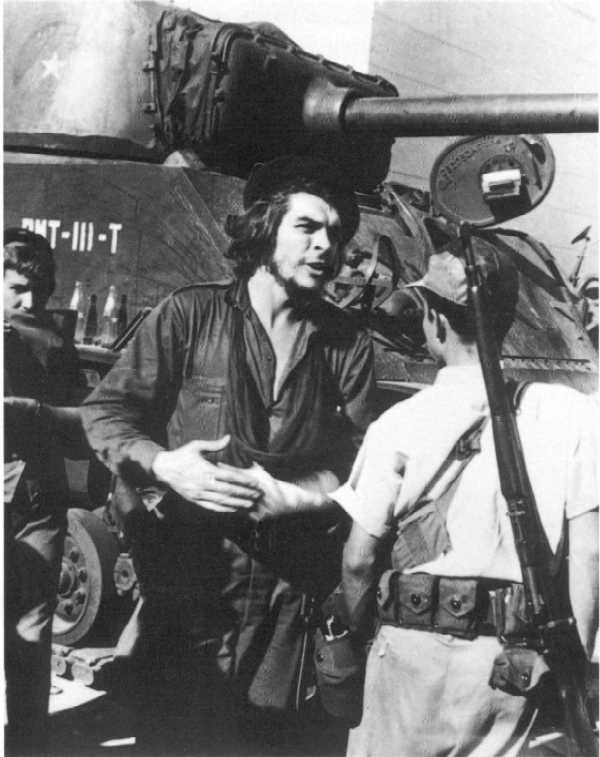 After the Battle of Santa Clara, 1 January 1959 As the war extended, Guevara led a new column of fighters dispatched westward for the final push towards Havana. Travelling by foot, Guevara embarked on a difficult 7-week march, only travelling at night to avoid an ambush and often not eating for several days.[108] In the closing days of December 1958, Guevara's task was to cut the island in half by taking Las Villas province. In a matter of days he executed a series of "brilliant tactical victories" that gave him control of all but the province's capital city of Santa Clara.[108] Guevara then directed his "suicide squad" in the attack on Santa Clara, which became the final decisive military victory of the revolution.[109][110] In the six weeks leading up to the battle, there were times when his men were completely surrounded, outgunned, and overrun. Che's eventual victory despite being outnumbered 10:1 remains in the view of some observers a "remarkable tour de force in modern warfare".[111] Radio Rebelde broadcast the first reports that Guevara's column had taken Santa Clara on New Year's Eve 1958. This contradicted reports by the heavily controlled national news media, which had at one stage reported Guevara's death during the fighting. At 3 am on 1 January 1959, upon learning that his generals were negotiating a separate peace with Guevara, Fulgencio Batista boarded a plane in Havana and fled for the Dominican Republic, along with an amassed "fortune of more than $300,000,000 through graft and payoffs".[112] The following day on 2 January, Guevara entered Havana to finally take control of the capital.[113] Fidel Castro took six more days to arrive, as he stopped to rally support in several large cities on his way to rolling victoriously into Havana on 8 January 1959. The final death toll from the two years of revolutionary fighting was 2,000 people.[114] |
最終攻勢 詳細記事:サンタ・クララの戦い  1959年1月1日、サンタ・クララの戦い後 戦争が長期化する中、ゲバラはハバナへの最終攻勢のため、西へ派遣された新たな戦闘部隊を率いた。徒歩で移動したゲバラは、待ち伏せを避けるため夜間にの み進軍し、数日間食事を摂らないこともあった困難な7週間の行軍を開始した。[108] 1958年12月下旬、ゲバラの任務はラス・ビジャス州を制圧し、島を二分することだった。数日のうちに、彼は「見事な戦術的勝利」を連発し、州都サン タ・クララを除く全地域を制圧した。[108] グエバラはその後、サンタ・クララ攻撃に「自殺部隊」を指揮し、これが革命の最終的な決定的な軍事的勝利となった。[109][110] 戦闘前の6週間には、彼の部隊が完全に包囲され、兵力でも圧倒され、制圧される状況があった。チェが10対1の兵力差を覆して勝利を収めたことは、一部の 観察者からは「現代戦における驚くべき戦術的傑作」と評価されている。[111] ラジオ・レベルデは、1958 年の大晦日にゲバラの部隊がサンタ・クララを占領したという最初の報道を放送した。これは、厳重に統制された全国ニュースメディアの報道と矛盾していた。 全国ニュースメディアは、ある時点で、戦闘中にゲバラが死亡したと報じていた。1959年1月1日午前3時、将軍たちがゲバラと単独和平交渉を行っている ことを知ったフルヘンシオ・バティスタは、ハバナから飛行機でドミニカ共和国へ逃亡した。彼は賄賂と賄賂で蓄えた「3億ドルを超える財産」を携えていた。 [112] 翌1月2日、ゲバラはハバナに入り、ついに首都の支配権を握った。[113] フィデル・カストロは、1959年1月8日にハバナに勝利して入城するまでに、いくつかの大都市で支持を固めるために立ち寄り、到着までにさらに6日間を 要した。2年にわたる革命戦争の最終的な死者数は2,000人にのぼった。[114] |
| Political career in Cuba Further information: Consolidation of the Cuban Revolution Revolutionary tribunals 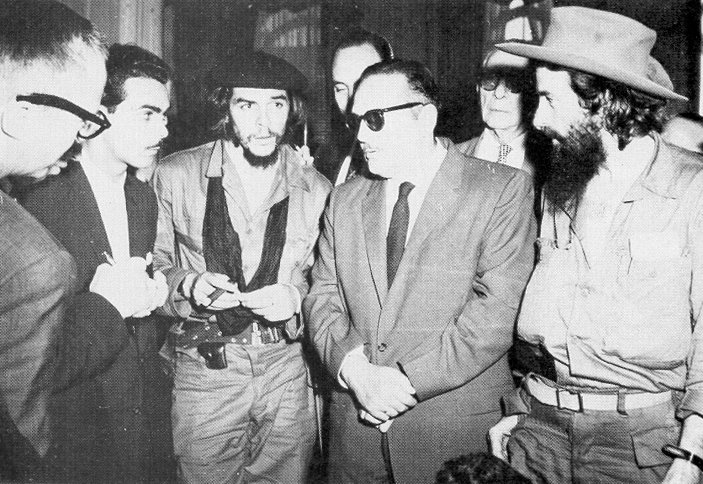 (Right to left) rebel leader Camilo Cienfuegos, Cuban President Manuel Urrutia Lleó, and Guevara (January 1959) The first major political crisis arose over what to do with the captured Batista officials who had perpetrated the worst of the repression.[115] During the rebellion against Batista's dictatorship, the general command of the rebel army, led by Fidel Castro, introduced into the territories under its control the 19th-century penal law commonly known as the Ley de la Sierra (Law of the Sierra).[116] This law included the death penalty for serious crimes, whether perpetrated by the Batista regime or by supporters of the revolution. In 1959, the revolutionary government extended its application to the whole of the republic and to those it considered war criminals, captured and tried after the revolution. According to the Cuban Ministry of Justice, this latter extension was supported by the majority of the population, and followed the same procedure as those in the Nuremberg trials held by the Allies after World War II.[117] To implement a portion of this plan, Castro named Guevara commander of the La Cabaña Fortress prison for a five-month tenure (2 January through 12 June 1959).[118] Guevara was charged by the new government with purging the Batista army and consolidating victory by exacting "revolutionary justice" against those regarded as traitors, chivatos (informants) or war criminals.[119] As commander of La Cabaña, Guevara reviewed the appeals of those convicted during the revolutionary tribunal process.[11] The tribunals were conducted by 2–3 army officers, an assessor, and a respected local citizen.[120] On some occasions, the penalty delivered by the tribunal was death by firing-squad.[121] Raúl Gómez Treto, senior legal advisor to the Cuban Ministry of Justice, has argued that the death penalty was justified in order to prevent citizens themselves from taking justice into their own hands, as had happened twenty years earlier in the anti-Machado rebellion.[122] Biographers note that in January 1959 the Cuban public was in a "lynching mood",[123] and point to a survey at the time showing 93% public approval for the tribunal process.[11] 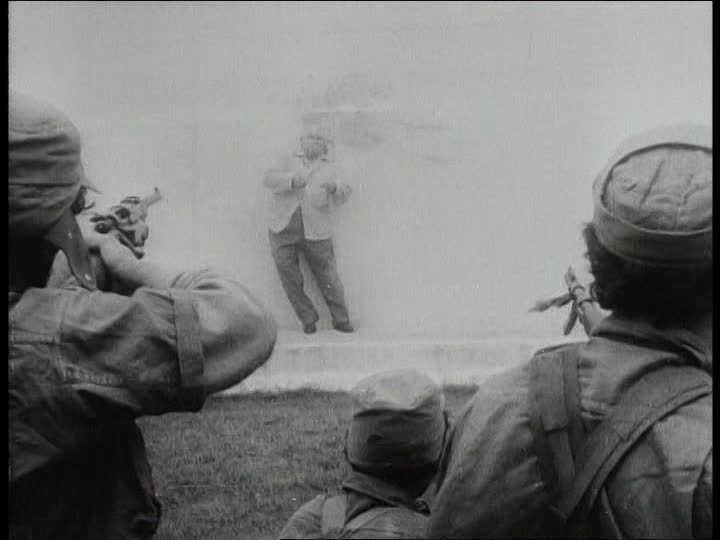 Televised execution of Colonel Rojas, ordered by Che Guevara. (7 January 1959). One of the first public executions ordered by Guevara was the execution of Colonel Rojas, which was broadcast on Cuban television. Colonel Rojas was the chief of police in Santa Clara, whose officers had held out against the rebels until the last moment of fighting during the Battle of Santa Clara. After his capture, Rojas' family received a letter of safe departure, inferring he'd be kept alive and released. Soon afterwards, Guevara ordered Rojas to be executed on 7 January 1959. When the footage was aired on television, Rojas' family was at first relieved to see him alive, but after realizing he was being placed in front of a firing squad, they began to scream as he was then shot. The footage was later broadcast around the world, becoming one of the first killings ever aired on television.[124][125] On 22 January 1959, a Universal Newsreel broadcast in the United States narrated by Ed Herlihy featured Fidel Castro asking an estimated one million Cubans whether they approved of the executions, and being met with a roaring "¡Sí!" (yes).[126] With between 1,000[127] and 20,000 Cubans estimated to have been killed at the hands of Batista's collaborators,[128][129][130][131] and many of the accused war criminals sentenced to death accused of torture and physical atrocities,[11] the newly empowered government carried out executions, punctuated by cries from the crowds of "¡al paredón!" ([to the] wall!),[115] which biographer Jorge Castañeda describes as "without respect for due process".[132] |
キューバでの政治活動 詳細情報:キューバ革命の統合 革命裁判所  (右から左)反乱軍の指導者カミーロ・シエンフエゴス、キューバ大統領マヌエル・ウルティア・レオ、ゲバラ(1959年1月) 最初の大きな政治危機は、最悪の弾圧を行ったバティスタ政権の捕虜となった高官たちの処分をめぐって生じた。[115] バティスタ独裁政権に対する反乱中、フィデル・カストロ率いる反乱軍の総司令部は、その支配下にある地域に19世紀の刑法である「シエラ法」(Ley de la Sierra)を導入した。[116] この法律には、バティスタ政権によって犯された犯罪か、革命支持者によって犯された犯罪かを問わず、重大な犯罪に対する死刑が規定されていた。1959 年、革命政府はこの法の適用を共和国全土に拡大し、革命後に捕らえられ裁判にかけられた戦争犯罪者と見なされた者にも適用した。キューバ司法省によると、 この拡大措置は国民の過半数の支持を得ており、第二次世界大戦後に連合国がニュルンベルク裁判で採用した手続きと同様の手続きに従った。[117] この計画の一部を実施するため、カストロはゲバラをラ・カバニャ要塞刑務所の司令官に任命し、5ヶ月間の任期(1959年1月2日から6月12日)を付与 した。[118] 新政府はゲバラに、バティスタ軍を粛清し、裏切り者、チバトス(密告者)、または戦争犯罪者と見なされた者に対して「革命的正義」を執行することで勝利を 固める任務を課した。[119] ラ・カバニャの司令官として、ゲバラは革命裁判所で有罪判決を受けた者の上訴を審査した。[11] 裁判は、2~3人の軍人、1人の評議委員、および尊敬される地元住民によって行われた。[120] いくつかのケースでは、裁判所の判決は銃殺刑だった。[121] キューバ司法省の首席法務顧問だったラウル・ゴメス・トレトは、20年前に反マチャド反乱で起きたように、市民が自警団を結成して正義を執行するのを防ぐ ため、死刑は正当化されると主張している。[122] 伝記作家たちは、1959年1月、キューバ国民は「リンチ気分」に陥っていたと記し[123]、当時の調査で、93%の国民が裁判所の審理を承認していた ことを指摘している[11]。  チェ・ゲバラの命令によるロハス大佐のテレビ中継された処刑(1959年1月7日)。 ゲバラが命じた最初の公開処刑の一つは、ロハス大佐の処刑で、これはキューバのテレビで放送された。ロハス大佐はサンタクララの警察長官で、サンタクララ 戦いの最後の瞬間まで反乱軍に抵抗した警察官たちを指揮していた。捕らえられた後、ロハスの家族は安全な退去を許可する手紙を受け取り、彼が生き残って釈 放されるものと推測していた。その後間もなく、ゲバラはロハスを1959年1月7日に処刑するよう命じた。テレビで映像が放送された際、ロハスの家族は彼 が生きているのを見て最初は安堵したが、彼が銃殺隊の前に立たされていることに気づくと、彼が射殺されるのを見て叫び始めた。この映像は後に世界中に放送 され、テレビで放送された最初の殺害の一つとなった。[124][125] 1959年1月22日、アメリカ合衆国で放送されたユニバーサル・ニュースリール(ナレーター:エド・ハーリヒ)では、フィデル・カストロが推定100万 人のキューバ人に処刑を承認するかどうか尋ね、激しい「¡Sí!」(はい)という返答が返ってくる様子が放送された。[126] バティスタの協力者によって殺害されたキューバ人は1,000人[127]から20,000人と推定され、[128][129][130][131] 拷問や身体的残虐行為の罪で死刑判決を受けた戦争犯罪容疑者の多く[11]に対し、新政権は処刑を実施した。群衆から「¡al paredón!」(壁へ!)という叫び声が響き渡り[115]、伝記作家ホルヘ・カステニャーダはこれを「適正手続きを無視した」と記述している [132]。 |
| I have yet to find a single
credible source pointing to a case where Che executed "an innocent".
Those persons executed by Guevara or on his orders were condemned for
the usual crimes punishable by death at times of war or in its
aftermath: desertion, treason or crimes such as rape, torture or
murder. I should add that my research spanned five years, and included
anti-Castro Cubans among the Cuban-American exile community in Miami
and elsewhere. —Jon Lee Anderson, author of Che Guevara: A Revolutionary Life, PBS forum[133] Although accounts vary, it is estimated that several hundred people were executed nationwide during this time, with Guevara's jurisdictional death total at La Cabaña ranging from 55 to 105.[134] Conflicting views exist of Guevara's attitude towards the executions at La Cabaña. Some exiled opposition biographers report that he relished the rituals of the firing squad, and organized them with gusto, while others relate that Guevara pardoned as many prisoners as he could.[132] All sides acknowledge that Guevara had become a "hardened" man who had no qualms about the death penalty or about summary and collective trials. If the only way to "defend the revolution was to execute its enemies, he would not be swayed by humanitarian or political arguments".[132] In a 5 February 1959 letter to Luis Paredes López in Buenos Aires, Guevara states unequivocally: "The executions by firing squads are not only a necessity for the people of Cuba, but also an imposition of the people."[135] |
チェが「無実の人」を処刑したという事例を指摘する、信頼できる情報源
は、私はまだ1つも見つけていない。ゲバラによって、あるいは彼の命令によって処刑された人々は、戦争中や戦後において死刑に処せられる通常の犯罪、すな
わち脱走、反逆、あるいは強姦、拷問、殺人などの犯罪で有罪判決を受けた者たちだった。私の調査は5年間に及び、マイアミやその他の地域のキューバ系アメ
リカ人亡命者コミュニティのうち、反カストロ派も対象としたことを付け加えておく。 —ジョン・リー・アンダーソン、『チェ・ゲバラ:革命の人生』著者、PBS フォーラム[133] 報告はさまざまであるが、この間に全国で数百人が処刑され、ゲバラの管轄下にあるラ・カバニャでの処刑者数は 55 人から 105 人に上ると推定されている[134]。ラ・カバニャでの処刑に対するゲバラの態度については、さまざまな見解がある。亡命中の反体制派の伝記作家たちは、 ゲバラは銃殺の儀礼を喜び、熱意をもってそれを組織したと報告している。一方、ゲバラはできるだけ多くの囚人を赦免したと伝える者もいる[132]。すべ ての関係者は、ゲバラが死刑や即決裁判、集団裁判について何の良心の呵責も感じない「冷酷な」人物になっていたことを認めている。「革命を守る唯一の手段 が敵を処刑することであるならば、彼は人道的あるいは政治的議論に左右されることはなかっただろう」[132]。1959年2月5日、ブエノスアイレスの ルイス・パレデス・ロペス宛ての手紙の中で、ゲバラは「銃殺による処刑は、キューバ国民にとって必要なだけでなく、国民が課した義務でもある」と明確に述 べている[135]。 |
| Early political office Further information: Agrarian reforms in Cuba, Huber Matos affair, and La Coubre explosion In mid-January 1959, Guevara went to live at a summer villa in Tarará to recover from a violent asthma attack.[136] While there he started the Tarará Group, a group that debated and formed the new plans for Cuba's social, political, and economic development.[137] In addition, Che began to write his book Guerrilla Warfare while resting at Tarara.[137] In February, the revolutionary government proclaimed Guevara "a Cuban citizen by birth" in recognition of his role in the triumph.[138] When Hilda Gadea arrived in Cuba in late January, Guevara told her that he was involved with another woman, and the two agreed on a divorce,[139] which was finalized on 22 May.[140] On 27 January 1959, Guevara made one of his most significant speeches where he talked about "the social ideas of the rebel army". During this speech he declared that the main concern of the new Cuban government was "the social justice that land redistribution brings about".[141] A few months later, 17 May 1959, the agrarian reform law, crafted by Guevara, went into effect, limiting the size of all farms to 1,000 acres (400 ha). Any holdings over these limits were expropriated by the government and either redistributed to peasants in 67-acre (270,000 m2) parcels or held as state-run communes.[142] The law also stipulated that foreigners could not own Cuban sugar-plantations.[143] 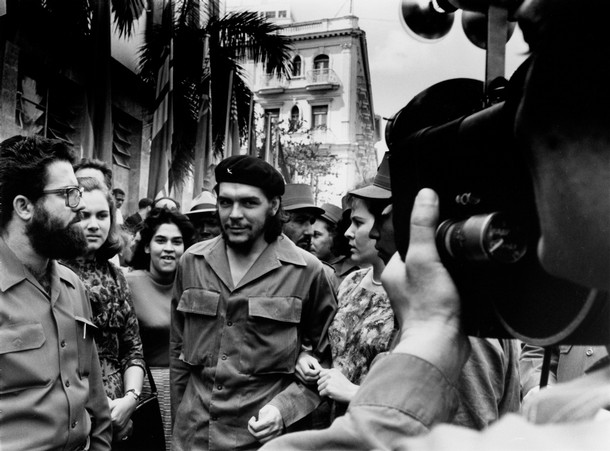 Guevara in 1960, walking through the streets of Havana with his second wife Aleida March (right) On 2 June 1959, he married Aleida March, a Cuban-born member of 26 July movement with whom he had been living since late 1958. Guevara returned to the seaside village of Tarara in June for his honeymoon with Aleida.[144] A civil ceremony was held at La Cabaña military fortress.[145] In total, Guevara would have five children from his two marriages.[146] 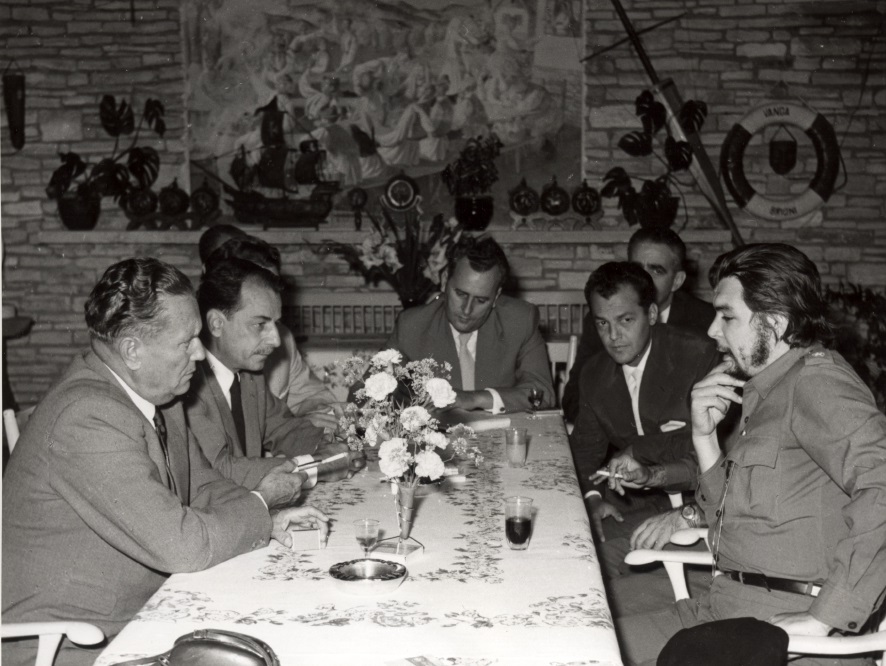 Che Guevara meeting Josip Broz Tito, during Guevara's 1959 diplomatic travels. 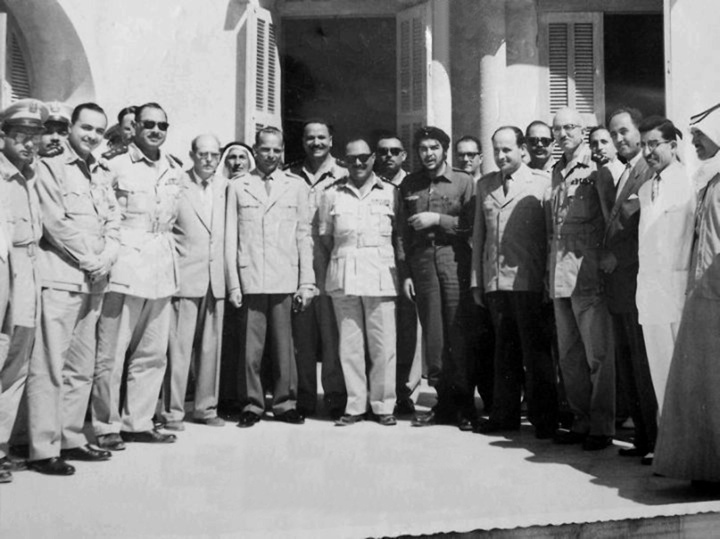 Che Guevara visiting Gaza during his diplomatic tour. (1959) On 12 June 1959, Castro sent Guevara out on a three-month tour of mostly Bandung Pact countries (Morocco, Sudan, Egypt, Syria, Pakistan, India, Sri Lanka, Burma, Thailand, Indonesia, Japan, Yugoslavia, and Greece) and the cities of Singapore and Hong Kong.[147] Sending Guevara away from Havana allowed Castro to appear to distance himself from Guevara and his Marxist sympathies, which troubled both the United States and some of the members of Castro's 26 July Movement.[148] While in Jakarta, Guevara visited Indonesian president Sukarno to discuss the recent revolution of 1945–1949 in Indonesia and to establish trade relations between their two countries. The two men quickly bonded, as Sukarno was attracted to Guevara's energy and his relaxed informal approach; moreover they shared revolutionary leftist aspirations against Western imperialism.[149] Guevara next spent 12 days in Japan (15–27 July), participating in negotiations aimed at expanding Cuba's trade relations with that country. During the visit he refused to visit and lay a wreath at Japan's Tomb of the Unknown Soldier commemorating soldiers lost during World War II, remarking that the Japanese "imperialists" had "killed millions of Asians".[150] Instead, Guevara stated that he would visit Hiroshima, where the American military had detonated an atomic bomb 14 years earlier.[150] Despite his denunciation of Imperial Japan, Guevara considered President Truman a "macabre clown" for the bombings,[151] and after visiting Hiroshima and its Peace Memorial Museum he sent back a postcard to Cuba stating, "In order to fight better for peace, one must look at Hiroshima."[152] Upon Guevara's return to Cuba in September 1959, it became evident that Castro now had more political power. The government had begun land seizures in accordance with the agrarian reform law, but was hedging on compensation offers to landowners, instead offering low-interest "bonds", a step which put the United States on alert. At this point the affected wealthy cattlemen of Camagüey mounted a campaign against the land redistributions and enlisted the newly disaffected rebel leader Huber Matos, who along with the anti-communist wing of the 26 July Movement, joined them in denouncing "communist encroachment".[153] During this time Dominican dictator Rafael Trujillo was offering assistance to the "Anti-Communist Legion of the Caribbean" which was training in the Dominican Republic. This multi-national force, composed mostly of Spaniards and Cubans, but also of Croatians, Germans, Greeks, and right-wing mercenaries, was plotting to topple Castro's new regime.[153] At this stage, Guevara acquired the additional position of Minister of Finance, as well as President of the National Bank.[154] These appointments, combined with his existing position as Minister of Industries, placed Guevara at the zenith of his power, as the "virtual czar" of the Cuban economy.[155] As a consequence of his position at the head of the central bank, it became Guevara's duty to sign the Cuban currency, which per custom bore his signature. Instead of using his full name, he signed the bills solely "Che".[156] It was through this symbolic act, which horrified many in the Cuban financial sector, that Guevara signaled his distaste for money and the class distinctions it brought about.[156] Guevara's long time friend Ricardo Rojo later remarked that "the day he signed Che on the bills, (he) literally knocked the props from under the widespread belief that money was sacred."[157] International threats were heightened when, on 4 March 1960, two massive explosions ripped through the French freighter La Coubre, which was carrying Belgian munitions from the port of Antwerp, and was docked in Havana Harbor. The blasts killed at least 76 people and injured several hundred, with Guevara personally providing first aid to some of the victims. Fidel Castro immediately accused the CIA of "an act of terrorism" and held a state funeral the following day for the victims of the blast.[158] At the memorial service Alberto Korda took the famous photograph of Guevara, now known as Guerrillero Heroico.[159] Perceived threats prompted Castro to eliminate more "counter-revolutionaries" and to utilize Guevara to drastically increase the speed of land reform. To implement this plan, a new government agency, the National Institute of Agrarian Reform (INRA), was established by the Cuban government to administer the new agrarian reform law. INRA quickly became the most important governing body in the nation, with Guevara serving as its head in his capacity as minister of industries.[143][need quotation to verify] Under Guevara's command, INRA established its own 100,000-person militia, used first to help the government seize control of the expropriated land and supervise its distribution, and later to set up cooperative farms. The land confiscated included 480,000 acres (190,000 ha) owned by United States corporations.[143] Months later, in retaliation, US President Dwight D. Eisenhower sharply reduced United States imports of Cuban sugar (Cuba's main cash crop), which led Guevara on 10 July 1960 to address over 100,000 workers in front of the Presidential Palace at a rally to denounce the "economic aggression" of the United States.[155] Time Magazine reporters who met with Guevara around this time described him as "guid(ing) Cuba with icy calculation, vast competence, high intelligence, and a perceptive sense of humor".[10] |
初期の政治活動 詳細情報:キューバの農業改革、ウーバー・マトス事件、ラ・クブレ号爆発事件 1959年1月中旬、ゲバラは激しい喘息の発作から回復するため、タララの別荘で療養生活を送った[136]。その間、彼はキューバの社会、政治、経済の 発展に関する新しい計画について議論し、策定する「タララ・グループ」を設立した。[137] さらに、ゲバラはタララで休養中に『ゲリラ戦』の執筆を開始した。[137] 2月、革命政府はゲバラの勝利への貢献を認め、彼を「生まれながらのキューバ市民」と宣言した。[138] 1月下旬、ヒルダ・ガデアがキューバに到着したとき、ゲバラは彼女に別の女性との関係を打ち明け、2人は離婚に合意した[139]、そして5月22日に離 婚が成立した[140]。 1959年1月27日、ゲバラは「反乱軍の社会思想」について語った、最も重要な演説のひとつを行った。この演説で彼は、新キューバ政府の主要な課題は 「土地の再分配がもたらす社会正義」だと宣言した。[141] 数ヶ月後の1959年5月17日、ゲバラが策定した農業改革法が施行され、すべての農場の規模が1,000エーカー(400ヘクタール)に制限された。こ の制限を超える土地は政府によって接収され、67エーカー(270,000平方メートル)の区画に小作農に再分配されるか、国家管理の共同体として保有さ れた。[142] また、この法律は外国人によるキューバの砂糖プランテーションの所有を禁止した。[143]  1960年、ハバナの街を2番目の妻アレイダ・マルチ(右)と歩くゲバラ 1959年6月2日、ゲバラは1958年末から同棲していた、7月26日運動のメンバーでキューバ生まれのアレイダ・マルチと結婚した。ゲバラはアレイダ との新婚旅行のため、6月に海辺の村タララに戻った。[144] 市民結婚式はラ・カバニャ軍事要塞で行われた。[145] グエバラは2回の結婚で合計5人の子供を残した。[146]  1959年の外交旅行中に、ヨシップ・ブロズ・ティトと会うチェ・ゲバラ。  外交旅行中にガザを訪問するチェ・ゲバラ(1959年)。 1959年6月12日、カストロはゲバラを3ヶ月間の旅行に派遣した。主にバンドン協定加盟国(モロッコ、スーダン、エジプト、シリア、パキスタン、イン ド、スリランカ、ビルマ、タイ、インドネシア、日本、ユーゴスラビア、ギリシャ)とシンガポール、香港の都市を訪問した。[147] ゲバラをハバナから遠ざけることで、カストロはゲバラと彼のマルクス主義的傾向から距離を置いているように見せることができ、これは米国とカストロの 7 月 26 日運動の一部のメンバーを不安にさせた。[148] ジャカルタ滞在中、ゲバラはインドネシアのスカルノ大統領を訪問し、1945年から1949年にかけてのインドネシアの革命について話し合い、両国の貿易 関係の確立について協議した。二人はすぐに意気投合した。スカルノはゲバラのエネルギーとリラックスした非公式な態度に惹かれた上、西欧帝国主義に対する 革命的な左翼的志向を共有していたからだ。[149] ゲバラは次に日本(7月15日から27日)で12日間を過ごし、キューバと日本の貿易関係を拡大するための交渉に参加した。訪問中、ゲバラは第二次世界大 戦中の戦没者を追悼する日本の「無名戦士の墓」を訪問し、花輪を献花することを拒否し、日本の「帝国主義者」が「数百万のアジア人を殺した」と述べた。 [150] 代わりに、ゲバラは14年前にアメリカ軍が原子爆弾を投下した広島を訪問すると表明した。[150] 帝国日本を非難したにもかかわらず、ゲバラは原爆投下についてトルーマン大統領を「不気味な道化師」と批判した。[151] 広島と平和記念博物館を訪問した後、キューバに送ったポストカードには「平和のために戦うためには、広島を見なければならない」と記した。[152] ゲバラが1959年9月にキューバに戻った際、カストロがより大きな政治権力を握っていることが明らかになった。政府は農業改革法に基づき土地の接収を開 始したが、土地所有者への補償額を保留し、代わりに低金利の「債券」を提示した。この措置はアメリカを警戒させた。この時点で、カマグエイの富裕な牧場主 たちは土地再分配に反対するキャンペーンを展開し、新たに不満を抱くようになった反乱指導者フベルト・マトスを招き入れた。マトスは、7月26日運動の反 共産主義派と共に、彼らと共に「共産主義の侵食」を非難した。[153] この間、ドミニカ共和国の独裁者ラファエル・トルヒーリョは、ドミニカ共和国で訓練を行っていた「カリブ反共産主義軍」に支援を申し出ていました。この多 国籍軍は、主にスペイン人とキューバ人で構成されていましたが、クロアチア人、ドイツ人、ギリシャ人、右翼の傭兵も参加しており、カストロの新政権の打倒 を企てていたのです。[153] この段階で、ゲバラは財務大臣と国立銀行総裁の職も兼任することになった[154]。これらの任命と、それまでの産業大臣の職を合わせると、ゲバラは キューバ経済の「事実上の最高責任者」として、権力の絶頂に立つことになった。[155] 中央銀行のトップとしての立場から、ゲバラはキューバの通貨に署名する義務を負った。伝統的に通貨には署名が必要だったため、彼は本名ではなく「チェ」と だけ署名した。[156] この象徴的な行為は、キューバの金融界を震撼させた。ゲバラはこれにより、金銭とそれがもたらす階級差別への嫌悪を表明した。[156] ゲバラの長い友人であるリカルド・ロホは後年、「彼が紙幣に『チェ』と署名した日、彼は『お金は神聖なものだ』という広まった信念の土台を文字通り崩し た」と述べた。[157] 国際的な脅威は、1960年3月4日、アントワープ港からベルギーの弾薬を積載し、ハバナ港に停泊中のフランス籍貨物船「ラ・クブル」が2度の巨大な爆発 で破壊されたことで高まった。この爆発により、少なくとも 76 人が死亡、数百人が負傷し、ゲバラは自ら一部の犠牲者に応急処置を施した。フィデル・カストロは直ちに CIA を「テロ行為」と非難し、翌日、爆発の犠牲者のために国葬を行った。[158] 追悼式で、アルベルト・コルダは、現在「ゲリラの英雄」として知られるゲバラの有名な写真を撮影した。[159] 脅威を認識したカストロは、より多くの「反革命分子」を排除し、ゲバラを利用して土地改革のスピードを大幅に加速させることを決定した。この計画を実施す るため、キューバ政府は、新しい土地改革法を施行するための新しい政府機関、国家土地改革研究所(INRA)を設立した。INRA は、ゲバラが産業大臣として所長を務め、すぐに国民にとって最も重要な統治機関となった。[143][要出典] ゲバラの指揮の下、INRA は 10 万人規模の民兵組織を設立し、当初は政府が収用した土地の支配権を確保し、その分配を監督するために活用され、後に協同組合農場を設立するために活用され た。没収された土地には、米国企業が所有していた 48 万エーカー(19 万ヘクタール)も含まれていた。[143] 数ヶ月後、報復措置として、ドワイト・D・アイゼンハワー米国大統領は、キューバの主要現金作物である砂糖の米国への輸入を大幅に削減した。これにより、 1960年7月10日、ゲバラは大統領官邸前で10万人以上の労働者を前に演説し、米国の「経済侵略」を非難した。[155] この頃ゲバラと会ったタイム誌の記者たちは、彼を「冷徹な計算、広範な能力、高い知性、そして鋭いユーモアのセンスでキューバを導いている」と描写した。 [10] |
| Guevara was like a father to me
... he educated me. He taught me to think. He taught me the most
beautiful thing which is to be human. —Urbano (a.k.a. Leonardo Tamayo), fought with Guevara in Cuba and Bolivia[160] Along with land reform, Guevara stressed the need for national improvement in literacy. Before 1959 the official literacy rate for Cuba was between 60 and 76%, with educational access in rural areas and a lack of instructors the main determining factors.[161] As a result, the Cuban government at Guevara's behest dubbed 1961 the "year of education" and mobilized over 100,000 volunteers into "literacy brigades", who were then sent out into the countryside to construct schools, train new educators, and teach the predominantly illiterate guajiros (peasants) to read and write.[92][161] Unlike many of Guevara's later economic initiatives, this campaign was "a remarkable success". By the completion of the Cuban literacy campaign, 707,212 adults had been taught to read and write, raising the national literacy rate to 96%.[161] Accompanying literacy, Guevara was also concerned with establishing universal access to higher education. To accomplish this the new regime introduced affirmative action to the universities. While announcing this new commitment, Guevara told the gathered faculty and students at the University of Las Villas that the days when education was "a privilege of the white middle class" had ended. "The University" he said, "must paint itself black, mulatto, worker, and peasant." If it did not, he warned, the people were going to break down its doors "and paint the University the colors they like."[162] |
ゲバラは私にとって父親のような存在だった…彼は私を教育してくれた。彼は私に考えることを教えてくれた。彼は、人間であることの最も美しいことを教えてくれた。 —ウルバノ(別名レオナルド・タマヨ)、 キューバとボリビアでゲバラとともに戦った[160] ゲバラは、土地改革とともに、国民の識字率の向上も重要だと主張した。1959年以前のキューバの公式の識字率は60%から76%で、農村部の教育へのア クセスと教師の不足が主な要因だった[161]。その結果、ゲバラの指示により、キューバ政府は1961年を「教育の年」と宣言し、10万人を超えるボラ ンティアを「識字部隊」に動員。彼らは農村部に派遣され、学校建設、新規教育者の訓練、主に文盲のグアヒロ(農民)への読み書き教育に従事した。[92] [161] ゲバラの後の多くの経済政策とは異なり、このキャンペーンは「目覚ましい成功」を収めた。キューバの識字キャンペーンが完了するまでに、707,212 人の成人が読み書きを習得し、国民の識字率は 96% に上昇した[161]。 識字教育と並行して、ゲバラは高等教育の普遍的なアクセス確立にも力を入れた。この目標を達成するため、新政権は大学にアファーマティブ・アクションを導 入した。この新たな取り組みを発表するにあたり、ゲバラはラス・ヴィラス大学に集まった教職員と学生たちに、教育が「白人中産階級の特権」であった時代は 終わったと語った。「大学は、黒人、混血、労働者、農民で埋め尽くされなければならない」と彼は述べた。そうしなければ、人民が大学の扉を壊して「大学を 好きな色に塗り替える」だろうと警告した。[162] |
| Economic reforms and the "New Man" See also: Guanahacabibes camp In September 1960, when Guevara was asked about Cuba's ideology at the First Latin American Congress, he replied, "If I were asked whether our revolution is Communist, I would define it as Marxist. Our revolution has discovered by its methods the paths that Marx pointed out."[163] Consequently, when enacting and advocating Cuban policy, Guevara cited the political philosopher Karl Marx as his ideological inspiration. In defending his political stance, Guevara confidently remarked, "There are truths so evident, so much a part of people's knowledge, that it is now useless to discuss them. One ought to be Marxist with the same naturalness with which one is 'Newtonian' in physics, or 'Pasteurian' in biology."[164] According to Guevara, the "practical revolutionaries" of the Cuban Revolution had the goal of "simply fulfill(ing) laws foreseen by Marx, the scientist."[164] Using Marx's predictions and system of dialectical materialism, Guevara professed that "The laws of Marxism are present in the events of the Cuban Revolution, independently of what its leaders profess or fully know of those laws from a theoretical point of view."[164] The merit of Marx is that he suddenly produces a qualitative change in the history of social thought. He interprets history, understands its dynamic, predicts the future, but in addition to predicting it (which would satisfy his scientific obligation), he expresses a revolutionary concept: the world must not only be interpreted, it must be transformed. Man ceases to be the slave and tool of his environment and converts himself into the architect of his own destiny. — Che Guevara, Notes for the Study of the Ideology of the Cuban, October 1960[164] Man truly achieves his full human condition when he produces without being compelled by the physical necessity of selling himself as a commodity. — Che Guevara, Man and Socialism in Cuba[165] |
経済改革と「新人間」 参照:グアナハカビベスキャンプ 1960年9月、ゲバラは第1回ラテンアメリカ会議でキューバのイデオロギーについて尋ねられた際、「私たちの革命が共産主義であるかどうかと尋ねられた 場合、私はそれをマルクス主義と定義するだろう。私たちの革命は、その方法によって、マルクスが指摘した道筋を発見した」と述べた[163]。その結果、 キューバの政策を制定し、提唱する際に、ゲバラは、そのイデオロギー的インスピレーションの源として、政治哲学者カール・マルクスを引用した。ゲバラは、 自らの政治的立場を擁護し、「あまりにも明白で、人々の知識の一部となっている真実がある。物理学で『ニュートン派』であるのと同じように、生物学で『パ スツール派』であるのと同じように、マルクス主義者であるべきだ」と自信を持って述べた。[164] ゲバラによると、キューバ革命の「実践的革命家」の目標は、「科学者マルクスが予見した法則を単に実現すること」であった。[164] マルクスの予測と弁証法的唯物論の体系を用いて、ゲバラは「マルクス主義の法則は、その指導者が理論的にそれらを完全に理解しているかどうか、またはそれ らを公言しているかどうかに関わらず、キューバ革命の出来事の中に存在している」と主張した。[164] マルクスの功績は、社会思想の歴史に質的な変化を突然もたらしたことだ。彼は歴史を解釈し、その動態を理解し、未来を予測するが、予測するだけでなく(こ れは彼の科学的義務を満たすものだ)、革命的な概念を表明する:世界は解釈されるだけでなく、変革されなければならない。人間は、環境の奴隷や道具ではな くなり、自らの運命の建築家へと変貌する。 —チェ・ゲバラ、『キューバのイデオロギーの研究のためのメモ』、1960年10月[164] 人間は、自分自身を商品として売り込むという物理的な必要性に駆られることなく生産を行うときに、真に人間としての完全な状態に達する。 —チェ・ゲバラ、『キューバの人々と社会主義』[165] |
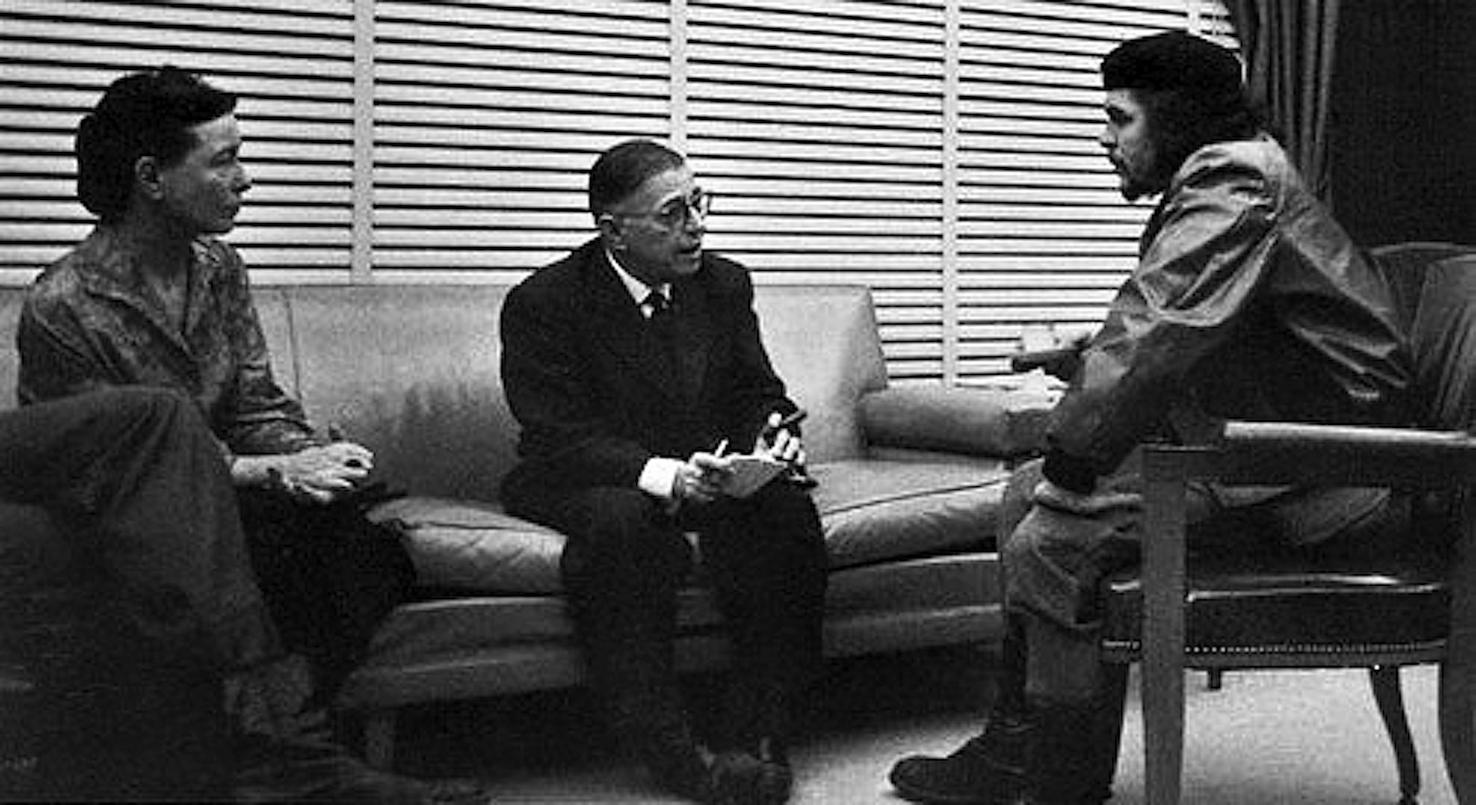 Guevara meeting with French existentialist philosophers Jean-Paul Sartre and Simone de Beauvoir at his office in Havana, March 1960. Sartre later wrote that Che was "the most complete human being of our time". In addition to Spanish, Guevara was fluent in French.[166] In an effort to eliminate social inequalities, Guevara and Cuba's new leadership had moved to swiftly transform the political and economic base of the country through nationalizing factories, banks, and businesses, while attempting to ensure affordable housing, healthcare, and employment for all Cubans.[167] In order for a genuine transformation of consciousness to take root, it was believed that such structural changes had to be accompanied by a conversion in people's social relations and values. Believing that the attitudes in Cuba towards race, women, individualism, and manual labor were the product of the island's outdated past, all individuals were urged to view each other as equals and take on the values of what Guevara termed "el Hombre Nuevo" (the New Man).[167] Guevara hoped his "new man" to be ultimately "selfless and cooperative, obedient and hard working, gender-blind, incorruptible, non-materialistic, and anti-imperialist".[167] To accomplish this, Guevara emphasized the tenets of Marxism–Leninism, and wanted to use the state to emphasize qualities such as egalitarianism and self-sacrifice, at the same time as "unity, equality, and freedom" became the new maxims.[167] Guevara's first desired economic goal of the new man, which coincided with his aversion for wealth condensation and economic inequality, was to see a nationwide elimination of material incentives in favor of moral ones. He negatively viewed capitalism as a "contest among wolves" where "one can only win at the cost of others" and thus desired to see the creation of a "new man and woman".[168] Guevara continually stressed that a socialist economy in itself is not "worth the effort, sacrifice, and risks of war and destruction" if it ends up encouraging "greed and individual ambition at the expense of collective spirit".[169] A primary goal of Guevara's thus became to reform "individual consciousness" and values to produce better workers and citizens.[169] In his view, Cuba's "new man" would be able to overcome the "egotism" and "selfishness" that he loathed and discerned was uniquely characteristic of individuals in capitalist societies.[169] To promote this concept of a "new man", the government also created a series of party-dominated institutions and mechanisms on all levels of society, which included organizations such as labor groups, youth leagues, women's groups, community centers, and houses of culture to promote state-sponsored art, music, and literature. In congruence with this, all educational, mass media, and artistic community based facilities were nationalized and utilized to instill the government's official socialist ideology.[167] In describing this new method of "development", Guevara stated: There is a great difference between free-enterprise development and revolutionary development. In one of them, wealth is concentrated in the hands of a fortunate few, the friends of the government, the best wheeler-dealers. In the other, wealth is the people's patrimony.[170] A further integral part of fostering a sense of "unity between the individual and the mass", Guevara believed, was volunteer work and will. To display this, Guevara "led by example", working "endlessly at his ministry job, in construction, and even cutting sugar cane" on his day off.[171] He was known for working 36 hours at a stretch, calling meetings after midnight, and eating on the run.[169] Such behavior was emblematic of Guevara's new program of moral incentives, where each worker was now required to meet a quota and produce a certain quantity of goods. As a replacement for the pay increases abolished by Guevara, workers who exceeded their quota now only received a certificate of commendation, while workers who failed to meet their quotas were given a pay cut.[169] Guevara unapologetically defended his personal philosophy towards motivation and work, stating: This is not a matter of how many pounds of meat one might be able to eat, or how many times a year someone can go to the beach, or how many ornaments from abroad one might be able to buy with his current salary. What really matters is that the individual feels more complete, with much more internal richness and much more responsibility.[172] At some point in 1960, Guevara ordered the construction of the Guanahacabibes camp: a labor camp to "rehabilitate" his employees who had committed infractions at work. Historians have had difficulty characterizing the camp, because it was extra-legal and thus poorly documented. There is a general consensus that employees worked at the camp to regain their employment after a negative incident, and were under no legal pressure to work at the camp.[173][174] However, the historian Rachel Hynson has theorized that other poorly documented "Guanahacabibes" camps also existed, that were more brutal and legally binding.[175] In the face of a loss of commercial connections with Western states, Guevara tried to replace them with closer commercial relationships with Eastern Bloc states, visiting a number of Marxist states and signing trade agreements with them. At the end of 1960 he visited Czechoslovakia, the Soviet Union, North Korea, Hungary, and East Germany and signed, for instance, a trade agreement in East Berlin on 17 December 1960.[176] Such agreements helped Cuba's economy to a certain degree but also had the disadvantage of a growing economic dependency on the Eastern Bloc. It was also in East Germany where Guevara met Tamara Bunke (later known as "Tania"), who was assigned as his interpreter, and who joined him years later, and was killed with him in Bolivia. According to Douglas Kellner, his programs were unsuccessful,[177] and accompanied a rapid drop in productivity and a rapid rise in absenteeism.[178] In a meeting with French economist René Dumont, Guevara blamed the inadequacy of the agrarian reform law enacted by the Cuban government in 1959, which turned large plantations into farm cooperatives or split up land amongst peasants.[179] In Guevara's opinion, this situation continued to promote a "heightened sense of individual ownership" in which workers could not see the positive social benefits of their labor, leading them to instead seek individual material gain as before.[180] Decades later, Che's former deputy Ernesto Betancourt, subsequently the director of the US government-funded Radio Martí and an early ally turned Castro-critic, accused Guevara of being "ignorant of the most elementary economic principles."[181] |
 1960年3月、ハバナの事務所でフランスの実存主義哲学者ジャン=ポール・サルトルとシモーヌ・ド・ボーヴォワールと会うゲバラ。サルトルは後に、チェ は「私たちの時代で最も完璧な人間」だったと書いている。ゲバラはスペイン語に加え、フランス語も流暢に話した。[166] 社会的不平等を排除するため、ゲバラとキューバの新指導部は、工場、銀行、企業を国有化し、すべてのキューバ国民に手頃な住宅、医療、雇用を確保しようと 努めながら、国の政治・経済基盤の迅速な変革を進めた[167]。真の意味での意識の変革を定着させるためには、このような構造改革に、人々の社会関係や 価値観の転換も伴わなければならないと信じられていた。キューバの人種、女性、個人主義、肉体労働に対する考え方は、この島の旧態依然とした過去から生ま れたものであると信じ、すべての国民は、お互いを平等に見なし、ゲバラが「エル・オムブレ・ヌエボ(新しい人間)」と呼んだ価値観を受け入れるよう求めら れた。[167] ゲバラは、彼の「新しい人間」が、最終的には「無私無欲で協力的、従順で勤勉、性別を区別せず、腐敗せず、物質主義的ではなく、反帝国主義的」になること を望んでいた。[167] これを達成するために、ゲバラはマルクス・レーニン主義の教義を強調し、国家を利用して「統一、平等、自由」が新たな格律となる一方で、平等主義や自己犠 牲などの資質を強調したいと考えていました。[167] ゲバラが新人類に最初に望んだ経済目標は、富の集中と経済的不平等に対する嫌悪と一致しており、物質的なインセンティブを全国的に排除し、道徳的なインセ ンティブに置き換えることだった。彼は、資本主義を「狼の争い」と否定的に捉え、「他者を犠牲にしてしか勝てない」と批判し、したがって「新しい男性と女 性」の創造を望んだ。[168] ゲバラは、社会主義経済自体が「集団精神を犠牲にして貪欲と個人主義を助長する」結果になるなら、戦争と破壊の努力、犠牲、リスクに値しないことを繰り返 し強調した。[169] ゲバラの主要な目標の一つは、より良い労働者と市民を育成するため、「個人の意識」と価値観を改革することだった。[169] 彼の見解では、キューバの「新しい人間」は、彼が憎悪し、資本主義社会の人間に特有の特性と見なした「自己中心主義」と「利己主義」を克服できるはずだっ た。[169] この「新しい人間」の概念を推進するため、政府は、労働団体、青年同盟、女性団体、コミュニティセンター、文化会館など、国家が支援する芸術、音楽、文学 を推進する組織を含む、社会全層における一連の政党主導の機関や仕組みを創設した。これに合わせて、教育、マスメディア、芸術に関するすべてのコミュニ ティ施設が国有化され、政府の公式の社会主義イデオロギーを浸透させるために利用された。[167][167] この新しい「開発」手法について、ゲバラは次のように述べている。 自由企業による開発と革命による開発には大きな違いがある。前者は、幸運な少数の人々、政府の友人、最も手練の政治家たちの手に富が集中する。後者は、富は人民の遺産である。 ゲバラは、「個人と集団の統一感」を育むためのさらに重要な要素として、ボランティア活動と意志を挙げていた。これを示すため、ゲバラは「自ら模範を示 す」ことで、省庁の職務に没頭し、建設作業に従事し、休日にはサトウキビの収穫作業まで行った。[171] 彼は36時間連続で働き、真夜中に会議を招集し、移動中に食事を済ませることで知られていた。[169] このような行動は、ゲバラの新たな道徳的インセンティブ制度の象徴だった。この制度では、各労働者は quota(ノルマ)を達成し、一定量の製品を生産することが求められた。ゲバラが廃止した給与引き上げに代わって、ノルマを超えた労働者は表彰状を受け 取るのみとなり、ノルマを達成できなかった労働者は給与カットを科せられた。[169] ゲバラは、モチベーションと仕事に対する自分の哲学を、次のように堂々と擁護した。 これは、1 人あたり何キロの肉を食べられるか、1 年に何回ビーチに行けるか、現在の給料で海外から何個の装飾品を買えるかといった問題ではない。本当に重要なのは、個人がより充実感を感じ、より豊かな内面を持ち、より責任感を持つようになることだ。[172] 1960年のある時点で、ゲバラはグアナハカビベス収容所の建設を命じた。これは、職場で違反行為を行った従業員を「更生」するための労働収容所だった。 この収容所は、法外であり、文書も不十分であったため、歴史家たちはその性格を定義するのに苦労している。従業員は、負の出来事後に雇用を回復するために キャンプで働かされ、法的な強制力はなかったという点では、一般的な合意がある。[173][174] しかし、歴史家のレイチェル・ヒンソンは、より残酷で法的な拘束力のある「グアナハカビベス」キャンプが他にも存在したと推測している。[175] 西側諸国との商業的つながりの喪失に直面したゲバラは、東欧諸国とのより密接な商業関係を築くことでこれを補おうとし、複数のマルクス主義国家を訪問し、 貿易協定を締結した。1960年末にはチェコスロバキア、ソビエト連邦、北朝鮮、ハンガリー、東ドイツを訪問し、例えば1960年12月17日に東ベルリ ンで貿易協定を締結した。[176] これらの協定はキューバの経済に一定程度の支援をもたらしたが、東欧諸国への経済的依存が深まるという欠点もあった。また、ゲバラは東ドイツでタマラ・ブ ンケ(のちに「タニア」として知られる)と出会い、彼女は彼の通訳として任命され、数年後に彼と共にボリビアで殺害された。 ダグラス・ケルナーによると、彼の政策は失敗に終わり[177]、生産性の急激な低下と欠勤の急増を伴った[178]。フランスの経済学者ルネ・デュモン との会談で、ゲバラは、1959年にキューバ政府が制定した、大規模農園を農業協同組合化したり、農民に土地を分割したりする農業改革法の不備を非難し た。[179] グエバラの意見では、この状況は、労働者が自分の労働の社会的利益を見出せない「個人所有意識の高まり」を助長し、その結果、労働者は以前と同じように個 人的な物質的利益を追求するようになったと。[180] 数十年後、チェの元副官であり、その後、米国政府資金によるラジオ・マルティの局長を務め、初期の同盟者からカストロ批判者となったエルネスト・ベタン コートは、ゲバラを「最も基本的な経済原則を知らない」と非難した。[181] |
Guevara fishing off the coast of Havana, on 15 May 1960. Along with
Castro, Guevara competed with expatriate author Ernest Hemingway at
what was known as the "Hemingway Fishing Contest".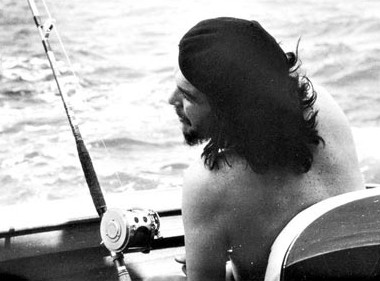 |
1960年5月15日、ハバナ沖で釣りをするゲバラ。カストロとともに、ゲバラは、いわゆる「ヘミングウェイ・フィッシング・コンテスト」で、亡命作家アーネスト・ヘミングウェイと競い合った. |
| Bay of Pigs and Four Year Plan Main articles: Bay of Pigs Invasion and Four Year Plan (Cuba) In 1960, Guevara began promoting an idea of rapidly industrializing Cuba, and diversifying Cuba's agriculture. In 1961, Guevara proposed a four-year plan for rapid industrialization that would create a 15% annual growth rate, and a tenfold increase in the production of fruits.[182] As head of the Ministry of Industries, Guevara announced on the radio program People's University on March 3, 1961, that "accelerated industrialization" would require the centralization of all economic decision making.[183] On 17 April 1961, 1,400 US-trained Cuban exiles invaded Cuba during the Bay of Pigs Invasion. Guevara did not play a key role in the fighting, as one day before the invasion a warship carrying Marines faked an invasion off the West Coast of Pinar del Río and drew forces commanded by Guevara to that region. However, historians give him a share of credit for the victory as he was director of instruction for Cuba's armed forces at the time.[12] Author Tad Szulc in his explanation of the Cuban victory, assigns Guevara partial credit, stating: "The revolutionaries won because Che Guevara, as the head of the Instruction Department of the Revolutionary Armed Forces in charge of the militia training program, had done so well in preparing 200,000 men and women for war."[12] It was also during this deployment that he suffered a bullet grazing to the cheek when his pistol fell out of its holster and accidentally discharged.[184] 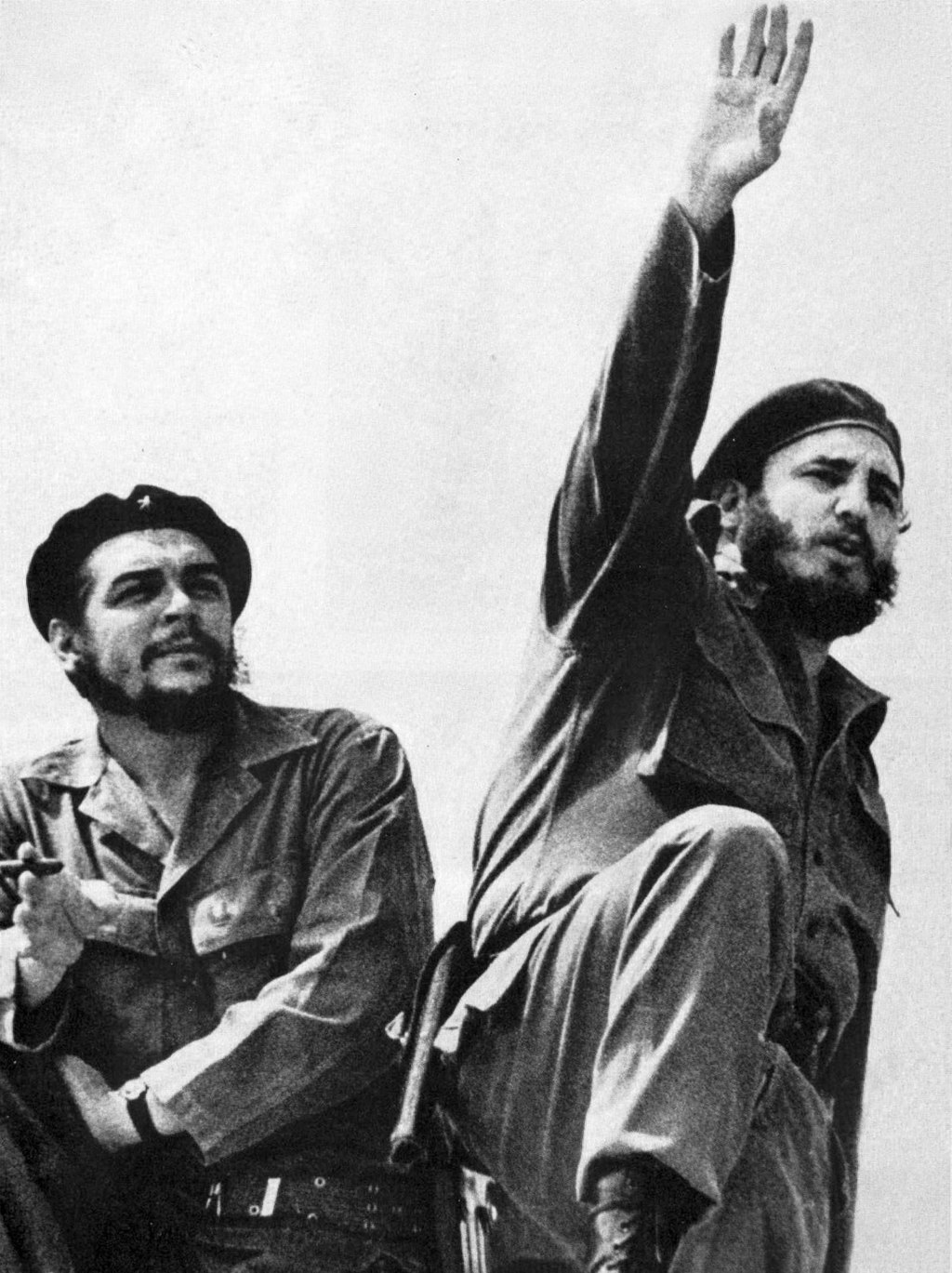 Guevara (left) and Fidel Castro, photographed by Alberto Korda in 1961 In August 1961, during an economic conference of the Organization of American States in Punta del Este, Uruguay, Che Guevara sent a note of "gratitude" to United States President John F. Kennedy through Richard N. Goodwin, Deputy Assistant Secretary of State for Inter-American Affairs. It read "Thanks for Playa Girón (Bay of Pigs). Before the invasion, the revolution was shaky. Now it's stronger than ever."[185] In response to United States Treasury Secretary Douglas Dillon presenting the Alliance for Progress for ratification by the meeting, Guevara antagonistically attacked the United States' claim of being a "democracy", stating that such a system was not compatible with "financial oligarchy, discrimination against blacks, and outrages by the Ku Klux Klan".[186] Guevara continued, speaking out against the "persecution" that in his view "drove scientists like Oppenheimer from their posts, deprived the world for years of the marvelous voice of Paul Robeson, and sent the Rosenbergs to their deaths against the protests of a shocked world."[186] Guevara ended his remarks by insinuating that the United States was not interested in real reforms, sardonically quipping that "U.S. experts never talk about agrarian reform; they prefer a safe subject, like a better water supply. In short, they seem to prepare the revolution of the toilets."[187] Nevertheless, Goodwin stated in his memo to President Kennedy following the meeting that Guevara viewed him as someone of the "newer generation"[188] and that Guevara, whom Goodwin alleged sent a message to him the day after the meeting through one of the meeting's Argentine participants whom he described as "Darretta",[188] also viewed the conversation which the two had as "quite profitable".[188] Guevara was a member of JUCEPLAN, the central planning board of Cuba, while he was head of the Ministry of Industries. The head of JUCEPLAN, Regino Boti, announced in August 1961 that the country would soon have a 10% rate of economic growth, and throughout 1961, various Marxist economists from throughout the world were invited to Cuba to assist in economic planning.[189][190] The four-year plan drafted by JUCEPLAN in 1961 stressed industrialization and agricultural diversification, minimizing sugar production. This plan was devised to be implemented in 1962 through 1965.[191] |
ピッグス湾事件と4カ年計画 主な記事:ピッグス湾事件と4カ年計画(キューバ 1960年、ゲバラはキューバの急速な工業化と農業の多角化を推進する考えを提唱し始めた。1961年、ゲバラは年間成長率15%、果物の生産量を10倍 に増やすという急速な工業化のための4カ年計画を提案した。182] 産業大臣として、ゲバラは1961年3月3日のラジオ番組「人民大学」で、「工業化の加速」には、すべての経済的意思決定の一元化が必要であると発表し た。 1961年4月17日、1,400人のアメリカで訓練を受けたキューバ亡命者が、ピッグス湾侵攻でキューバに侵攻した。ゲバラは戦闘で重要な役割を果たさ なかった。侵攻の1日前、海兵隊を乗せた軍艦がピナル・デル・リオの西海岸で侵攻を偽装し、ゲバラが指揮する部隊をその地域に引き付けたためだ。しかし、 歴史家たちは、当時キューバ軍教育部長を務めていたゲバラに勝利の一部の功績を認めている。[12] 著者タッド・シュルツは、キューバの勝利を説明する際、ゲバラに部分的な功績を付与し、次のように述べている: 「革命軍が勝利したのは、民兵の訓練プログラムを担当する革命軍教育部長であったチェ・ゲバラが、20 万人もの男女を戦争に備えるための準備を完璧にこなしたからだ」[12]。また、この作戦中に、ホルスターから拳銃が落ち、誤って発砲し、頬に銃弾が掠め た。[184]  ゲバラ(左)とフィデル・カストロ、1961年にアルベルト・コルダが撮影 1961年8月、ウルグアイのプンタ・デル・エステで開催された米州機構の経済会議において、チェ・ゲバラは、リチャード・N・グッドウィン国務次官補 (米州担当)を通じて、ジョン・F・ケネディ米国大統領に「感謝」の書簡を送った。その内容は「プラヤ・ギリオン(ピッグス湾)ありがとう」と書かれてい た。侵攻前は革命は不安定だったが、今やかつてないほど強固なものとなっている」と記されていた。[185] アメリカ合衆国財務長官ダグラス・ディロンが会議での批准を提案した「進歩のための同盟」に対し、ゲバラはアメリカ合衆国の「民主主義」を主張する立場を 激しく批判し、そのようなシステムは「金融寡頭制、黒人差別、クー・クラックス・クランの暴行」と相容れないと述べた。[186] ゲバラはさらに、自身の見解では「オッペンハイマーのような科学者を職から追放し、世界からポール・ロベソンの素晴らしい声を長年奪い、ローゼンバーグ夫 妻を世界の驚愕の抗議にもかかわらず死刑に追いやった」という「迫害」に反対する発言を続けた。[186] グエバラは、米国は真の改革には興味がないことをほのめかし、「米国の専門家たちは、農地改革について決して話さない。彼らは、より良い水道のような、よ り安全な話題を好む。要するに、彼らはトイレの革命の準備をしているようだ」と皮肉たっぷりに述べ、発言を締めくくった。[187] しかし、グッドウィンは会合後のケネディ大統領へのメモで、ゲバラは彼を「新しい世代」の人物と見なしていたと述べ、[188] ゲバラは会合の翌日、会合のアルゼンチン参加者で「ダレッタ」と形容した人物を通じてメッセージを送ってきたと主張し、[188] 両者の会話を「非常に有益だった」と評価していたと記した。[188] ゲバラは、産業大臣在任中、キューバの中央計画委員会である JUCEPLAN のメンバーだった。JUCEPLAN の長であるレジーノ・ボティは、1961 年 8 月、キューバの経済成長率はまもなく 10% に達すると発表し、1961 年を通じて、世界中からさまざまなマルクス主義経済学者たちがキューバに招かれ、経済計画の支援を行った。[189][190] JUCEPLANが1961年に策定した4カ年計画は、工業化と農業の多角化を重視し、砂糖生産の最小化を掲げていた。この計画は1962年から1965 年にかけて実施される予定だった。[191] |
| Great Debate and Missile Crisis Further information: Great Debate (Cuba) and Cuban Missile Crisis See also: Guerrillerismo In March 1962, Guevara admitted in a speech that the economic plan was a failure, specifically stating it was "an absurd plan, disconnected from reality, with absurd goals and imaginary resources."[182] The failure of the industrialization plan had immediate impacts by 1962. In that year, Cuba introduced a rationing system for food.[192] Fidel Castro soon invited Marxist economists around the world to debate two main propositions. One proposition proposed by Che Guevara was that Cuba could bypass any capitalist then "socialist" transition period and immediately become an industrialized "communist" society if "subjective conditions" like public consciousness and vanguard action are perfected. The other proposition held by the Popular Socialist Party was that Cuba required a transitionary period as a mixed economy in which Cuba's sugar economy was maximized for profit before a "communist" society could be established.[193][194][195] Guevara elaborated in this period that moral incentives should exist as the main motivator to increase workers' production. All profits created by enterprises were to be given to the state budget, and the state budget would cover losses. Institutions that developed socialist consciousness were regarded as the most important element in maintaining a path to socialism rather than materially incentivized increases in production. Implementation of the profit-motive was regarded as a path towards capitalism and as one of the flaws of the Eastern bloc economies.[196] The economy would also rely on mass mobilizations and centralized planning as a method for developing the economy.[197] The main ideal that compromised the consciousness that would develop socialism was the praise of the "new man", a citizen that was only motivated by human solidarity and self-sacrifice.[198] Outside of economic matters, Guevara served as the main architect of the Cuban–Soviet relationship,[199] and played a key role in bringing to Cuba the Soviet nuclear-armed ballistic missiles that precipitated the Cuban Missile Crisis in October 1962 and brought the world to the brink of nuclear war.[200][201] After the Soviets proposed planting nuclear missiles in Cuba it was Che Guevara himself who traveled to the Soviet Union on 30 August 1962, to sign off on the final agreement.[202] Guevara argued with Khruschev that the missile deal should be made public but Khruschev insisted on secrecy, and swore the Soviet Union's support if the Americans discovered the missiles. By the time Guevara arrived in Cuba the United States had already discovered the Soviet troops in Cuba via U-2 spy planes.[203] A few weeks after the crisis, during an interview with the British communist newspaper the Daily Worker, Guevara was still fuming over the perceived Soviet betrayal and told correspondent Sam Russell that, if the missiles had been under Cuban control, they would have fired them off.[204] While expounding on the incident later, Guevara reiterated that the cause of socialist liberation against global "imperialist aggression" would ultimately have been worth the possibility of "millions of atomic war victims".[205] The missile crisis further convinced Guevara that the world's two superpowers (the United States and the Soviet Union) used Cuba as a pawn in their own global strategies. Afterward, he denounced the Soviets almost as frequently as he denounced the Americans.[206] Che Guevara in his office as Minister of Industry (in the Hotel Riviera), while being interviewed by Laura Berquist for Look magazine. (1963) Economic decline in Cuba continued past 1962, in the next year, sugar production was down by over a third of its 1961 level.[207] The sugar harvest of 1963 only brought in 3.8 million tons, the lowest harvest in Cuba in over twenty years.[208] General food production was also down per capita by 40% for the next three years.[209] In the same year, Castro began to emphasize sugar production in economic planning.[207] Guevara also resigned from his position as head of Ministry of Industries.[210] In February 1963, Guevara published the essay Against bureaucratism, in which he describes the "guerrillaism" of the Cuban leadership, the necessity of bureaucratization to prevent rash decision-making amongst ex-guerrillas, and the new need to de-bureaucratize to end idleness in production.[211] Since his essay, the word "Guerrillerismo", taken from his essay, has been used by historians to refer to a style of rhetoric that developed in Cuba, that constantly linked government decisions to the guerrilla struggle of the Cuban Revolution, inferring they are all part of the same struggle.[212] In 1964, Guevara published an article, titled The Cuban Economy: Its Past, and Its Present Importance, which analyzed the recent failure of Guevara's economic plans. In the article Guevara states that he committed "two principle errors": the diversification of agriculture, and dispersing resources evenly for various agricultural sectors. Specifically on the move away from sugar, Guevara states: The entire economic history of Cuba had demonstrated that no other agricultural activity would give such returns as those yielded by the cultivation of the sugarcane. At the outset of the Revolution many of us were not aware of this basic economic fact, because a fetishistic idea connected sugar with our dependence on imperialism and with the misery in the rural areas, without analysing the real causes: the relation to the uneven trade balance.[213] |
大討論とミサイル危機 詳細情報:大討論(キューバ)およびキューバミサイル危機 関連項目:ゲリラ主義 1962年3月、ゲバラは演説の中で、経済計画は失敗だったことを認め、「現実からかけ離れた、不条理な目標と架空の資源に基づく、不条理な計画だった」 と具体的に述べた[182]。工業化計画の失敗は、1962年までに即座に影響を及ぼした。その年、キューバは食糧の配給制度を導入した[192]。 フィデル・カストロはすぐに、世界中のマルクス主義経済学者たちを招き、2つの主要な提案について議論するよう呼びかけた。チェ・ゲバラが提案した1つの 提案は、キューバは、国民意識や先駆的な行動などの「主観的条件」が完璧に整えば、資本主義から「社会主義」への移行期を飛び越えて、すぐに工業化された 「共産主義」社会になることができるというものであった。もう一つの提案は、人民社会主義党が提唱したもので、キューバは「共産主義」社会を確立する前 に、キューバの砂糖経済を利益のために最大限に活用する、混血経済としての過渡期を必要としているというものであった[193][194]。[195] ゲバラはこの時期、労働者の生産性を高める主な動機として、道徳的インセンティブが存在すべきだと詳しく述べた。企業が生み出した利益はすべて国家予算に 充てられ、損失は国家予算で賄われることになっていた。物質的なインセンティブによる生産の増加よりも、社会主義意識を育む機関が、社会主義への道筋を維 持する上で最も重要な要素であると見なされていた。利益動機を導入することは、資本主義への道であり、東欧諸国の経済の欠陥の一つと見なされていた。 [196] 経済は、経済発展の手段として、大衆動員と中央集権的な計画に依存することになっていた。[197] 社会主義を育む意識を損なう主な理想は、「新しい人間」の称賛だった。これは、人間同士の連帯と自己犠牲のみに動機付けられた市民を指す。[198] 経済問題以外では、ゲバラはキューバとソ連の関係の主な立役者であり[199]、1962年10月にキューバミサイル危機を引き起こし、世界を核戦争の瀬 戸際に追いやったソ連の核弾頭搭載弾道ミサイルをキューバに導入する上で重要な役割を果たした。[200][201] ソ連がキューバに核ミサイルを配備することを提案した後、ゲバラ自身は1962年8月30日にソ連を訪れ、最終合意に署名した。[202] ゲバラはフルシチョフに対し、ミサイル配備の合意を公表すべきだと主張したが、フルシチョフは秘密保持を堅持し、アメリカがミサイルを発見した場合、ソ連 の支援を誓った。ゲバラがキューバに到着するまでに、アメリカはU-2偵察機によってキューバにソ連軍が駐留していることをすでに発見していた。 [203] 危機から数週間後、イギリスの共産主義新聞「デイリー・ワーカー」のインタビューで、ゲバラはソ連の「裏切り」に対する怒りをまだ抑えきれず、特派記者サ ム・ラッセルに対し、ミサイルがキューバの支配下にあったなら、発射していただろうと語った。[204] 後にこの事件について説明する際、ゲバラは、世界的な「帝国主義的侵略」に対する社会主義解放の闘いは、最終的に「数百万人の原子戦争の犠牲者」の可能性 に値するものであったと繰り返した。[205] ミサイル危機は、ゲバラに、世界の二大超大国(アメリカとソビエト連邦)がキューバを自らのグローバル戦略の駒として利用していることをさらに確信させ た。その後、彼はアメリカ人を非難するのとほぼ同じ頻度でソ連を非難した。[206] ルック誌のローラ・バークイストのインタビューを受ける、産業大臣のオフィス(リヴィエラホテル)でのチェ・ゲバラ。(1963年) キューバの経済衰退は1962年以降も続き、翌年には砂糖の生産量は1961年の3分の1以上に減少した。[207] 1963年の砂糖収穫量は380万トンで、20年以上で最低の収穫量となった。[208] 1人当たりの食料生産量も、その後の3年間で40%減少した。[209] 同年、カストロは経済計画において砂糖生産の重要性を強調し始めた。[207] ゲバラも産業大臣の職を辞任した。[210] 1963年2月、ゲバラはエッセイ『官僚主義に反対して』を発表し、キューバ指導部の「ゲリラ主義」、元ゲリラの軽率な意思決定を防ぐための官僚化の必要 性、生産の怠慢を終わらせるための新たな官僚化解除の必要性を述べた。[211] 彼のエッセイ以降、「ゲリラリズム」という言葉は、キューバで発展した修辞スタイルを指す言葉として歴史家によって使用されるようになった。このスタイル は、政府の決定をキューバ革命のゲリラ闘争と常に結びつけ、それらすべてが同じ闘争の一部であると暗示するものだ。[212] 1964年、ゲバラは「キューバ経済:その過去と現在の重要性」と題した論文を発表し、ゲバラの経済計画の最近の失敗を分析した。この論文の中で、ゲバラ は「2つの重大な過ち」を犯したと述べている。それは、農業の多様化と、さまざまな農業部門に資源を均等に分散させたことだ。特に砂糖からの脱却につい て、ゲバラは次のように述べている。 キューバの経済史全体は、サトウキビの栽培以外の農業活動がこれほどの利益をもたらすことはないことを示していた。革命の初期、私たちの中にはこの基本的 な経済的事実を認識していなかった者が多かった。なぜなら、サトウキビを帝国主義への依存と農村部の貧困と結びつける偶像的な考えが、真の原因である不均 衡な貿易収支の関係を分析せずに存在していたからだ。[213] |
International diplomacy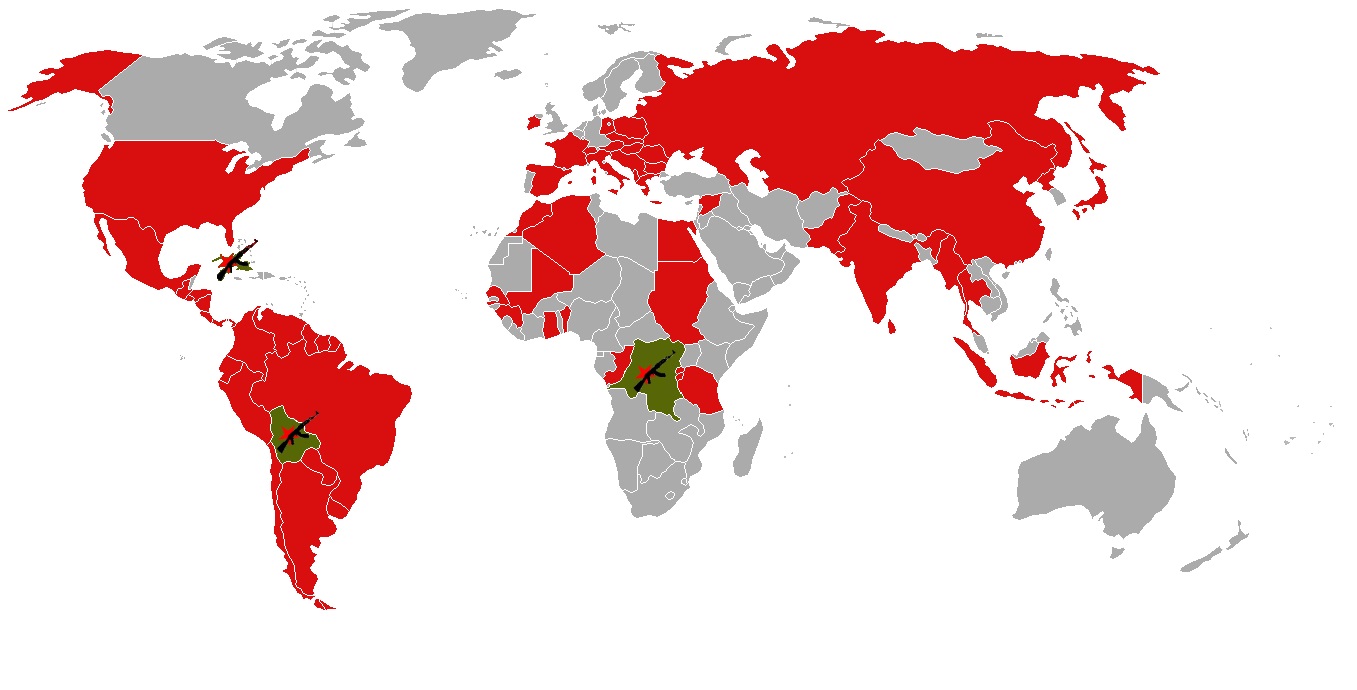 Countries Che Guevara visited (red) and those in which he participated in armed revolution (green) United Nations delegation In December 1964, Che Guevara had emerged as a "revolutionary statesman of world stature" and thus traveled to New York City as head of the Cuban delegation to speak at the United Nations.[157] On 11 December 1964, during Guevara's hour-long, impassioned address at the UN, he criticized the United Nations' inability to confront the "brutal policy of apartheid" in South Africa, asking "Can the United Nations do nothing to stop this?".[214] Guevara then denounced the United States policy towards their black population, stating: Those who kill their own children and discriminate daily against them because of the color of their skin; those who let the murderers of blacks remain free, protecting them, and furthermore punishing the black population because they demand their legitimate rights as free men—how can those who do this consider themselves guardians of freedom?[214] An indignant Guevara ended his speech by reciting the Second Declaration of Havana, decreeing Latin America a "family of 200 million brothers who suffer the same miseries".[214] This "epic", Guevara declared, would be written by the "hungry Indian masses, peasants without land, exploited workers, and progressive masses". To Guevara the conflict was a struggle of masses and ideas, which would be carried forth by those "mistreated and scorned by imperialism" who were previously considered "a weak and submissive flock". With this "flock", Guevara now asserted, "Yankee monopoly capitalism" now terrifyingly saw their "gravediggers".[214] It would be during this "hour of vindication", Guevara pronounced, that the "anonymous mass" would begin to write its own history "with its own blood" and reclaim those "rights that were laughed at by one and all for 500 years". Guevara closed his remarks to the General Assembly by hypothesizing that this "wave of anger" would "sweep the lands of Latin America" and that the labor masses who "turn the wheel of history" were now, for the first time, "awakening from the long, brutalizing sleep to which they had been subjected".[214] 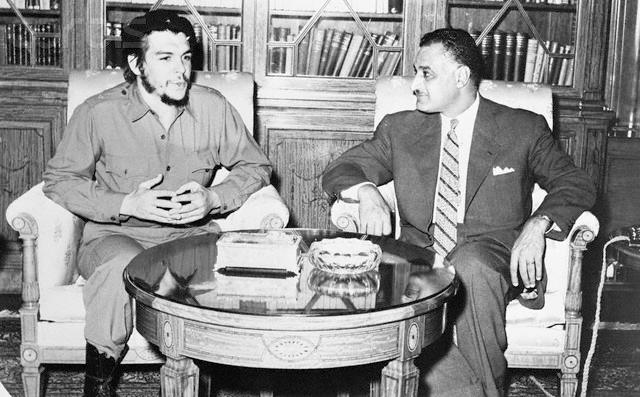 Meeting Egyptian President Gamal Abdel Nasser in Cairo, 1964 Guevara later learned there had been two failed attempts on his life by Cuban exiles during his stop at the UN complex.[215] The first from Molly Gonzales, who tried to break through barricades upon his arrival with a seven-inch hunting knife, and the second by Guillermo Novo, who fired a timer-initiated bazooka from a boat in the East River at the United Nations Headquarters during his address, but missed and was off target. Afterwards Guevara commented on both incidents, stating that "it is better to be killed by a woman with a knife than by a man with a gun", while adding with a languid wave of his cigar that the explosion had "given the whole thing more flavor".[215] 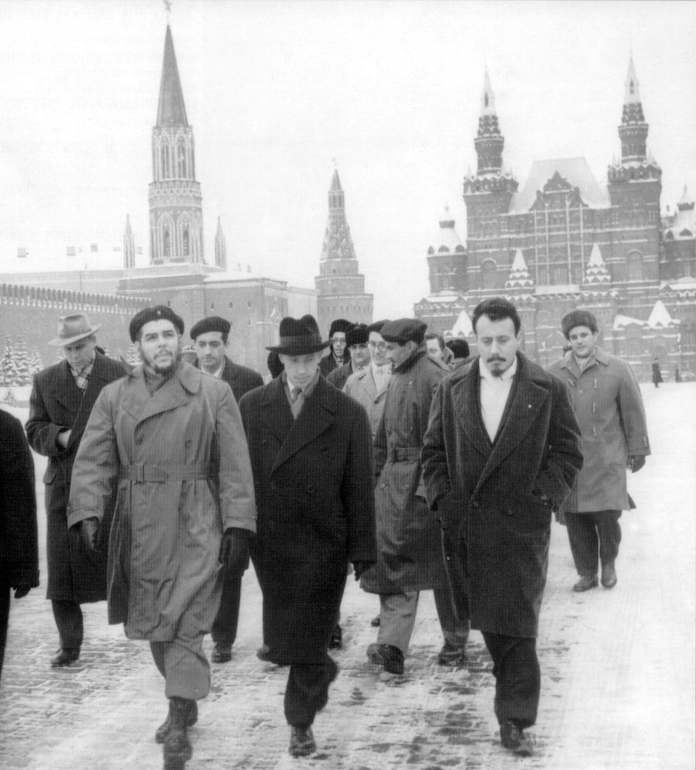 Walking through Red Square in Moscow, November 1964 While in New York, Guevara appeared on the CBS Sunday news program Face the Nation,[216] and met with a wide range of people, from United States Senator Eugene McCarthy[217] to associates of Malcolm X. The latter expressed his admiration, declaring Guevara "one of the most revolutionary men in this country right now" while reading a statement from him to a crowd at the Audubon Ballroom.[218] |
国際外交 チェ・ゲバラが訪問した国(赤)と、武装革命に参加した国(緑) 国連代表団 1964年12月、チェ・ゲバラは「世界的な革命家」として頭角を現し、キューバ代表団長としてニューヨークを訪れ、国連で演説を行った。[157] 1964年12月11日、ゲバラは国連で1時間にわたる熱弁を振るい、南アフリカの「残虐なアパルトヘイト政策」に立ち向かうことができない国連を批判 し、「国連はこれを止めるために何もできないのか? 自らの子供を殺し、肌の色を理由に毎日差別する者たち;黒人の殺害者を自由のまま放置し、保護し、さらに自由な人間としての正当な権利を要求する黒人人口を罰する者たち——このような行為を行う者が、自由の守護者だと自称できるのか?[214] 憤慨したゲバラは、ハバナ第二宣言を引用して演説を締めくくり、ラテンアメリカを「同じ苦難に苦しむ 2 億人の兄弟の家族」と宣言した[214]。この「叙事詩」は、「飢えたインディアン大衆、土地のない農民、搾取される労働者、そして進歩的な大衆」によっ て書かれるだろうとゲバラは宣言した。ゲバラにとって、この対立は「大衆と思想の闘争」であり、これまで「帝国主義によって虐待され、軽蔑されてきた者た ち」が、かつて「弱く従順な群れ」と見なされていた者たちが、この闘争を推進する。ゲバラは、この「群れ」こそが、現在「ヤンキーの独占資本主義」が恐怖 する「墓掘り人」であると断言した。[214] ゲバラは、この「復讐の時刻」に、「無名の民衆」が「自らの血で」自らの歴史を書き始め、500年間「すべての人から嘲笑されてきた権利」を取り戻すだろ うと宣言した。ゲバラは、この「怒りの波」が「ラテンアメリカの土地を席巻する」と仮定し、「歴史の車輪を回す」労働大衆が、今、初めて「彼らが課せられ てきた長く残酷な眠りから目覚めつつある」と述べて、総会での演説を締めくくった。  1964年、カイロでエジプト大統領ガマル・アブデル・ナセルと会談 ゲバラは後に、国連施設に立ち寄った際に、キューバ亡命者による 2 件の暗殺未遂があったことを知った[215]。1 件目は、モリー・ゴンザレスが、ゲバラの到着時に 7 インチの狩猟用ナイフを持ってバリケードを突破しようとしたもの。2 件目は、ギジェルモ・ノボが、ゲバラが演説中に国連本部のあるイーストリバーから、タイマー付きバズーカを発射したが、目標を外して失敗したものだ。その 後、ゲバラは両事件について、「銃を持った男に殺されるより、ナイフを持った女に殺されたほうがいい」とコメントし、葉巻をゆったりと振りながら、爆発は 「全体にもっと味を与えた」と付け加えた。[215]  1964年11月、モスクワの赤の広場を歩くゲバラ ニューヨーク滞在中、ゲバラは CBS の日曜ニュース番組「フェイス・ザ・ネイション」に出演し[216]、米国上院議員ユージン・マッカーシー[217] からマルコム X の仲間たちまで、幅広い人々と会談した。後者は、オーデュボン・ボールルームでゲバラの声明を群衆に読み上げ、ゲバラを「現在この国で最も革命的な人物の 一人」と評し、その称賛の意を表した[218]。 |
| World travel On 17 December, Guevara left New York for Paris, France, and from there embarked on a three-month world tour that included visits to the People's Republic of China, North Korea, the United Arab Republic, Algeria, Ghana, Guinea, Mali, Dahomey, Congo-Brazzaville, and Tanzania, with stops in Ireland and Prague. While in Ireland, Guevara embraced his own Irish heritage, celebrating Saint Patrick's Day in Limerick.[219] He wrote to his father on this visit, humorously stating "I am in this green Ireland of your ancestors. When they found out, the television [station] came to ask me about the Lynch genealogy, but in case they were horse thieves or something like that, I didn't say much."[220] During Guevara's time in Algeria, he was interviewed by Spanish poet Juan Goytisolo inside the Cuban embassy. During the interview, Guevara noticed a book by openly gay Cuban writer Virgilio Piñera that was sitting on the table next to him. When he noticed it, he threw the book against the wall and yelled "how dare you have in our embassy a book by this foul faggot?".[221][222][223] This moment has been marked as a turn in Goytisolo's personal identity as it influenced him to slowly come out of the closet as gay and begin to sympathize with the LGBT citizens of Cuba.[224] During this voyage, he wrote a letter to Carlos Quijano, editor of a Uruguayan weekly, which was later retitled Socialism and Man in Cuba.[168] Outlined in the treatise was Guevara's summons for the creation of a new consciousness, a new status of work, and a new role of the individual. He also laid out the reasoning behind his anti-capitalist sentiments, stating: The laws of capitalism, blind and invisible to the majority, act upon the individual without his thinking about it. He sees only the vastness of a seemingly infinite horizon before him. That is how it is painted by capitalist propagandists, who purport to draw a lesson from the example of Rockefeller—whether or not it is true—about the possibilities of success. The amount of poverty and suffering required for the emergence of a Rockefeller, and the amount of depravity that the accumulation of a fortune of such magnitude entails, are left out of the picture, and it is not always possible to make the people in general see this.[168] Guevara ended the essay by declaring that "the true revolutionary is guided by a great feeling of love" and beckoning on all revolutionaries to "strive every day so that this love of living humanity will be transformed into acts that serve as examples", thus becoming "a moving force".[168] The genesis for Guevara's assertions relied on the fact that he believed the example of the Cuban Revolution was "something spiritual that would transcend all borders".[42] |
世界旅行 12月17日、ゲバラはニューヨークを離れ、フランスのパリへ飛び、そこから3カ月にわたる世界旅行に出発した。この旅行では、中華人民共和国、北朝鮮、 アラブ連合共和国、アルジェリア、ガーナ、ギニア、マリ、ダホメ、コンゴ・ブラザヴィル、タンザニアを訪問し、アイルランドとプラハにも立ち寄った。アイ ルランド滞在中、ゲバラは自身のアイリッシュ系祖先のルーツを誇り、リムリックで聖パトリックの日を祝った。[219] この訪問中に父に宛てた手紙で、彼はユーモアを交えて次のように書いた。「あなたの祖先の緑豊かなアイルランドにいます。テレビ局がリンチ家の系譜につい て取材に来たが、万一馬泥棒とかそんな連中だったら困るから、あまり話さなかった。」[220] ゲバラがアルジェリアに滞在中、スペインの詩人フアン・ゴイティソロがキューバ大使館内で彼をインタビューした。インタビュー中、ゲバラは隣のテーブルに 置かれた、オープンリーゲイのキューバ人作家ヴィルヒリオ・ピニェラの書籍に気づいた。その書籍に気づくと、彼はそれを壁に投げつけ、「この大使館にこの 汚いゲイの書籍を置くなんて、何様のつもりだ?」と叫んだ。[221][222][223] この瞬間は、ゴイティソロの個人的なアイデンティティの転換点となった。この出来事がきっかけで、彼は徐々にゲイであることをカミングアウトし、キューバ の LGBT 市民に共感し始めるようになったのだ。[224] この航海中に、彼はウルグアイの週刊誌編集者カルロス・キハノに手紙を書いた。この手紙は後に『キューバの社会主義と人間』と改題された。[168] この論文では、ゲバラが提唱した新しい意識、労働の新たな地位、個人の新たな役割の創造が概説されていた。彼はまた、反資本主義的な思想の根拠を次のよう に説明している: 資本主義の法則は、大多数の人々には見えずに、彼らが意識することなく個人に作用している。彼らは、目の前に広がる無限に広がる地平線しか見ることができ ない。それは、ロックフェラーの例から成功の可能性について教訓を引き出そうとする資本主義の宣伝家たちが、それが真実であるかどうかに関わらず、描いて いる姿だ。ロックフェラーのような人物が出現するために必要な貧困と苦悩の程度、そしてそのような莫大な財産の蓄積が伴う堕落の程度は、その描写から省略 されており、一般の人々にそれを理解させることは必ずしも容易ではない。[168] ゲバラは、このエッセイを「真の革命家は、偉大な愛に導かれている」と宣言し、すべての革命家に「この生きた人類への愛が、模範となる行動へと変貌するよ う、日々努力し、この愛が『原動力』となるよう」呼びかけて締めくくっている。[168] グエバラの主張の起源は、彼がキューバ革命の例が「すべての国境を越える精神的なもの」であると信じていたことにあった。[42] |
| Visit to Algeria and political turn In Algiers, Algeria, on 24 February 1965, Guevara made what turned out to be his last public appearance on the international stage when he delivered a speech at an economic seminar on Afro-Asian solidarity.[225][226] He specified the moral duty of the socialist countries, accusing them of tacit complicity with the exploiting Western countries. He proceeded to outline a number of measures which he said the communist bloc countries must implement in order to accomplish the defeat of imperialism.[227] Having criticized the Soviet Union (the primary financial backer of Cuba) in such a public manner, he returned to Cuba on 14 March to a solemn reception by Fidel and Raúl Castro, Osvaldo Dorticós, and Carlos Rafael Rodríguez at the Havana airport. As revealed in his last public speech in Algiers, Guevara had come to view the Northern Hemisphere, led by the US in the West and the Soviet Union in the East, as the exploiter of the Southern Hemisphere. He strongly supported communist North Vietnam in the Vietnam War, and urged the peoples of other developing countries to take up arms and create "many Vietnams".[228] Che's denunciations of the Soviets made him popular among intellectuals and artists of the Western European left who had lost faith in the Soviet Union, while his condemnation of imperialism and call to revolution inspired young radical students in the United States, who were impatient for societal change.[229] Marx characterized the psychological or philosophical manifestation of capitalist social relations as alienation and antagonism; the result of the commodification of labor and the operation of the law of value. For Guevara, the challenge was to replace the individuals' alienation from the productive process, and the antagonism generated by class relations, with integration and solidarity, developing a collective attitude to production and the concept of work as a social duty. —Helen Yaffe, author of Che Guevara: The Economics of Revolution[230] In Guevara's private writings from this time (since released), he displays his growing criticism of the Soviet political economy, believing that the Soviets had "forgotten Marx".[230] This led Guevara to denounce a range of Soviet practices including what he saw as their attempt to "air-brush the inherent violence of class struggle integral to the transition from capitalism to socialism", their "dangerous" policy of peaceful co-existence with the United States, their failure to push for a "change in consciousness" towards the idea of work, and their attempt to "liberalize" the socialist economy. Guevara wanted the complete elimination of money, interest, commodity production, the market economy, and "mercantile relationships": all conditions that the Soviets argued would only disappear when world communism was achieved.[230] Disagreeing with this incrementalist approach, Guevara criticized the Soviet Manual of Political Economy, predicting that if the Soviet Union did not abolish the law of value (as Guevara desired), it would eventually return to capitalism.[230] 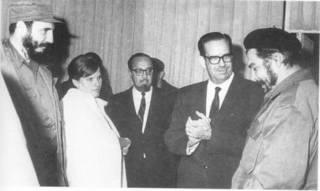 Guevara returning to Cuba at Rancho Boyeros airport on 14 March 1965. He is received by (left to right) Fidel Castro, Aleida March, Carlos Rafael Rodriguez, and Osvaldo Dorticos. Two weeks after his Algiers speech and his return to Cuba, Guevara dropped out of public life and then vanished altogether.[231] His whereabouts were a great mystery in Cuba, as he was generally regarded as second in power to Castro himself. His disappearance was variously attributed to the failure of the Cuban industrialization scheme he had advocated while minister of industries, to pressure exerted on Castro by Soviet officials who disapproved of Guevara's pro-Chinese communist stance on the Sino-Soviet split, and to serious differences between Guevara and the pragmatic Castro regarding Cuba's economic development and ideological line.[232] Pressed by international speculation regarding Guevara's fate, Castro stated on 16 June 1965, that the people would be informed when Guevara himself wished to let them know. Still, rumors spread both inside and outside Cuba concerning the missing Guevara's whereabouts. There are various rumors from retired Cuban officials who were around the Castro brothers that the Castro brothers and Guevara had a strong disagreement after Guevara's Algiers speech. Intelligence files from the East German embassy in Cuba detail various heated exchanges between Fidel Castro and Che Guevara after Guevara's return from Africa. Whether Castro disagreed with Guevara's criticisms of the Soviet Union or just found them unproductive to express on the world stage remains unclear.[233] On 3 October 1965, Castro publicly revealed an undated letter purportedly written to him by Guevara around seven months earlier which was later titled Che Guevara's "farewell letter". In the letter, Guevara reaffirmed his enduring solidarity with the Cuban Revolution but declared his intention to leave Cuba to fight for the revolutionary cause abroad. Additionally, he resigned from all his positions in the Cuban government and communist party, and renounced his honorary Cuban citizenship.[234] |
アルジェリア訪問と政治的転換 1965年2月24日、アルジェリアのアルジェで、ゲバラは、アフロ・アジア連帯に関する経済セミナーで演説を行い、これが国際舞台での最後の公の場での 登場となった。[225][226] 彼は、社会主義諸国に道徳的義務を明言し、搾取的な西側諸国と暗黙の共謀関係にあると非難した。さらに、帝国主義の打倒を実現するために共産主義諸国が実 施すべき措置をいくつか提示した。[227] ソ連(キューバの主要な財政支援国)を公然と批判したゲバラは、3月14日にキューバに戻り、ハバナ空港でフィデル・カストロ、ラウル・カストロ、オスバ ルド・ドルティコス、カルロス・ラファエル・ロドリゲスによって厳粛な歓迎を受けた。 アルジェでの最後の公開演説で明らかになったように、ゲバラは、西側のアメリカと東側のソビエト連邦が率いる北半球を、南半球の搾取者だと見るようになっ ていた。彼はベトナム戦争で共産主義の北ベトナムを強力に支援し、他の発展途上国の人民にも武器を取り、「多くのベトナム」を作るよう呼びかけた [228]。チェのソ連に対する非難は、ソ連への信頼を失った西ヨーロッパの左翼知識人や芸術家の間で人気を博し、一方、帝国主義を非難し、革命を唱える 彼の姿勢は、社会変革を待ちきれない米国の過激な学生たちに影響を与えた。[229] マルクスは、資本主義的社会関係の心理的または哲学的表現を、疎外と対立と特徴づけ、それは労働の商品化と価値の法則の作用の結果であるとしました。ゲバ ラにとって、課題は、生産過程からの個人の疎外と、階級関係によって生じる対立を、統合と連帯に置き換え、生産に対する集団的態度と、社会的義務としての 労働の概念を発展させることでした。 —ヘレン・ヤッフェ、『チェ・ゲバラ:革命の経済学』の著者[230] この時代のゲバラの私的な著作(後に公開された)では、ソビエトの政治経済に対する批判が深まっていることが窺える。彼はソビエトが「マルクスを忘れた」 と信じていた。[230] これによりゲバラは、ソビエトの様々な実践を非難した。具体的には、資本主義から社会主義への移行に不可欠な階級闘争の内在的な暴力性を「隠蔽しようとし た」点、アメリカとの平和共存政策の「危険性」、労働の概念への「意識改革」を推進しなかった点、社会主義経済の「自由化」を試みた点などだ。ゲバラは、 お金、利息、商品生産、市場経済、そして「商品関係」の完全な廃止を望んでいた。これらはすべて、ソ連が世界共産主義が達成されたときにのみ消滅すると主 張していた条件だった。[230] この漸進的なアプローチに反対したゲバラは、ソビエトの『政治経済マニュアル』を批判し、ソビエト連邦が(ゲバラが望んだように)価値法則を廃止しなけれ ば、最終的には資本主義に戻ると予測した。[230]  1965年3月14日、ランチョ・ボイエロス空港にキューバに戻ったゲバラ。彼を迎えたのは(左から右へ)フィデル・カストロ、アレイダ・マルシュ、カルロス・ラファエル・ロドリゲス、オスバルド・ドルティコス。 アルジェール演説とキューバ帰還から2週間後、ゲバラは公の舞台から姿を消し、その後完全に消えてしまった。[231] 彼はカストロに次ぐ権力者だと広く見なされていたため、彼の行方はキューバで大きな謎となった。彼の失踪は、産業大臣として提唱したキューバの工業化政策 の失敗、中ソ分裂に関するゲバラの親中国共産主義的立場を嫌ったソ連当局者によるカストロへの圧力、キューバの経済発展とイデオロギー方針に関するゲバラ と現実主義的なカストロとの深刻な意見の相違など、さまざまな要因が挙げられた。[232] ゲバラの行方に関する国際的な憶測が圧力を強める中、カストロは 1965 年 6 月 16 日、ゲバラ自身が知らせたいと思ったときに、人民に知らせる、と述べた。それでも、行方不明のゲバラの所在に関する噂は、キューバ国内外に広まった。 カストロ兄弟の周辺にいた元キューバ高官たちからは、ゲバラのアルジェール演説後、カストロ兄弟とゲバラの間で激しい対立があったという様々な噂がある。 キューバの東ドイツ大使館の諜報ファイルには、ゲバラのアフリカ帰還後、フィデル・カストロとチェ・ゲバラの間で交わされた激しいやり取りの詳細が記録さ れている。カストロがゲバラのソ連批判に反対したのか、それとも世界舞台で表現する価値がないと判断したのかは不明だ。[233] 1965年10月3日、カストロは、約7ヶ月前にゲバラが彼宛てに書いたとされる日付のない手紙を公表した。この手紙は後に「チェ・ゲバラの「別れの書 簡」と題された。この手紙の中で、ゲバラはキューバ革命に対する不変の連帯を再確認しつつ、キューバを離れて海外で革命のために戦う意向を表明した。さら に、キューバ政府および共産党のすべての役職を辞任し、キューバの名誉市民権も放棄した。[234] |
| Congo Crisis Military involvement Main article: Simba rebellion Further information: Operation South 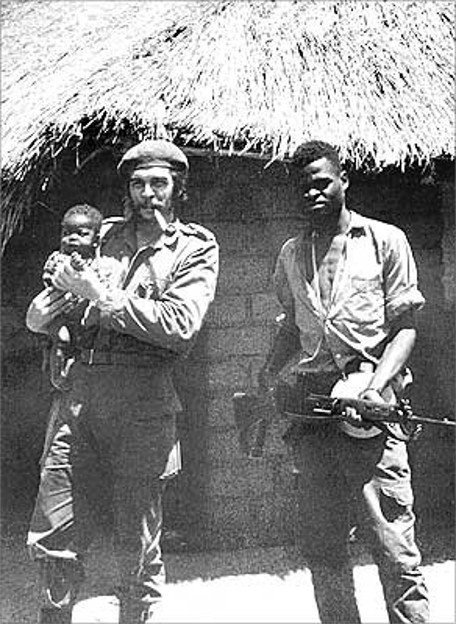 37-year-old Guevara, holding a Congolese baby and standing with a fellow Afro-Cuban soldier in the Congo Crisis, 1965 I tried to make them understand that the real issue was not the liberation of any given state, but a common war against the common master, who was one and the same in Mozambique and in Malawi, in Rhodesia and in South Africa, in the Congo and in Angola, but not one of them agreed. —Che Guevara, in February 1965, after meeting with various African liberation movement leaders in Dar es Salaam, Tanzania[235] In early 1965, Guevara went to Africa to offer his knowledge and experience as a guerrilla to the ongoing conflict in the Congo. According to Algerian President Ahmed Ben Bella, Guevara thought that Africa was imperialism's weak link and so had enormous revolutionary potential.[236] Egyptian President Gamal Abdel Nasser, who had fraternal relations with Che since his 1959 visit, saw Guevara's plan to fight in Congo as "unwise" and warned that he would become a "Tarzan" figure, doomed to failure.[237] Despite the warning, Guevara traveled to Congo using the alias Ramón Benítez.[238] He led the Cuban operation in support of the leftist Simba movement, which had emerged from the ongoing Congo conflict. Guevara, his second-in-command Víctor Dreke, and 12 other Cuban expeditionaries arrived in Congo on 24 April 1965, and a contingent of approximately 100 Afro-Cubans joined them soon afterward.[239][240] For a time, they collaborated with guerrilla leader Laurent-Désiré Kabila, who had helped supporters of the overthrown prime minister Patrice Lumumba to lead an unsuccessful revolt months earlier. As an admirer of the late Lumumba, Guevara declared that his "murder should be a lesson for all of us".[241] Guevara, with limited knowledge of Swahili and the local languages, was assigned a teenage interpreter, Freddy Ilanga. Over the course of seven months, Ilanga grew to "admire the hard-working Guevara", who "showed the same respect to black people as he did to whites".[242] Guevara soon became disillusioned with the poor discipline of Kabila's troops and later dismissed him, stating "nothing leads me to believe he is the man of the hour".[243] Regardless, Che still regarded Kabila more favorably than other Simba leaders, several of whom still pretended to lead rebel forces even after they had fled into exile.[244] As an additional obstacle, the Congolese military (the Armée Nationale Congolaise, ANC) was aided by mercenary troops led by Mike Hoare and supported by anti-Castro Cuban pilots and the CIA. These forces thwarted Guevara's movements from his base camp in the mountains near the village of Fizi on Lake Tanganyika in southeast Congo. They were able to monitor his communications and so pre-empted his attacks and interdicted his supply lines. Although Guevara tried to conceal his presence in Congo, the United States government knew his location and activities. The National Security Agency was intercepting all of his incoming and outgoing transmissions via equipment aboard the USNS Private Jose F. Valdez, a floating listening post that continuously cruised the Indian Ocean off Dar es Salaam for that purpose.[245] After becoming aware of the Communist Cubans' presence in eastern Congo, Hoare planned his strategies to explicitly counter their guerrilla warfare tactics.[246] 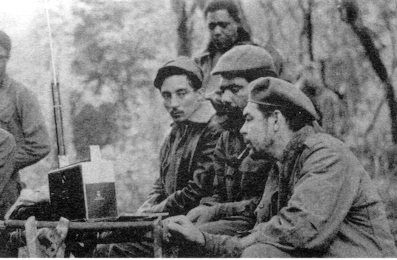 Listening to a Zenith Trans-Oceanic shortwave radio receiver are (seated from the left) Rogelio Oliva, José María Martínez Tamayo (known as "Mbili" in the Congo and "Ricardo" in Bolivia), and Guevara. Standing behind them is Roberto Sánchez ("Lawton" in Cuba and "Changa" in the Congo), 1965. Guevara's aim was to export the revolution by instructing local anti-Mobutu Simba fighters in Marxist ideology and foco theory strategies of guerrilla warfare. In his Congo Diary book, he cites a combination of incompetence, intransigence, and infighting among the Congolese rebels as key reasons for the revolt's failure.[247] On 27 September 1965, the ANC and its allies launched Operation South to destroy Kabila's forces. With the support of Che and his Cubans, the Simbas put up substantial resistance. Regardless, the rebels were increasingly pushed back, lost their supply routes, and suffered under failing morale.[248] Guevara himself was almost killed in one clash of the operation.[249] Regardless, he initially wanted to continue some form of guerrilla campaign from the local mountains, but even his Simba allies ultimately told him that the rebellion was defeated.[250] On 20 November 1965, suffering from dysentery and acute asthma, and disheartened after seven months of defeats and inactivity, Guevara left Congo with the six Cuban survivors of his 12-man column. Guevara stated that he had planned to send the wounded back to Cuba and fight in the Congo alone until his death, as a revolutionary example. But after being urged by his comrades, and two Cuban emissaries personally sent by Castro, at the last moment he reluctantly agreed to leave Africa. During that day and night, Guevara's forces quietly took down their base camp, burned their huts, and destroyed or threw weapons into Lake Tanganyika that they could not take with them, before crossing the border by boat into Tanzania at night and traveling by land to Dar es Salaam. In speaking about his experience in Congo months later, Guevara concluded that he left rather than fight to the death because: "The human element failed. There is no will to fight. The [rebel] leaders are corrupt. In a word ... there was nothing to do."[251] Guevara also declared that "we can not liberate, all by ourselves, a country that does not want to fight."[252] A few weeks later, he wrote the preface to the diary he kept during the Congo venture, that began: "This is the story of a failure."[253] |
コンゴ危機 軍事介入 主な記事:シンバの反乱 詳細情報:南作戦  1965年、コンゴ危機でコンゴの赤ん坊を抱き、アフリカ系キューバ人の兵士と立つ37歳のゲバラ 私は彼らに、真の問題は特定の国家の解放ではなく、モザンビーク、マラウイ、ローデシア、南アフリカ、コンゴ、アンゴラで同じ主君に支配されている共通の敵に対する共通の戦争であることを理解させようとしたが、誰も同意しなかった。 —チェ・ゲバラ、1965年2月、タンザニアのダルエスサラームでアフリカの解放運動の指導者たちと会談した後[235] 1965年初頭、ゲバラはコンゴで進行中の紛争にゲリラとしての知識と経験を活かすため、アフリカに向かった。アルジェリア大統領のアハメド・ベン・ベラ によると、ゲバラはアフリカが帝国主義の弱点であり、巨大な革命の可能性を秘めていると考えていた。[236] 1959年の訪問以来ゲバラと兄弟のような関係にあったエジプト大統領ガマル・アブデル・ナセルは、ゲバラのコンゴでの戦闘計画を「賢明ではない」と批判 し、彼が「ターザン」のような存在となり、失敗に終わるだろうと警告した。[237] 警告にもかかわらず、ゲバラはラモン・ベニテスという偽名でコンゴへ向かった。[238] 彼は、コンゴ紛争から生まれた左派のシンバ運動を支援するキューバの作戦を指揮した。ゲバラ、副官のヴィクトル・ドレケ、および12人のキューバ人遠征隊 員は1965年4月24日にコンゴに到着し、その後間もなく約100人のアフリカ系キューバ人が加わった。[239][240] 一時、彼らは数ヶ月前に打倒された首相パトリス・ルムンバの支持者を率いて失敗に終わった反乱を助けたゲリラ指導者ローラン・デシレ・カビラと協力した。 ルムンバの支持者だったゲバラは、「彼の暗殺は私たち全員の教訓となるべきだ」と宣言した。[241] スワヒリ語や現地の言語の知識が限られていたゲバラには、10 代の通訳、フレディ・イランガが割り当てられた。7 か月間に、イランガは「黒人に対して白人と同じ敬意を示す」勤勉なゲバラを「尊敬する」ようになった。[242] ゲバラはカビラの部隊の規律の緩さに失望し、後に彼を解雇し、「彼が時代の男だと信じる根拠は何もない」と述べた。[243] それでも、チェはカビラを他のシンバ指導者よりも好意的に見ていた。その中には、亡命後に依然として反乱軍を率いていると偽る者もいた。[244] さらに、コンゴ軍(コンゴ国民軍、ANC)は、マイク・ホアール率いる傭兵部隊、反カストロのキューバ人パイロット、CIAの支援を受けていた。これらの 勢力は、コンゴ南東部のタンガニーカ湖近くのフィジ村近くの山にあるゲバラの基地から、彼の動きを妨害した。彼らはゲバラの通信を監視し、彼の攻撃を先制 し、彼の補給路を遮断した。ゲバラはコンゴでの存在を隠そうとしたが、米国政府は彼の位置と活動を把握していた。国家安全保障局は、その目的のためにダル エスサラーム沖のインド洋を絶えず巡航する浮遊聴音艦 USNS プライベート・ホセ・F・バルデスに搭載された装置を使って、ゲバラの送受信するすべての通信を傍受していた。[245] コンゴ東部にキューバの共産主義者が存在することを知ったホアは、彼らのゲリラ戦術に対抗する明確な戦略を立てた[246]。  ゼニス社の短波ラジオ受信機を聞く(左から)ロジェリオ・オリバ、ホセ・マリア・マルティネス・タマヨ(コンゴでは「ムビリ」、ボリビアでは「リカルド」 として知られる)、ゲバラ。彼らの後ろに立っているのは、ロベルト・サンチェス(キューバでは「ロートン」、コンゴでは「チャンガ」として知られていた) だ。 ゲバラの目標は、モブツ政権に反対する現地のシンバの戦闘員たちに、マルクス主義のイデオロギーとゲリラ戦術のフォコ理論を教え込み、革命を輸出すること だった。彼の著書『コンゴ日記』では、反乱の失敗の主な理由として、コンゴの反政府勢力の無能、妥協の欠如、内紛などを挙げている[247]。1965年 9月27日、ANCとその同盟軍は、カビラの軍隊を破壊するための「南部作戦」を開始した。チェとキューバ人の支援を受けたシンバ軍は、激しい抵抗を展開 した。それにもかかわらず、反乱軍はますます追い詰められ、補給路を失い、士気低下に苦しんだ[248]。ゲバラ自身も、作戦中の衝突で殺されそうになっ た[249]。それにもかかわらず、彼は当初、地元の山々から何らかのゲリラ戦を継続したいと考えていたが、シムバの同盟者たちでさえ、最終的には反乱は 敗北したと彼に告げた。[250] 1965年11月20日、赤痢と急性喘息に苦しみ、7か月にわたる敗北と活動休止で意気消沈したゲバラは、12人の部隊のうち生き残った6人のキューバ人 とともにコンゴを離れた。ゲバラは、負傷者をキューバに送り返し、革命の模範として、死までコンゴで一人で戦うつもりだったと述べた。しかし、仲間たち、 そしてカストロが直接派遣した 2 人のキューバの使節に説得され、彼は最後の最後に、しぶしぶアフリカを離れることに同意した。その日、ゲバラの部隊は、夜通し、静かに基地を解体し、小屋 を焼き払い、持ち去ることができない武器は破壊したりタンガニーカ湖に投げ捨てたりした後、夜間にボートでタンザニアとの国境を越え、陸路でダルエスサ ラームへと向かった。数ヶ月後、コンゴでの経験を振り返り、ゲバラは次のように結論付けた。「人間的な要素が失敗した。戦う意志がない。反乱軍の指導者は 腐敗している。一言で言えば……やるべきことは何もない。」[251] ゲバラはまた、「自分たちだけで、戦いたくない国を解放することはできない。」と宣言した。[252] 数週間後、彼はコンゴでの冒険中に記した日記の序文を執筆し、次のように書き始めた:「これは失敗の物語である。」[253] |
Flight from the Congo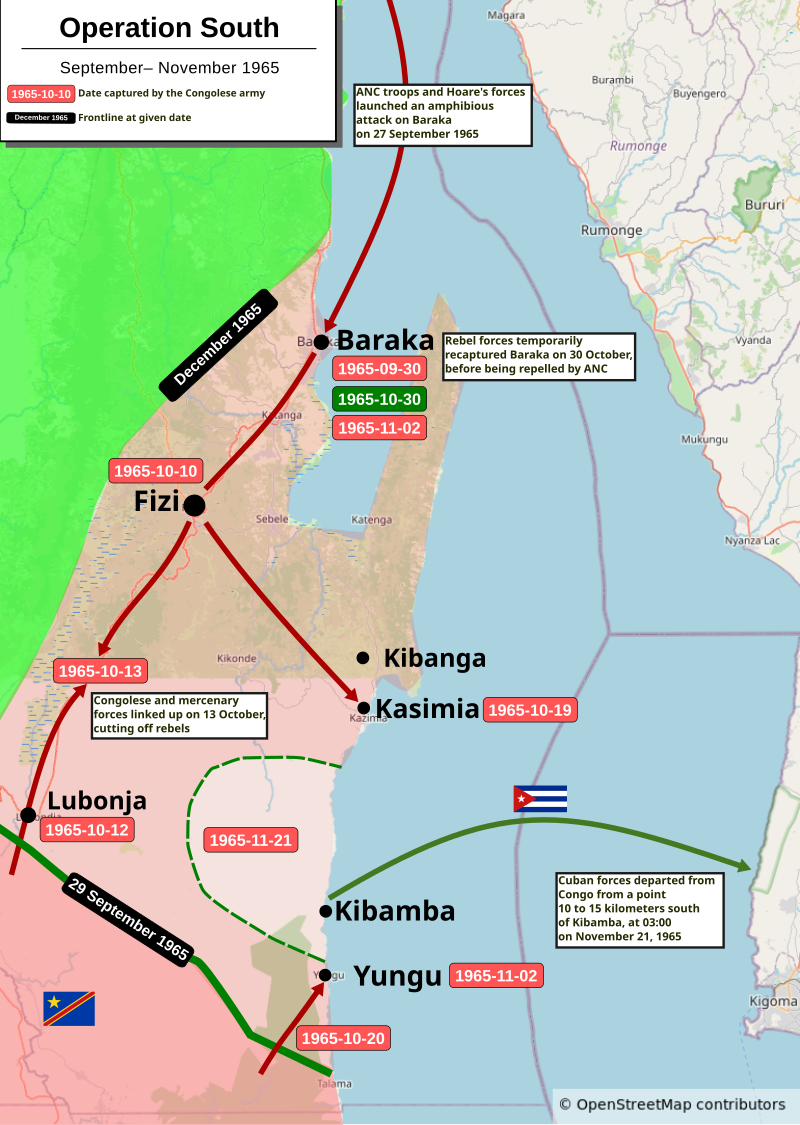 Map of the Operation South which forced Che Guevara to flee Congo Following the failure of the rebellion in the Congo, Guevara was reluctant to return to Cuba, because Castro had already made public Guevara's "farewell letter"—a letter intended to only be revealed in the case of his death—wherein he severed all ties in order to devote himself to revolution throughout the world.[254] As a result, Guevara spent the next six months living clandestinely at the Cuban embassy in Dar es Salaam and later at a Cuban safehouse in Ládví near Prague.[255] While in Europe, Guevara made a secret visit to former Argentine president Juan Perón who lived in exile in Francoist Spain where he confided in Perón about his new plan to formulate a communist revolution to bring all of Latin America under socialist control. Perón warned Guevara that his plans for implementing a communist revolution throughout Latin America, starting with Bolivia, would be suicidal and futile, but Guevara's mind was already made up. Later, Perón remarked that Guevara was "an immature utopian... but one of us. I am happy for it to be so because he is giving the Yankees a real headache."[256] During this time abroad, Guevara compiled his memoirs of the Congo experience and wrote drafts of two more books, one on philosophy and the other on economics. As Guevara prepared for Bolivia, he secretly traveled back to Cuba on 21 July 1966 to visit Castro, as well as to see his wife and to write a last letter to his five children to be read upon his death, which ended with him instructing them: Above all, always be capable of feeling deeply any injustice committed against anyone, anywhere in the world. This is the most beautiful quality in a revolutionary.[257] |
コンゴからの脱出 チェ・ゲバラをコンゴから逃亡させた「南作戦」の地図 コンゴでの反乱の失敗後、ゲバラはキューバに戻ることを躊躇していた。カストロが、ゲバラの死後にのみ公開されるはずだった「別れの書簡」をすでに公表し ていたからだ。この書簡では、ゲバラはキューバとのすべての関係を断ち切り、世界革命に専念することを表明していた。[254] その結果、ゲバラは次の6ヶ月間、ダルエスサラームのキューバ大使館で秘密裏に過ごし、その後プラハ近郊のラドヴィにあるキューバの安全屋に滞在した。 [255] ヨーロッパ滞在中、ゲバラはフランコ政権下のスペインで亡命生活を送っていた元アルゼンチン大統領フアン・ペロンを秘密裏に訪問し、ラテンアメリカ全体を 社会主義支配下に置くための共産主義革命を計画していることを打ち明けた。ペロンはゲバラに対し、ボリビアを起点にラテンアメリカ全土で共産主義革命を実 施する計画は自殺行為であり無意味だと警告したが、ゲバラの決意は固まっていた。後年、ペロンはゲバラについて「未熟なユートピアンだが、我々の一人だ。 そうであることに私は喜んでいる。なぜなら彼はアメリカ人に本当の頭痛の種を与えているからだ」と述べた。[256] この海外滞在中、ゲバラはコンゴでの経験を回顧録にまとめ、哲学と経済学に関する2冊の書籍の草稿を執筆した。ボリビアへの準備を進める中、ゲバラは 1966年7月21日に秘密裏にキューバに戻り、カストロを訪ねるとともに、妻に会い、死後に子供たち5人に読むための最後の手紙を書いた。その手紙は、 次のように結ばれていた: 何よりも、世界中のどこであれ、誰に対して行われた不正義に対しても、深く感じ取れる人間であれ。これが革命家にとって最も美しい資質だ。[257] |
| Bolivian insurgency Departure to Bolivia 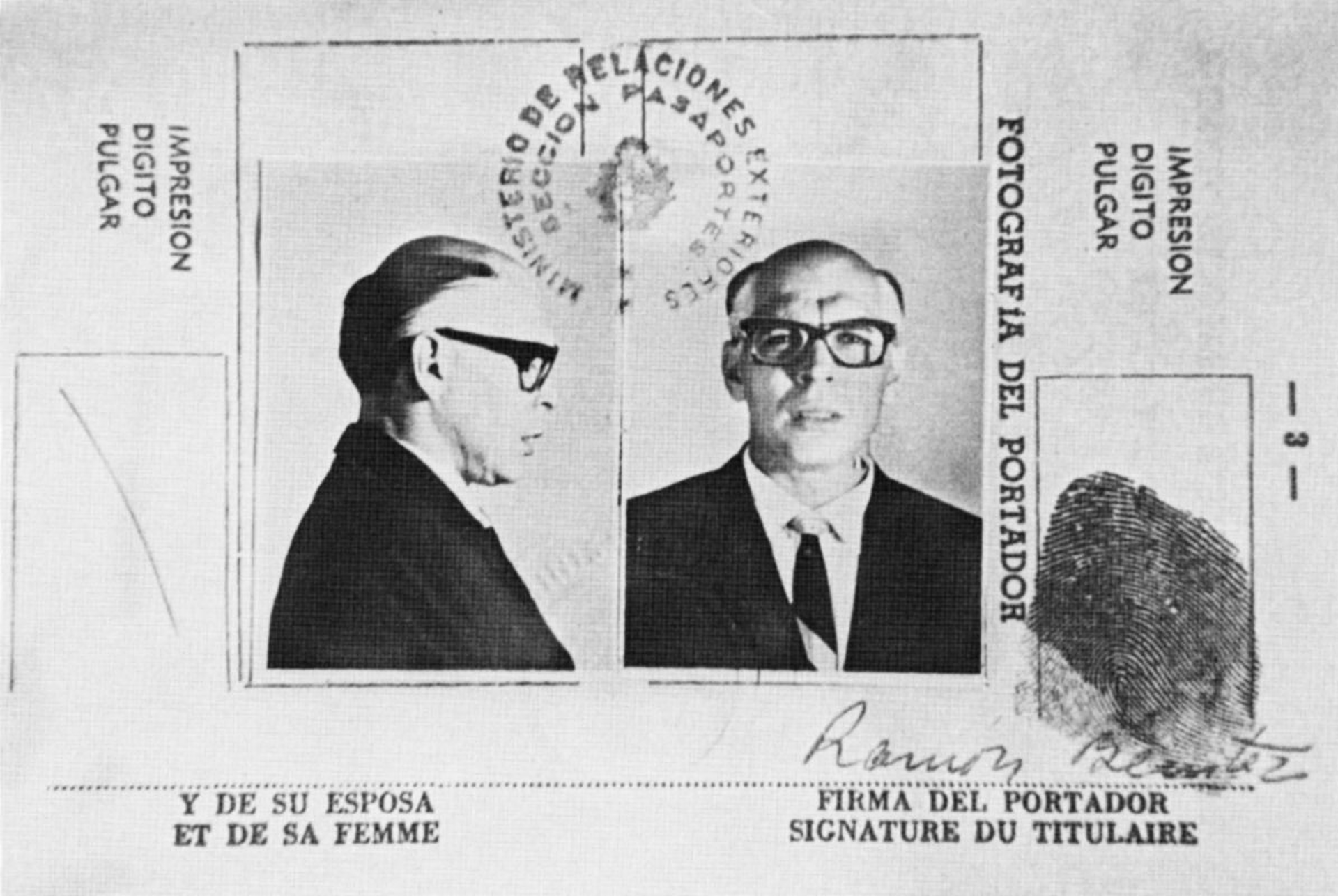 Guevara's 1966 passport featuring him in disguise with a false name In late 1966, Guevara's location was still not public knowledge, although representatives of Mozambique's independence movement, the FRELIMO, reported that they met with Guevara in Dar es Salaam regarding his offer to aid in their revolutionary project, an offer which they ultimately rejected.[258] In a speech at the 1967 International Workers' Day rally in Havana, the acting minister of the armed forces, Major Juan Almeida Bosque, announced that Guevara was "serving the revolution somewhere in Latin America".[259] In his book Opération Condor published in 2020, French journalist Pablo Daniel Magee reconstitutes the first incursion of Che Guevara in Bolivia on 3 October 1966, based on top-secret documents kept in the UNESCO protected Archives of Terror in Paraguay. Before he departed for Bolivia, Guevara altered his appearance by shaving off his beard and much of his hair, also dying it grey so that he was unrecognizable as Che Guevara.[260] On 3 November 1966, Guevara secretly arrived in La Paz on a flight from Montevideo, under the false name Adolfo Mena González, posing as a middle-aged Uruguayan businessman working for the Organization of American States.[261] Three days after his arrival in Bolivia, Guevara left La Paz for the rural south east region of the country to form his guerrilla army. Guevara's first base camp was located in the montane dry forest in the remote Ñancahuazú region. Training at the camp in the Ñancahuazú valley proved to be hazardous, and little was accomplished in way of building a guerrilla army. The Argentine-born East German operative Tamara Bunke, better known by her nom de guerre "Tania", had been installed as Che's primary agent in La Paz.[262][263] |
ボリビアの反乱 ボリビアへの出発  ゲバラの1966年のパスポート。偽名で変装した姿が写っている。 1966年後半、ゲバラの所在は依然として公には知られていなかったが、モザンビークの独立運動組織FRELIMOの代表者は、ゲバラがダルエスサラーム で彼らの革命プロジェクトへの支援を申し出たことを報告した。この申し出は最終的に拒否された。[258] 1967年のハバナでの国際労働者デーの集会で、武装勢力担当の代行大臣、フアン・アルメダ・ボスケ大佐は、ゲバラが「ラテンアメリカのある場所で革命に 従事している」と発表した。[259] 2020年に出版されたフランス人ジャーナリスト、パブロ・ダニエル・マギーの著書『オペレーション・コンドル』では、パラグアイのユネスコ保護下にある 「テロのアーカイブ」に保管されている極秘文書を基に、1966年10月3日にゲバラがボリビアに初めて潜入した経緯が再構成されている。 ボリビアへ向かう前に、ゲバラは髭と髪の毛の大部分を剃り落とし、灰色に染めて、チェ・ゲバラと認識できないように外見を変えた。[260] 1966年11月3日、ゲバラはモンテビデオ発の便でラパスに秘密裏に到着し、偽名「アドolfo・メナ・ゴンサレス」を名乗り、アメリカ州機構 (OAS)で働くウルグアイ人の中年実業家として偽装した。[261] ボリビア到着から3日後、ゲバラはゲリラ軍を結成するため、ラパスを離れ、国の南東部の農村地帯に向かった。ゲバラの最初の基地は、人里離れたニャンカワ ズー地域の山岳乾燥林の中にあった。ニャンカハズー渓谷のキャンプでの訓練は危険を伴い、ゲリラ軍の編成はほとんど進展しなかった。アルゼンチン生まれの 東ドイツの工作員タマラ・ブンケ(通称「タニア」)が、ラ・パスのチェの主要エージェントとして配置されていた。[262][263] |
| Ñancahuazú Guerrilla Main article: Ñancahuazú Guerrilla 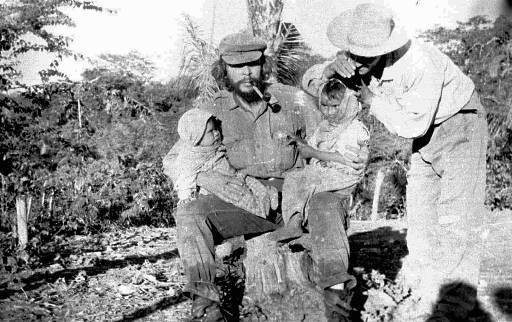 Guevara in rural Bolivia, shortly before his death (1967) Guevara's guerrilla force, numbering about 50 men[264] and operating as the ELN (Ejército de Liberación Nacional de Bolivia, "National Liberation Army of Bolivia"), was well equipped and scored a number of early successes against Bolivian army regulars in the difficult terrain of the mountainous Camiri region during the early months of 1967. As a result of Guevara's units winning several skirmishes against Bolivian troops in the spring and summer of 1967, the Bolivian government began to overestimate the true size of the guerrilla force.[265] Researchers hypothesize that Guevara's plan for fomenting a revolution in Bolivia failed for an array of reasons: Guevara had expected assistance and cooperation from the local dissidents that he did not receive, nor did he receive support from Bolivia's Communist Party under the leadership of Mario Monje, which was oriented toward Moscow rather than Havana. In Guevara's own diary captured after his death, he wrote about the Communist Party of Bolivia, which he characterized as "distrustful, disloyal and stupid".[266] He had expected to deal only with the Bolivian military, who were poorly trained and equipped, and was unaware that the United States government had sent a team of the CIA's Special Activities Division commandos and other operatives into Bolivia to aid the anti-insurrection effort. The Bolivian Army was also trained, advised, and supplied by US Army Special Forces, including an elite battalion of US Rangers trained in jungle warfare that set up camp in La Esperanza, a small settlement close to the location of Guevara's guerrillas.[267] He had expected to remain in radio contact with Havana. The two shortwave radio transmitters provided to him by Cuba were faulty. Thus, the guerrillas were unable to communicate and be resupplied, leaving them isolated and stranded.[268] In addition, Guevara's known preference for confrontation rather than compromise, which had previously surfaced during his guerrilla warfare campaign in Cuba, contributed to his inability to develop successful working relationships with local rebel leaders in Bolivia, just as it had in the Congo.[269] This tendency had existed in Cuba, but had been kept in check by the timely interventions and guidance of Fidel Castro.[270] The result was that Guevara was unable to attract inhabitants of the local area to join his militia during the eleven months he attempted recruitment. Many of the inhabitants willingly informed the Bolivian authorities and military about the guerrillas and their movements in the area. Near the end of the Bolivian venture, Guevara wrote in his diary: "Talking to these peasants is like talking to statues. They do not give us any help. Worse still, many of them are turning into informants."[271] Félix Rodríguez, a Cuban exile turned CIA Special Activities Division operative, advised Bolivian troops during the hunt for Guevara in Bolivia.[272] In addition, the 2007 documentary My Enemy's Enemy alleges that Nazi war criminal Klaus Barbie advised and possibly helped the CIA orchestrate Guevara's eventual capture.[273] |
ニャンカハズー・ゲリラ 主な記事:ニャンカハズー・ゲリラ  死の直前のボリビアの農村部でゲバラ (1967年) ゲバラのゲリラ部隊は、約 50 人の兵員[264] を擁し、ELN (Ejército de Liberación Nacional de Bolivia、ボリビア民族解放軍) として活動していた。この部隊は、1967 年の初め、山岳地帯のカミリ地方という困難な地形の中で、ボリビア正規軍に対して数々の戦果をあげた。1967年の春から夏にかけて、ゲバラの部隊がボリ ビア軍との小競り合いで数回の勝利を収めた結果、ボリビア政府はゲリラ部隊の実際の規模を過大評価し始めた[265]。 研究者たちは、ゲバラのボリビア革命計画が失敗した理由は、さまざまな要因が絡み合ったためだと推測している。 ゲバラは、現地の反体制派からの支援と協力を期待していたが、それは実現しなかった。また、ハバナよりもモスクワに親しいマリオ・モンヘ率いるボリビア共 産党からの支援も得られなかった。ゲバラの死後、発見された彼の日記には、ボリビア共産党について「不信感に満ち、不誠実で愚か」と記されている。 [266] 彼は、訓練も装備も不十分なボリビア軍だけと戦うことを想定しており、米国政府が反乱鎮圧のために CIA の特別活動部門コマンド部隊やその他の工作員をボリビアに派遣していることを知らなかった。ボリビア軍は、アメリカ陸軍特殊部隊によって訓練され、助言を 受け、物資を供給されていた。その中には、ジャングル戦術を訓練されたアメリカ陸軍レンジャーの精鋭部隊が、ゲバラのゲリラ部隊の拠点に近い小さな集落 ラ・エスペランサにキャンプを張っていた。[267] 彼はハバナとの無線連絡を維持できると考えていた。キューバから提供された2台の短波ラジオ送信機は故障していた。そのため、ゲリラは通信や補給が不可能となり、孤立無援の状態に陥った。[268] さらに、ゲバラが妥協よりも対立を好む性格であることは、キューバでのゲリラ戦でも明らかになっていたが、この性格が、コンゴと同様に、ボリビアの現地の 反乱指導者たちとの協力関係を築くことができなかった要因となった。[269] この傾向はキューバでも存在したが、フィデル・カストロのタイムリーな介入と指導によって抑制されていた。[270] その結果、ゲバラは11か月にわたる募集活動の中で、地元住民を民兵に勧誘することができなかった。多くの住民は、ボリビア当局と軍にゲリラの動向を積極 的に通報した。ボリビアでの活動終盤、ゲバラは日記に次のように記した:「これらの農民と話すのは、像と話すようなものだ。彼らは私たちに何の助けも与え ない。さらに悪いことに、多くが密告者に転向している。」[271] キューバの亡命者でCIA特殊活動部員となったフェリックス・ロドリゲスは、ボリビアでのゲバラの捜索中にボリビア軍に助言した。[272] さらに、2007年のドキュメンタリー『マイ・エネミー・エンemy』は、ナチス戦犯クラウス・バービーがCIAに助言し、ゲバラの最終的な捕獲を画策し た可能性があると主張している。[273] |
| Capture On 7 October 1967, an informant apprised the Bolivian Special Forces of the location of Guevara's guerrilla encampment in the Yuro ravine.[274] On the morning of 8 October, they encircled the area with two companies numbering 180 soldiers and advanced into the ravine, triggering a battle where Guevara was wounded and taken prisoner while leading a detachment with Simeon Cuba Sarabia.[275] Che's biographer Jon Lee Anderson reports Bolivian Sergeant Bernardino Huanca's account: that as the Bolivian Rangers approached, a twice-wounded Guevara, his gun rendered useless, threw up his arms in surrender and shouted to the soldiers: "Do not shoot! I am Che Guevara and I am worth more to you alive than dead."[276] Guevara was tied up and taken to a dilapidated mud schoolhouse in the nearby village of La Higuera on the evening of 8 October. For the next half-day, Guevara refused to be interrogated by Bolivian officers and only spoke quietly to Bolivian soldiers. One of those Bolivian soldiers, a helicopter pilot named Jaime Nino de Guzman, describes Che as looking "dreadful". According to Guzman, Guevara was shot through the right calf, his hair was matted with dirt, his clothes were shredded, and his feet were covered in rough leather sheaths. Despite his haggard appearance, he recounts that "Che held his head high, looked everyone straight in the eyes and asked only for something to smoke." De Guzman states that he "took pity" and gave him a small bag of tobacco for his pipe, and that Guevara then smiled and thanked him.[277] Later on the night of 8 October, Guevara—despite having his hands tied—kicked a Bolivian army officer, named Captain Espinosa, against a wall after the officer entered the schoolhouse and tried to snatch Guevara's pipe from his mouth as a souvenir while he was still smoking it.[278] In another instance of defiance, Guevara spat in the face of Bolivian Rear Admiral Horacio Ugarteche, who attempted to question Guevara a few hours before his execution.[278] The following morning on 9 October, Guevara asked to see the school teacher of the village, a 22-year-old woman named Julia Cortez. She later stated that she found Guevara to be an "agreeable looking man with a soft and ironic glance" and that during their conversation she found herself "unable to look him in the eye" because his "gaze was unbearable, piercing, and so tranquil".[278] During their short conversation, Guevara pointed out to Cortez the poor condition of the schoolhouse, stating that it was "anti-pedagogical" to expect campesino students to be educated there, while "government officials drive Mercedes cars"; Guevara said "that's what we are fighting against".[278] |
捕獲 1967年10月7日、情報提供者がゲバラのゲリラの野営地の場所をボリビア特殊部隊に知らせた。[274] 10月8日の朝、180人の兵士からなる2個大隊が、この地域を包囲し、渓谷に進入、戦闘が開始され、ゲバラは、シメオン・キューバ・サラビアとともに分 隊を率いて、負傷し、捕虜となった。[275] チェの伝記作家ジョン・リー・アンダーソンは、ボリビアの軍曹ベルナルディーノ・ワンカの話として、ボリビアのレンジャーズが近づくと、2度負傷し、銃も 使えなくなったゲバラは、両手を上げて降伏し、兵士たちに「撃たないで!私はチェ・ゲバラだ。私は死んでいるよりも生きているほうがあなたたちにとって価 値がある」と叫んだと伝えている。[276] ゲバラは縛られ、10月8日の夕方、近くの村ラ・イゲラにある荒廃した泥の校舎に連行された。その後半日、ゲバラはボリビア軍将校の尋問を拒否し、ボリビ ア兵たちにだけ静かに話しかけていた。そのボリビア兵の一人、ヘリコプターのパイロット、ハイメ・ニーニョ・デ・グズマンは、チェの様子を「恐ろしい」と 表現している。グスマンによると、ゲバラは右のふくらはぎを撃たれ、髪は泥で固まり、服は破れ、足は粗い革のカバーで覆われていた。しかし、その衰弱した 姿にもかかわらず、彼は「チェは頭を高く持ち、全員をまっすぐに見つめ、ただタバコを吸うためのものを求めた」と述べています。デ・グスマンは「同情し た」と述べ、パイプ用の小さなタバコ袋を渡し、ゲバラは微笑んで感謝した。[277] 10月8日の夜遅く、ゲバラは手足を縛られた状態にもかかわらず、学校に侵入し、彼がまだ吸っていたパイプを戦利品として奪おうとしたボリビア軍大尉エス ピノサを壁に蹴り飛ばした。[278] 別の反抗の事例として、ゲバラは、処刑の数時間前に彼に質問を試みたボリビアのホラシオ・ウガルテチェ少将の顔に唾を吐いた。[278] 10月9日の朝、ゲバラは村の学校教師である22歳の女性ジュリア・コルテスに会いたいと申し出た。彼女は後で、ゲバラを「穏やかで皮肉な目をした好印象 の男性」と述べ、会話中、彼の「耐え難く、突き刺すような、しかし非常に穏やかな視線」のため「彼と目を合わせられなかった」と語った。[278] 短い会話の中で、ゲバラはコルテスに学校の劣悪な状態を指摘し、農民の生徒をそこで教育することを「反教育的なこと」だと述べ、一方「政府高官はメルセデ スを運転している」と指摘した。ゲバラは「それが私たちが戦っているものだ」と述べた。[278] |
| Execution order Later on the morning of 9 October, Bolivian President René Barrientos ordered that Guevara be killed. The order was relayed to the unit holding Guevara by Félix Rodríguez, reportedly despite the United States government's desire that Guevara be taken to Panama for further interrogation.[279] The executioner who volunteered to kill Guevara was Mario Terán, a 27-year-old sergeant in the Bolivian army who, while half-drunk, requested to shoot Guevara because three of his friends from B Company, all with the same first name of "Mario", had been killed in a firefight several days earlier with Guevara's band of guerrillas.[11] To make the bullet wounds appear consistent with the story that the Bolivian government planned to release to the public, Félix Rodríguez ordered Terán not to shoot Guevara in the head, but to aim carefully to make it appear that Guevara had been killed in action during a clash with the Bolivian army.[280] Gary Prado Salmón, the Bolivian captain in command of the army company that captured Guevara, said that the reasons Barrientos ordered the immediate execution of Guevara were so there could be no possibility for Guevara to escape from prison, and also so there could be no drama of a public trial where adverse publicity might happen.[281] |
処刑命令 10月9日の午前中、ボリビアのレネ・バリエントス大統領はゲバラを殺害するよう命じた。この命令は、米国政府がゲバラをパナマに連行してさらに尋問する ことを望んでいたにもかかわらず、フェリックス・ロドリゲスによってゲバラを拘束していた部隊に伝えられた。[279] グエバラの処刑を志願したのは、ボリビア軍の大尉で27歳のマリオ・テランだった。彼は半酔いの状態で、B中隊の同じ名前「マリオ」を持つ3人の友人が数 日前にグエバラのゲリラ部隊との銃撃戦で殺されたため、グエバラを射殺するよう求めた。[11] ボリビア政府が公表する計画に沿った銃創の痕跡を作るため、フェリックス・ロドリゲスはテランにゲバラの頭を撃たないよう命じ、代わりにボリビア軍との交 戦で戦死したように見せかけるよう慎重に狙うよう指示した。[280] ゲバラを捕らえたボリビア軍部隊の指揮官だったゲイリー・プラド・サルモン大尉は、バリエンツォスがゲバラの即時処刑を命じた理由は、ゲバラが刑務所から 脱走する可能性を完全に排除するため、そして不利な報道がされる可能性のある公開裁判のドラマを避けるためだったと述べた。[281] |
| Death Execution 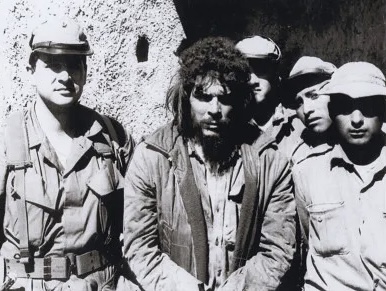 Guevara shortly before his execution, with CIA officer Félix Rodríguez (left) About 30 minutes before Guevara was killed, Félix Rodríguez attempted to question him about the whereabouts of other guerrilla fighters who were currently at large, but Guevara continued to remain silent. Rodríguez, assisted by a few Bolivian soldiers, helped Guevara to his feet and took him outside the hut to parade him before other Bolivian soldiers where he posed with Guevara for a photo opportunity where one soldier took a photograph of Rodríguez and other soldiers standing alongside Guevara. Afterwards, Rodríguez told Guevara that he was going to be executed. A little later, Guevara was asked by one of the Bolivian soldiers guarding him if he was thinking about his own immortality. "No" he replied, "I'm thinking about the immortality of the revolution".[282] A few minutes later, Sergeant Terán entered the hut to shoot him, whereupon Guevara reportedly stood up and spoke to Terán what were his last words: "I know you've come to kill me. Shoot, coward! You are only going to kill a man!" Terán hesitated, then pointed his self-loading M2 carbine[283] at Guevara and opened fire, hitting him in the arms and legs.[284] Then, as Guevara writhed on the ground, apparently biting one of his wrists to avoid crying out, Terán fired another burst, fatally wounding him in the chest. Guevara was pronounced dead at 1:10 p.m. local time according to Rodríguez.[284] In all, Guevara was shot nine times by Terán. This included five times in his legs, once in the right shoulder and arm, and once in the chest and throat.[278] Months earlier, during his last public declaration to the Tricontinental Conference,[228] Guevara had written his own epitaph, stating: "Wherever death may surprise us, let it be welcome, provided that this our battle cry may have reached some receptive ear and another hand may be extended to wield our weapons."[285] |
死 処刑  処刑直前のゲバラとCIA工作員フェリックス・ロドリゲス(左) ゲバラが殺害される約30分前、フェリックス・ロドリゲスは、現在逃亡中の他のゲリラ兵の行方をゲバラに尋ねようとしたが、ゲバラは黙ったままだった。ロ ドリゲスは数人のボリビア兵の助けを借りてゲバラを立たせ、小屋の外に連れ出し、他のボリビア兵の前でパレードさせた。その際、ゲバラと共に写真撮影の機 会が設けられ、1人の兵士がロドリゲスとゲバラの隣に立つ兵士たちの写真を撮影したあ。その後、ロドリゲスはゲバラに処刑されることを告げた。少し後、ゲ バラは彼を監視していたボリビア兵の一人から、自分の不滅について考えているかと尋ねられた。「いいえ」と彼は答えた。「私は革命の不滅について考えてい る」[282]。数分後、テラン軍曹が小屋に入り、ゲバラを射殺しようとした。その際、ゲバラは立ち上がり、テランに最後の言葉を述べた:「お前は私を殺 しに来たことを知っている。撃て、臆病者!お前はただ一人の男を殺すだけだ!」テランは躊躇したが、その後、ゲバラに向け自己装填式M2カービン銃 [283]を向け発砲し、彼の腕と脚を撃った。[284] その後、ゲバラが地面でもがき、叫び声を抑えるために腕の一つを噛みしめているように見えた時、テランは再び発砲し、胸を致命傷を負わせた。ゲバラは現地 時間午後1時10分に死亡が宣告された[284]。テランによってゲバラは合計9発撃たれた。そのうち5発は脚に、1発は右肩と腕に、1発は胸と喉に命中 した。[278] 数ヶ月前、トリコンティネンタル会議での最後の公の声明の中で[228]、ゲバラは自分の墓碑銘を次のように書いていた。「死が私たちをどこで驚かせよう とも、この私たちの戦いの叫びが、受け入れる耳に届き、私たちの武器を振るう別の手が差し伸べられるなら、それを歓迎しよう。」[285] |
Aftermath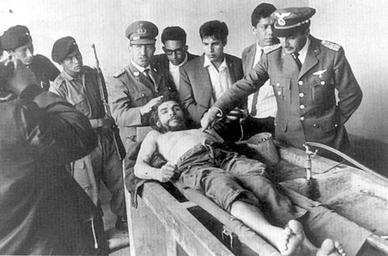 The day after his execution on 10 October 1967, Guevara's corpse was displayed to the news media in the laundry house of the Vallegrande hospital (photo by Freddy Alborta [es]). Face Side angle Shoes After his execution, Guevara's body was lashed to the landing skids of a helicopter and flown to nearby Vallegrande, where photographs were taken of him lying on a concrete slab in the laundry room of the Nuestra Señora de Malta.[286] Several witnesses were called to confirm his identity, key amongst them the British journalist Richard Gott, the only witness to have met Guevara when he was alive. Put on display, as hundreds of local residents filed past the body, Guevara's corpse was considered by many to represent a "Christ-like" visage, with some even surreptitiously clipping locks of his hair as divine relics.[287] Such comparisons were further extended when English art critic John Berger, two weeks later upon seeing the post-mortem photographs, observed that they resembled two famous paintings: Rembrandt's The Anatomy Lesson of Dr. Nicolaes Tulp and Andrea Mantegna's Lamentation over the Dead Christ.[288] There were also four correspondents present when Guevara's body arrived in Vallegrande, including Björn Kumm of the Swedish Aftonbladet, who described the scene in an 11 November 1967 exclusive for The New Republic.[289] A declassified memorandum dated 11 October 1967 to United States President Lyndon B. Johnson from his National Security Advisor Walt Rostow, called the decision to kill Guevara "stupid" but "understandable from a Bolivian standpoint".[290] After the execution, Rodríguez took several of Guevara's personal items, including a watch which he continued to wear many years later, often showing them to reporters during the ensuing years.[291] Today, some of these belongings, including his flashlight, are on display by the CIA.[292] After a military doctor dismembered his hands, Bolivian army officers transferred Guevara's body to an undisclosed location and refused to reveal whether his remains had been buried or cremated. The hands were sent to Buenos Aires for fingerprint identification. They were later sent to Cuba.[293] Also removed when Guevara was captured were his 30,000-word, hand-written diary, a collection of his personal poetry, and a short story he had authored about a young communist guerrilla who learns to overcome his fears.[294] His diary documented events of the guerrilla campaign in Bolivia,[295] with the first entry on 7 November 1966, shortly after his arrival at the farm in Ñancahuazú, and the last dated 7 October 1967, the day before his capture. The diary tells how the guerrillas were forced to begin operations prematurely because of discovery by the Bolivian Army, explains Guevara's decision to divide the column into two units that were subsequently unable to re-establish contact, and describes their overall unsuccessful venture. It also records the rift between Guevara and the Communist Party of Bolivia that resulted in Guevara having significantly fewer soldiers than originally expected, and shows that Guevara had a great deal of difficulty recruiting from the local populace, partly because the guerrilla group had learned Quechua, unaware that the local language was actually a Tupi–Guarani language.[296] As the campaign drew to an unexpected close, Guevara became increasingly ill. He endured ever-worsening bouts of asthma, and most of his last offensives were carried out in an attempt to obtain medicine.[297] The Bolivian diary was quickly and crudely translated by Ramparts magazine and circulated around the world.[298] There are at least four additional diaries in existence—those of Israel Reyes Zayas (Alias "Braulio"), Harry Villegas Tamayo ("Pombo"), Eliseo Reyes Rodriguez ("Rolando"),[262] and Dariel Alarcón Ramírez ("Benigno")[299]—each of which reveals additional aspects of the events. French intellectual Régis Debray, who was captured in April 1967 while with Guevara in Bolivia, gave an interview from prison in August 1968, in which he enlarged on the circumstances of Guevara's capture. Debray, who had lived with Guevara's band of guerrillas for a short time, said that in his view they were "victims of the forest" and thus "eaten by the jungle".[300] Debray described a destitute situation where Guevara's men suffered malnutrition, lack of water, absence of shoes, and only possessed six blankets for 22 men. Debray recounts that Guevara and the others had been suffering an "illness" which caused their hands and feet to swell into "mounds of flesh" to the point where you could not discern the fingers on their hands. Debray described Guevara as "optimistic about the future of Latin America" despite the futile situation, and remarked that Guevara was "resigned to die in the knowledge that his death would be a sort of renaissance", noting that Guevara perceived death "as a promise of rebirth" and "ritual of renewal".[300] |
その後 1967年10月10日の処刑の翌日、ゲバラの遺体はバレグランデ病院の洗濯場で報道陣に公開された(写真:フレディ・アルボルタ [es])。 顔 側面 靴 処刑後、ゲバラの遺体はヘリコプターの着陸脚に縛り付けられ、近くのヴァレグランデに運ばれた。そこで、ヌエストラ・セニョーラ・デ・マルタの洗濯室のコ ンクリートの上に横たわる彼の写真が撮影された[286]。彼の身元を確認するために複数の目撃者が呼ばれ、その中には、ゲバラが生きていたときに唯一 会ったことのある英国人ジャーナリスト、リチャード・ゴットもいた。数百人の地元住民が遺体の前を通り過ぎる中、ゲバラの遺体は「キリストのような顔」と みなされ、一部の人々は彼の髪の毛を神聖な遺物として密かに切り取った。[287] こうした比較はさらに広がり、2週間後に死後写真を見た英国の美術批評家ジョン・バーガーは、その姿がレンブラントの『ニコラース・ティルプの解剖学』と アンドレア・マンテーニャの『死のキリストの嘆き』という2つの著名な絵画に似ていると指摘した。[288] グエバラの遺体がヴァレグランデに到着した際、スウェーデンの『アフトンブラデット』紙のビョルン・クムを含む4人の記者が現場にいた。クムは1967年 11月11日の『ザ・ニュー・リパブリック』の独占記事でその場面を記述した。[289] 1967年10月11日付の、リンドン・B・ジョンソン米国大統領宛て、ウォルト・ロストウ国家安全保障問題担当大統領補佐官による機密解除された覚書では、ゲバラを殺害する決定は「愚かな」ものであるが、「ボリビアの立場からは理解できる」と述べられている。[290] 処刑後、ロドリゲスはゲバラの私物の中から、彼がその後何年も着用し続け、その後の数年間、記者たちにしばしば見せていた時計など、いくつかの持ち物を持 ち帰った。[291] 現在、これらの遺品の一部、特に懐中電灯はCIAによって展示されている。[292] 軍医がゲバラの手を切り離した後、ボリビア軍将校は彼の遺体を未公開の場所に移送し、遺体が埋葬されたか火葬されたかを明かさなかった。手は指紋鑑定のた めブエノスアイレスに送られ、後にキューバに送られた。[293] ゲバラが捕らえられた際、3万語の手書きの日記、彼の個人的な詩集、そして恐怖を克服する若い共産主義のゲリラを描いた彼が書いた短編小説も持ち去られ た。[294] 日記にはボリビアでのゲリラ戦線の出来事が記録されており、[295] 最初のエントリーは1966年11月7日、ニャンカハズーの農場に到着直後のもの、最後のエントリーは1967年10月7日、捕獲の前日となっている。日 記には、ボリビア軍に発見されたためゲリラが作戦を早期に開始せざるを得なくなった経緯、ゲバラが部隊を2つの小隊に分割したものの、その後連絡を回復で きなかった理由、そして全体として失敗に終わった作戦の経緯が記されている。また、ゲバラとボリビア共産党の対立により、ゲバラが当初予想していたよりも 大幅に少ない兵力を有していたこと、ゲバラが現地住民からの募集に大きな困難を覚えたこと(ゲリラグループが現地の言語がトゥピ・グアラニ語ではなくケ チュア語であると知らなかったため)も記録されている。[296] キャンペーンが予期せぬ終結に近づくにつれ、ゲバラの健康状態は悪化していった。彼はますます悪化する喘息の発作に耐え、最後の攻撃の大部分は薬を入手す るための試みとして行われた。[297] ボリビアの日記は、ランパーツ誌によって急いで粗雑に翻訳され、世界中に広まった。[298] 現存する日記は少なくとも4冊あり、イスラエル・レイエス・ヤス(通称「ブラウリオ」)、ハリー・ヴィレガス・タマヨ(「ポンボ」)、エリセオ・レイエ ス・ロドリゲス(「ロランド」)、[262] ダリエル・アラコン・ラミレス(「ベニグノ」)[299] のものがあり、それぞれが事件の新たな側面を明らかにしている。 1967年4月にゲバラと共にボリビアで捕らえられたフランスの知識人レジス・デブレイは、1968年8月に獄中からインタビューに応じ、ゲバラの捕獲の 経緯について詳細に語った。ゲバラのゲリラ集団と短期間過ごしたデブレは、彼らを「森の犠牲者」であり、「ジャングルに食われた」と表現している [300]。デブレは、ゲバラの部下たちが栄養失調、水不足、靴の欠如に苦しみ、22 人で 6 枚の毛布しか持たないという悲惨な状況について述べている。デブレは、ゲバラたちは「病気」に苦しみ、手と足が「肉の塊」のように腫れ上がり、手の指が区 別できないほどだったと語っている。デブレは、この絶望的な状況にもかかわらず、ゲバラは「ラテンアメリカの将来について楽観的」であり、「自分の死は一 種のルネサンスになる」と認識し、「死を再生の約束」および「再生の儀礼」と捉えていたと述べています[300]。 |
| Commemoration in Cuba On 15 October in Havana, Fidel Castro publicly acknowledged that Guevara was dead and proclaimed three days of public mourning throughout Cuba.[301] On 18 October, Castro addressed a crowd of one million mourners in Havana's Plaza de la Revolución and spoke about Guevara's character as a revolutionary.[302] Castro remarked about Guevarism's legacy:[303] ...those who sing victory are wrong. Those who believe his death is the defeat of his ideas, the defeat of his tactics, the defeat of his guerrilla conceptions, and the defeat of his thesis are mistaken. Because that man who fell as a mortal man, as a man who was exposed many times to bullets, as a soldier, as a leader, is a thousand times more capable than those who killed him with a stroke of luck. Fidel Castro closed his impassioned eulogy saying: If we wish to express what we want the men of future generations to be, we must say: Let them be like Che! If we wish to say how we want our children to be educated, we must say without hesitation: We want them to be educated in Che's spirit! If we want the model of a man, who does not belong to our times but to the future, I say from the depths of my heart that such a model, without a single stain on his conduct, without a single stain on his action, is Che![304] |
キューバでの追悼 10月15日、ハバナで、フィデル・カストロはゲバラの死を公に認め、キューバ全土で3日間の公の喪に服すことを宣言した[301]。10月18日、カス トロはハバナの革命広場(Plaza de la Revolución)に集まった100万人の弔問者に演説し、ゲバラの革命家としての性格について語った[302]。カストロはゲヴァリズムの遺産につ いて次のように述べた[303]。 …勝利を歌う者は間違っている。彼の死が彼の思想の敗北、彼の戦術の敗北、彼のゲリラ戦術の敗北、彼の主張の敗北だと信じる者は間違っている。なぜなら、 人間として、何度も銃弾にさらされた人間として、兵士として、指導者として倒れたその男は、幸運の一撃で彼を殺した者たちよりも千倍も優れているからだ。 フィデル・カストロは、熱烈な追悼の辞を次のように締めくくった: もし私たちが、未来の世代の人々にどうなってほしいかを表現したいのであれば、こう言わなければならない:彼らをチェのように育てよう!もし私たちが、子 供たちをどのように教育したいかを表現したいのであれば、ためらうことなくこう言わなければならない:彼らをチェの精神で教育しよう!もし私たちが、私た ちの時代ではなく未来に属する男の模範を望むなら、私は心の底から言う。そのような模範は、行動に一点の汚れもなく、行動に一点の汚れもない、チェだ! [304] |
International commemoration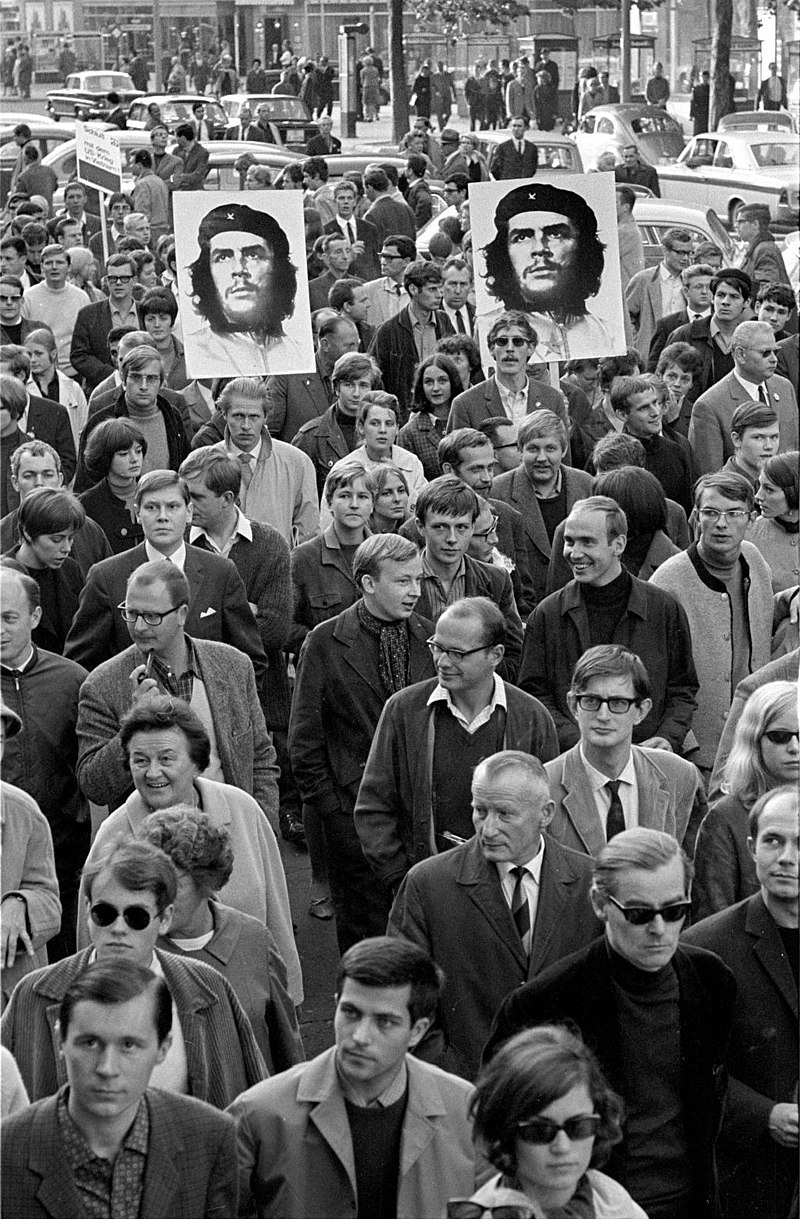 Portraits of Che Guevara at a march during the West German student movement After pictures of the dead Guevara began being circulated and the circumstances of his death were being debated, Che's legacy began to spread. Demonstrations in protest against his "assassination" occurred throughout the world, and articles, tributes, and poems were written about his life and death.[305] Rallies in support of Guevara were held from "Mexico to Santiago, Algiers to Angola, and Cairo to Calcutta".[306] The population of Budapest and Prague lit candles to honor Guevara's passing, and the picture of a smiling Che appeared in London and Paris.[307] A few months later, riots broke out in Berlin, France, and Chicago, and the unrest spread to the American college campuses. Young men and women wore Che Guevara T-shirts and carried his pictures during their protest marches. In the view of military historian Erik Durschmied: "In those heady months of 1968, Che Guevara was not dead. He was very much alive."[308] Even in the United States, the government which Guevara so vigorously denounced, students began to emulate his style of dress, donning military fatigues, berets, and growing their hair and beards to show that they too were opponents of U.S. foreign policy.[309] For instance, the Black Panthers began to style themselves "Che-type" while adopting his trademark black beret, while Arab guerrillas began to name combat operations in his honor.[310] Radical left-wing activists responded to Guevara's apparent indifference to rewards and glory, and concurred with Guevara's sanctioning of violence as a necessity to instill socialist ideals.[311] |
国際的な追悼 西ドイツ学生運動中の行進で掲げられたチェ・ゲバラの肖像 ゲバラの死体の写真が流布し、彼の死の経緯が議論されるようになると、チェの遺産は広まり始めた。彼の「暗殺」に抗議するデモが世界中で起こり、彼の生涯 と死について記事、追悼文、詩が書かれた。[305] ゲバラを支援する集会が「メキシコからサンティアゴ、アルジェからアンゴラ、カイロからカルカッタ」まで開催された。[306] ブダペストとプラハの住民はゲバラの死を悼んでろうそくを灯し、ロンドンとパリには笑顔のゲバラの肖像画が現れた。[307] 数ヶ月後、ベルリン、フランス、シカゴで暴動が発生し、混乱はアメリカの大学キャンパスにも広がった。若者たちはゲバラのTシャツを着用し、彼の写真を掲 げて抗議行進を行った。軍事史家のエリック・デュルシュミードは次のように述べた:「1968年のあの熱狂的な数ヶ月間、チェ・ゲバラは死んでいなかっ た。彼は非常に生き生きとしていた。」[308] ゲバラが激しく非難したアメリカ政府下でも、学生たちは彼の服装を真似て軍服やベレー帽を着用し、髪やひげを伸ばして、自分たちもアメリカの外交政策に反 対していることを示し始めた。[309] 例えば、ブラックパンサー党は「チェ型」と自称し、彼のトレードマークである黒いベレー帽を採用し、アラブのゲリラは戦闘作戦に彼の名前を冠するように なった。[310] 過激な左派活動家は、ゲバラの報酬や栄光への無関心に共感し、社会主義の理想を植え付けるための必要悪として暴力の使用を正当化するゲバラの立場に同意し た。[311] |
| Legacy Main article: Legacy of Che Guevara Further information: Che Guevara in popular culture Ideology and policy in Cuba Further information: Military Units to Aid Production, Revolutionary Offensive, Rectification process, and Battle of Ideas 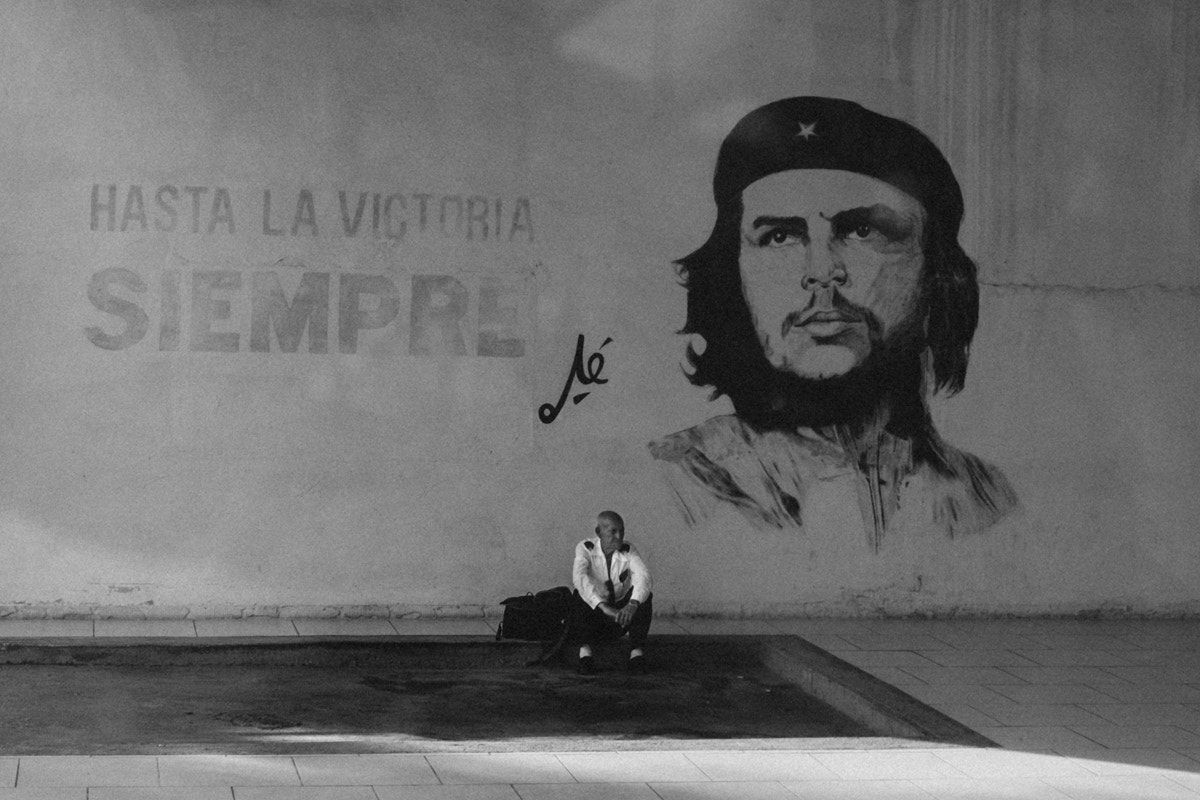 Portrait of Che Guevara, with quote, in Santa Clara, Cuba. Quote translates as: "Until victory, always". As early as 1965, the Yugoslav communist journal Borba observed the many half-completed or empty factories in Cuba, a legacy of Guevara's short tenure as Minister of Industries, "standing like sad memories of the conflict between pretension and reality".[312] The ethos of Guevara's "socialist new man": a citizen committed to self-sacrifice and asceticism, was still revered in Cuba after Guevara's departure. The definition of the "socialist new man" was often edited to justify certain labor programs. A famous utilization of the "new man" concept was in the labelling of certain sectors of the Cuban population as "anti-socials", who had fallen outside the "new man" concept. Between 1965 and 1968, these "anti-socials" were interned in UMAP labor camps.[313][314][315] In 1966, during Guevara's adventures abroad, the Cuban economy was reorganized on Guevarist moral lines. Cuban propaganda stressed voluntarism and ideological motivations to increase productions. Material incentives were not given to workers who were more productive than others.[316] Cuban intellectuals were expected to participate actively in creating a positive national ethos and ignore any desire to create "art for art's sake".[317] Guevara's death in 1967 precipitated the abandonment of guerrilla warfare as an instrument of Cuban foreign policy, ushering in a rapprochement with the Soviet Union, and the reformation of the government along Soviet lines. When Cuban troops returned to Africa in the 1970s, it was as part of a large-scale military expedition, and support for insurrection movements in Latin America and the Caribbean became logistical and organizational rather than overt. Cuba also abandoned Guevara's plans for economic diversification and rapid industrialization, which had ultimately proved to be impracticable in view of the country's incorporation into the Comecon system.[312] In 1968, the Cuban economy was remodeled, inspired by Guevara's arguments in the Great Debate, from years earlier. All non-agricultural private businesses was nationalized, central planning was done more on an ad-hoc basis, and the entire Cuban economy was directed at producing a 10 million ton sugar harvest.[318] The focus on sugar would eventually render all other facets of the Cuban economy underdeveloped and would be the ultimate legacy of the offensive.[316] A series of economic reforms in Cuba, officially titled the "Rectification of Errors and Negative Tendencies", were based in the economic ethos of Guevarism. The reforms began in 1986, and lasted until 1992. The policy changes were aimed at eliminating private businesses, trade markets, that had been introduced into the Cuban law and Cuban culture during the 1970s. The new reforms aimed to nationalize more of the economy and eliminate material incentives for extra labor, instead relying on moral enthusiasm alone. Castro often justified this return to moral incentives by mentioning the moral incentives championed by Che Guevara, and often alluded to Guevarism when promoting these reforms.[319][320][321] The economic reforms, and mass mobilizations, implemented during the Battle of Ideas (2000–2006), were often conducted in homage to the philosophy of Che Guevara. These reforms stressed economic voluntarism, central planning, and radical consciousness as a driver of the economy.[322] |
遺産 主な記事:チェ・ゲバラの遺産 詳細情報:大衆文化におけるチェ・ゲバラ キューバのイデオロギーと政策 詳細情報:生産支援軍事部隊、革命攻勢、是正プロセス、思想の戦い  キューバ、サンタ・クララにあるチェ・ゲバラの肖像画と引用文。引用文は「勝利まで、常に」と訳される。 1965年、ユーゴスラビアの共産主義誌『ボルバ』は、ゲバラが産業大臣として短期間在任した遺産のひとつである、多くの未完成または空っぽの工場につい て、「理想と現実の対立の悲しい記憶のように立ちはだかる」と指摘した。[312] ゲバラの「社会主義的新人間」の理念——自己犠牲と禁欲に捧げる市民——は、ゲバラの死後もキューバで崇敬されていた。この「社会主義的新人間」の定義 は、特定の労働プログラムを正当化するために頻繁に改変された。「新人類」概念の有名な利用例は、キューバの人口の特定の層を「反社会的」とラベル付けし たことだ。彼らは「新人類」概念から外れた存在とされた。1965年から1968年にかけて、これらの「反社会的」者はUMAP労働キャンプに収容され た。[313][314][315] 1966年、ゲバラが海外で冒険を繰り広げていた間、キューバ経済はゲバラ主義の道徳観に基づいて再編成された。キューバのプロパガンダは、生産性を高め るための自発的な行動とイデオロギー的な動機付けを強調した。他の労働者よりも生産性の高い労働者には、物質的なインセンティブは与えられなかった [316]。キューバの知識人は、前向きな国民的風土の形成に積極的に参加し、「芸術のための芸術」を創造したいという欲求は無視することが求められた。 [317] 1967年のゲバラの死は、キューバの外交政策の手段としてのゲリラ戦争の放棄を早め、ソ連との和解、そしてソ連型の政府改革をもたらした。1970年代 にキューバ軍がアフリカに再派遣された際は、大規模な軍事遠征の一環として行われ、ラテンアメリカとカリブ海地域の反乱運動への支援は、公然としたものか ら物流的・組織的な支援に転換された。キューバはまた、ゲバラの経済多角化と急速な工業化計画を放棄した。これらの計画は、キューバがコメコンシステムに 組み込まれた状況下では、最終的に実現不可能であることが明らかになったためだ。[312] 1968年、キューバ経済は、数年前のゲバラの「大討論」での主張に触発されて、再構築された。非農業の民間企業はすべて国有化され、中央計画はより臨機 応変に行われ、キューバ経済全体が1,000万トンの砂糖の収穫を目指した。[318] 砂糖への重点は、最終的にキューバ経済の他のすべての分野の発展を阻害し、この攻勢の最終的な遺産となる。 キューバで実施された一連の経済改革は、正式には「誤りと負の傾向の是正」と題され、ゲバラ主義の経済理念に基づいていた。改革は1986年に始まり、 1992年まで続いた。この政策変更は、1970年代にキューバの法律および文化に導入された民間企業や自由市場を排除することを目的としていた。新しい 改革は、経済の一層の国有化と、追加労働に対する物質的なインセンティブの排除を目指し、その代わりに道徳的な熱意のみに依存することにした。カストロ は、この道徳的インセンティブへの回帰を、チェ・ゲバラが提唱した道徳的インセンティブを引用して正当化し、これらの改革を推進する際には、しばしばゲ ヴァリズムをほのめかした。[319][320][321] 思想の戦い(2000年~2006年)中に実施された経済改革と大規模動員は、チェ・ゲバラの哲学に敬意を表して行われたことが多かった。これらの改革は、経済の推進力として、経済的ボランティア精神、中央計画、そして急進的な意識を強調していた。[322] |
| Ideology in Argentina Main article: Tendencia Revolucionaria 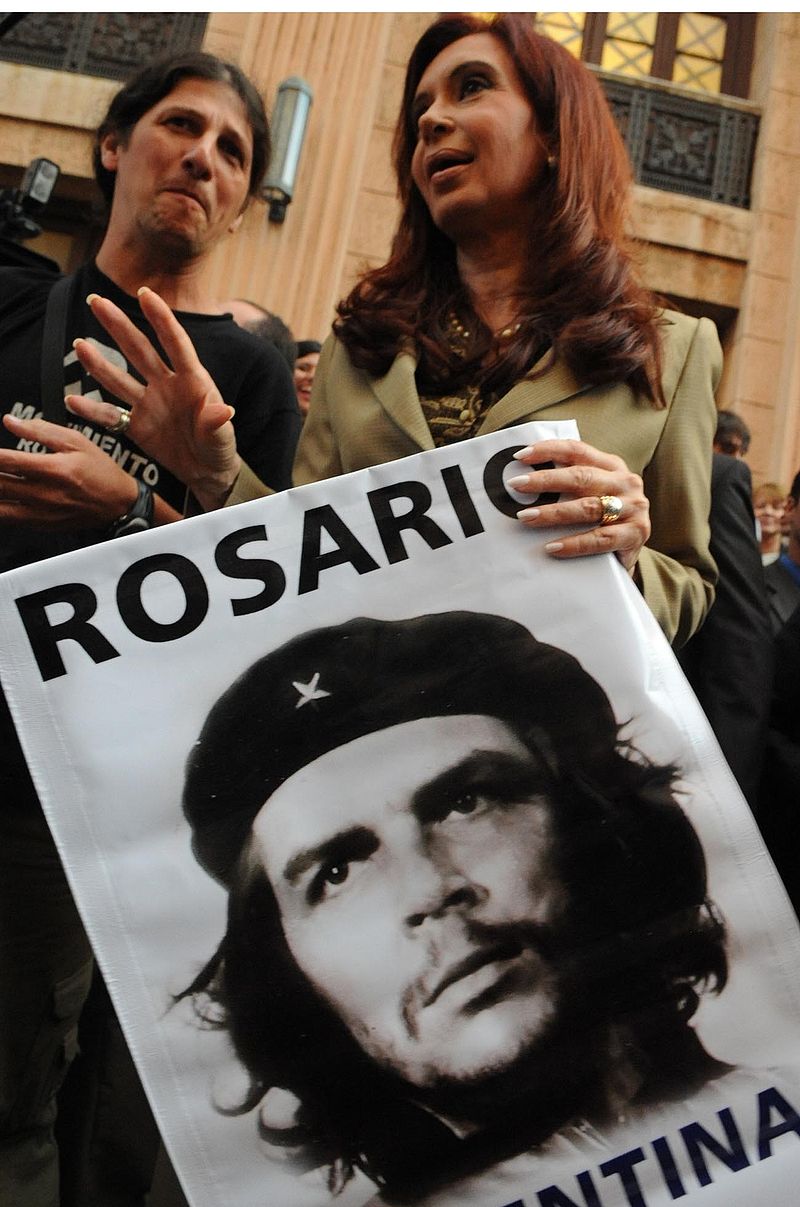 Former Argentine president Cristina Fernández de Kirchner with a poster of Che Guevara, 2009. Argentina felt the impact of the Cuban Revolution, as John William Cooke, a close associate of Perón who emerged as the main representative of the Peronist left, moved to Cuba in 1960. While in Cuba, Cooke associated Peronism with Fidelismo, and seeing the left-wing nationalism of Peronism and Marxism-Leninism of Fidelismo as complementary; he wrote:[323] Nowadays nobody thinks that national liberation can be achieved without social revolution and therefore the struggle is also [one] by the poor against the rich... Since national liberation is indivisible from social revolution, there is no bourgeois nationalism, for the bourgeoisie's objective was to 'privatize the lucre and socialize the sacrifices. Cooke's concept of mixing national liberation with social revolution became the core concept of a new "Revolutionary Peronism", and was embraced by Perón himself.[323] With the assistance of Cooke, Cuba opened a dialogue between the new Cuban government and Perón. Che Guevara appealed for unity amongst anti-imperialist forces in Latin America, and explicitly recognized Peronism as a fellow in the anti-imperialist movement.[324] Perón himself praised the Cuban Revolution and discussed the parallels it had with his own 'revolution', and would increasingly adapt the Cuban rhetoric throughout the 1960s. Che Guevara subsequently visited Perón in Madrid, and argued that Peronism is "a kind of indigenous Latin American socialism with which the Cuban Revolution could side". Perón maintained a close relationship with Guevara and paid homage to him upon his death in 1967, calling him "one of ours, perhaps the best" and remarking that Peronism: ...as a national, popular and revolutionary movement, pays homage to the idealist, the revolutionary, Comandante Ernesto Che Guevara, Argentine guerrilla dead in action taking up arms to seek the triumph of national revolutions in Latin America.[325] Che Guevara has continued to have a lasting impact on the Argentine left. When President Cristina Fernández de Kirchner made 24 March a holiday to remember the fall of the Argentine military dictatorship, the holiday was first celebrated by a mass parade of communist groups and trade unions, many waving banners displaying the face of Guevara.[326] |
アルゼンチンのイデオロギー 主な記事:革命傾向  2009年、チェ・ゲバラのポスターを掲げるアルゼンチンの元大統領、クリスティーナ・フェルナンデス・デ・キルチネル。 アルゼンチンは、ペロンの側近であり、ペロン主義左派の主要代表として台頭したジョン・ウィリアム・クックが1960年にキューバに移住したことで、 キューバ革命の影響を受けた。キューバ滞在中、クックはペロン主義とフィデル主義を結びつけ、ペロン主義の左翼ナショナリズムとフィデル主義のマルクス・ レーニン主義を補完的なものと見なし、次のように記している[323]。 今日、社会革命なしに民族解放は達成できないと考える人はいない。したがって、この闘争は、貧しい者たちによる富裕層に対する闘争でもある... 国民解放は社会革命と切り離せないため、ブルジョアジーの目標は「利権を民営化し、犠牲を社会化すること」であったため、ブルジョアナショナリズムは存在 しない。 クックが提唱した、国民解放と社会革命の融合という概念は、新しい「革命ペロニズム」の核となる概念となり、ペロン自身にも受け入れられた[323]。 クックの支援を受けて、キューバは新しいキューバ政府とペロンの間で対話を開始した。チェ・ゲバラはラテンアメリカにおける反帝国主義勢力の一致を呼びか け、ペロニズムを反帝国主義運動の同志として明示的に認めた。[324] ペロン自身もキューバ革命を称賛し、自身の「革命」との類似点を議論し、1960年代を通じてキューバの修辞を次第に採用していった。チェ・ゲバラはその 後、マドリードでペロンを訪問し、ペロン主義は「キューバ革命が支持できるような、ラテンアメリカ固有の社会主義の一種」だと主張した。ペロンはゲバラと 親密な関係を保ち、1967年に彼が死去した際には「私たちの仲間の一人、おそらく最も優れた人物」と称え、ペロン主義について次のように述べた: ...国民的、大衆的、革命的な運動として、理想主義者であり革命家である、ラテンアメリカの国民革命の勝利のために武器を取り、戦死したアルゼンチンのゲリラ、エルネスト・チェ・ゲバラ司令官に敬意を表する。[325] チェ・ゲバラは、アルゼンチンの左派に永続的な影響を与え続けています。クリスティーナ・フェルナンデス・デ・キルチネル大統領が、アルゼンチンの軍事独 裁政権の崩壊を記念して3月24日を祝日とした際、この祝日は、ゲバラの顔を掲げた旗を振る共産主義団体や労働組合による大規模なパレードで初めて祝われ ました。[326] |
| Retrieval of remains and possessions Main article: Che Guevara Mausoleum 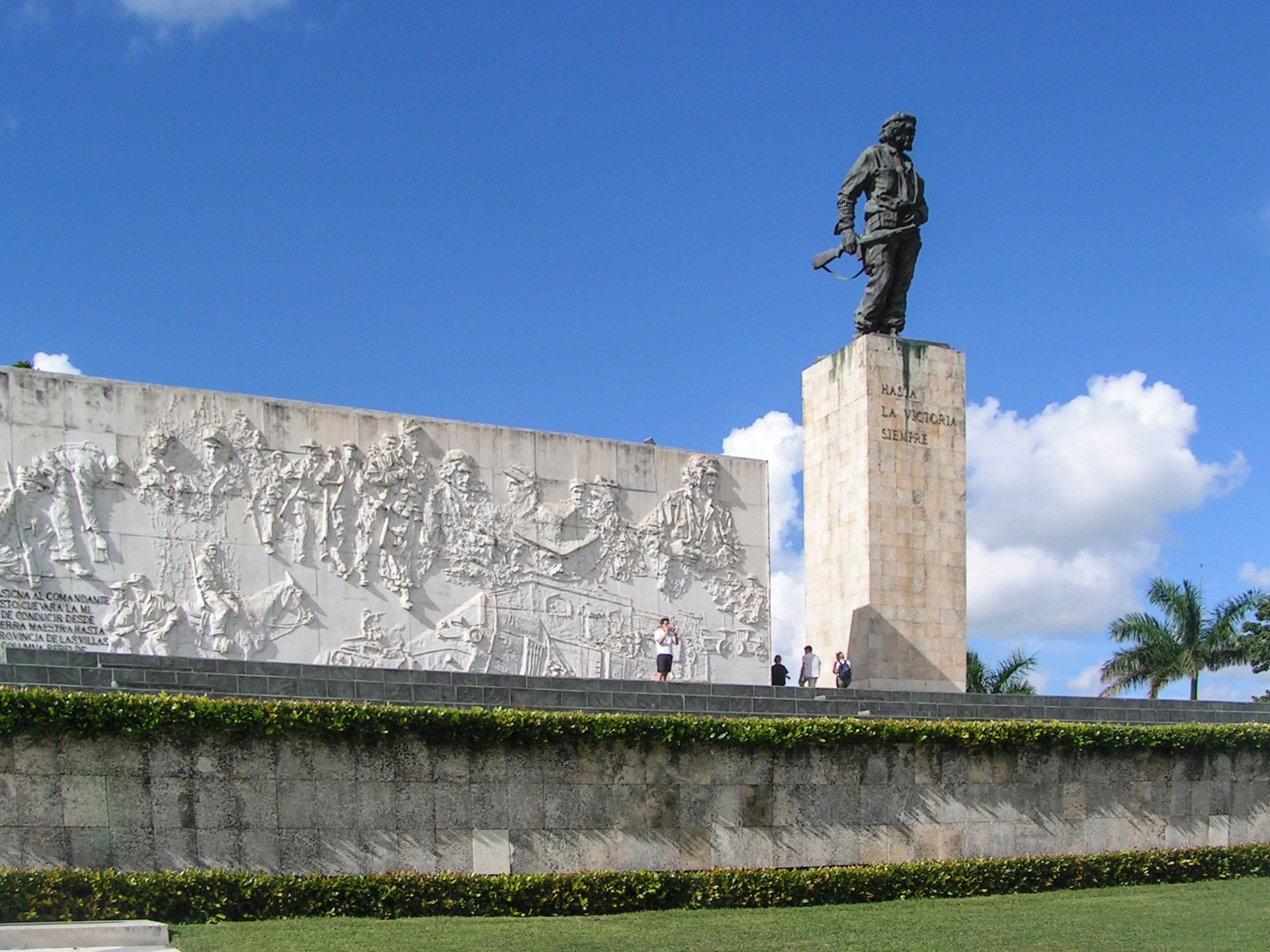 Che Guevara's Monument and Mausoleum in Santa Clara, Cuba In late 1995, the retired Bolivian General Mario Vargas revealed to Jon Lee Anderson, author of Che Guevara: A Revolutionary Life, that Guevara's corpse lay near a Vallegrande airstrip. The result was a multi-national search for the remains, which lasted more than a year. In July 1997, a team of Cuban geologists and Argentine forensic anthropologists discovered the remnants of seven bodies in two mass graves, including one man without hands (as Guevara would have been). Bolivian government officials with the Ministry of Interior later identified the body as Guevara when the excavated teeth "perfectly matched" a plaster mold of Che's teeth made in Cuba prior to his Congolese expedition. The "clincher" then arrived when Argentine forensic anthropologist Alejandro Inchaurregui inspected the inside hidden pocket of a blue jacket dug up next to the handless cadaver and found a small bag of pipe tobacco. Nino de Guzman, the Bolivian helicopter pilot who had given Che a small bag of tobacco, later remarked that he "had serious doubts" at first and "thought the Cubans would just find any old bones and call it Che"; but "after hearing about the tobacco pouch, I have no doubts."[277] On 17 October 1997 (30 years and 8 days after Guevara's death), Guevara's remains, with those of six of his fellow combatants, were laid to rest with military honors in a specially built mausoleum in the Cuban city of Santa Clara, where he had commanded over the decisive military victory of the Cuban Revolution.[327] In July 2008, the Bolivian government of Evo Morales unveiled Guevara's formerly-sealed diaries composed in two frayed notebooks, along with a logbook and several black-and-white photographs. At this event Bolivia's vice-minister of culture, Pablo Groux, expressed that there were plans to publish photographs of every handwritten page later in the year.[328] Meanwhile, in August 2009, anthropologists working for Bolivia's Justice Ministry discovered and unearthed the bodies of five of Guevara's fellow guerrillas near the Bolivian town of Teoponte.[329] The discovery of Che's remains metonymically activated a series of interlinked associations—rebel, martyr, rogue figure from a picaresque adventure, savior, renegade, extremist—in which there was no fixed divide among them. The current court of opinion places Che on a continuum that teeters between viewing him as a misguided rebel, a coruscatingly brilliant guerrilla philosopher, a poet-warrior jousting at windmills, a brazen warrior who threw down the gauntlet to the bourgeoisie, the object of fervent paeans to his sainthood, or a mass murderer clothed in the guise of an avenging angel whose every action is imbricated in violence—the archetypal Fanatical Terrorist. — Dr. Peter McLaren, author of Che Guevara, Paulo Freire, and the Pedagogy of Revolution[330] |
遺体と遺品の回収 主な記事:チェ・ゲバラの霊廟  キューバ、サンタ・クララにあるチェ・ゲバラの記念碑と霊廟 1995年後半、ボリビアの退役将軍マリオ・バルガスは、『チェ・ゲバラ:革命の人生』の著者ジョン・リー・アンダーソンに対し、ゲバラの遺体はバレグラ ンデの滑走路の近くにあると明かした。その結果、1 年以上にわたる多国籍の遺体捜索が行われた。1997年7月、キューバの地質学者とアルゼンチンの法医学人類学者からなるチームが、2つの集団墓から7体 の遺体を発見した。その中には、ゲバラと同じように両手のない男性も1人いた。その後、内務省のボリビア政府当局者は、発掘された歯が、コンゴ遠征前に キューバで作成されたゲバラの歯の石膏型と「完全に一致」したことから、この遺体をゲバラと断定した。そして、決定的な証拠となったのは、アルゼンチンの 法医学人類学者アレハンドロ・インチャウレギが、手のない死体のそばから発掘された青いジャケットの隠しポケットを調べ、小さなパイプタバコ入れを見つけ たことだった。ゲバラにタバコの袋を渡したボリビアのヘリコプターパイロット、ニノ・デ・グスマンは、当初「真剣な疑いがあった」と述べ、「キューバ人は 古い骨を見つけてゲバラだと主張するだろう」と考えていたが、「タバコの袋の話を聞いてからは、疑いはなくなった」と語った。[277] 1997年10月17日(ゲバラの死後30年と8日後)、ゲバラの遺体と彼の戦友6人の遺体は、キューバ革命の決定的な軍事勝利を指揮したキューバのサン タクララ市に特別に建設された墓廟に、軍事的栄誉をもって埋葬された。[327] 2008年7月、ボリビアのエボ・モラレス政権は、ゲバラが2冊の破れたノートに記した、これまで封印されていた日記と、航海日誌、数枚の白黒写真を公開 した。このイベントで、ボリビアの文化副大臣パブロ・グロックスは、同年中に手書きのすべてのページの写真を出版する計画があると述べた。[328] 一方、2009年8月、ボリビア司法省の人類学者は、ボリビアのテオポンテ近郊でゲバラの同志ゲリラ5人の遺体を発見し発掘した。[329] チェの遺体の発見は、反逆者、殉教者、ピカレスク小説の冒険物語の悪党、救世主、反逆者、過激派など、相互に関連し合う一連の連想を比喩的に呼び起こし、 その間には明確な境界は存在しなかった。現在の世論は、チェを次のような連続体の上に位置づけている。誤った反乱者、輝かしいゲリラ哲学者、風車に挑む詩 人戦士、ブルジョアジーに戦いを挑んだ大胆な戦士、 彼の聖人化を熱烈に讃える対象、あるいは復讐の天使の仮面を被った大量殺人者——暴力に包まれた典型的な狂信的テロリスト——として見るという連続体上に 位置づけている。 — ピーター・マクラーレン博士、『チェ・ゲバラ、パウロ・フレイレ、そして革命の教育学』の著者[330] |
| Biographical debate Guevara's life and legacy remain contentious. The perceived contradictions of his ethos at various points in his life have created a complex character of duality, one who was "able to wield the pen and submachine gun with equal skill", while prophesying that "the most important revolutionary ambition was to see man liberated from his alienation".[331] Guevara's paradoxical standing is further complicated by his array of seemingly diametrically opposed qualities. He was a secular humanist and sympathetic practitioner of medicine who did not hesitate to shoot his enemies, a celebrated internationalist leader who advocated violence to enforce a utopian philosophy of the collective good, an idealistic intellectual who loved literature but refused to allow dissent, an anti-imperialist Marxist insurgent who was radically willing to forge a poverty-less new world on the apocalyptic ashes of the old one, and finally, an outspoken anti-capitalist whose image has been commoditized. Che's history continues to be rewritten and re-imagined.[332][333] Moreover, sociologist Michael Löwy contends that the many facets of Guevara's life (i.e. doctor and economist, revolutionary and banker, military theoretician and ambassador, deep thinker and political agitator) illuminated the rise of the "Che myth", allowing him to be invariably crystallized in his many metanarrative roles as a "Red Robin Hood, Don Quixote of communism, new Garibaldi, Marxist Saint Just, Cid Campeador of the Wretched of the Earth, Sir Galahad of the beggars ... and Bolshevik devil who haunts the dreams of the rich, kindling braziers of subversion all over the world".[334] 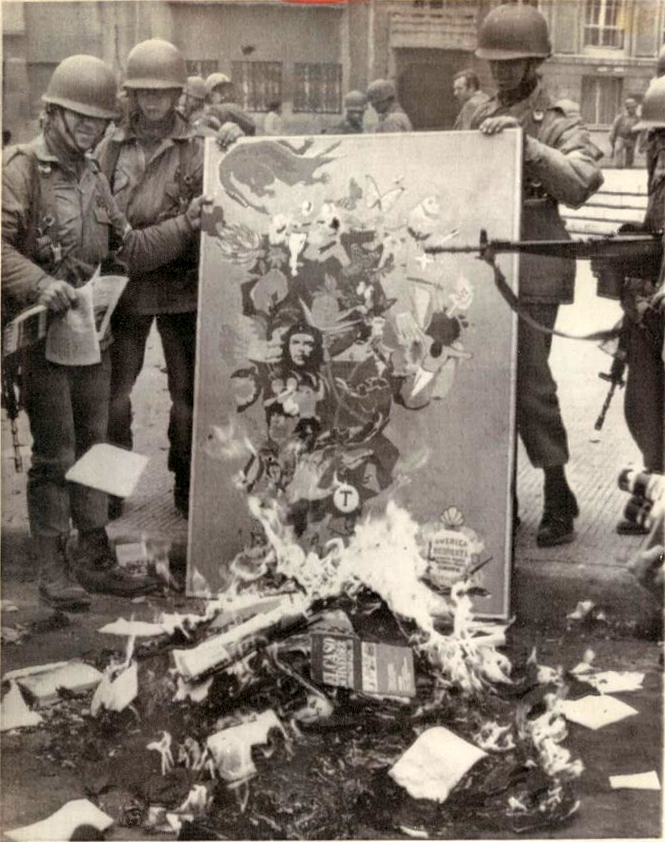 The burning of a painting containing Che's face, following the 1973 coup that installed the Pinochet regime in Chile As such, various notable individuals have lauded Guevara; for example, Nelson Mandela referred to him as "an inspiration for every human being who loves freedom",[335] while Jean-Paul Sartre described him as "not only an intellectual but also the most complete human being of our age".[336] Others who have expressed their admiration include authors Graham Greene, who remarked that Guevara "represented the idea of gallantry, chivalry, and adventure",[337] and Susan Sontag, who supposed that "[Che's] goal was nothing less than the cause of humanity itself."[338] In the Pan-African community philosopher Frantz Fanon professed Guevara to be "the world symbol of the possibilities of one man",[339] while Black Power leader Stokely Carmichael eulogized that "Che Guevara is not dead, his ideas are with us."[340] Praise has been reflected throughout the political spectrum, with libertarian theorist Murray Rothbard extolling Guevara as a "heroic figure" who "more than any man of our epoch or even of our century, was the living embodiment of the principle of revolution",[341] while journalist Christopher Hitchens reminisced that "[Che's] death meant a lot to me and countless like me at the time, he was a role model, albeit an impossible one for us bourgeois romantics insofar as he went and did what revolutionaries were meant to do—fought and died for his beliefs."[342] Former CIA employee Philip Agee said "There was no person more feared by the company (CIA) than Che Guevara because he had the capacity and charisma necessary to direct the struggle against the political repression of the traditional hierarchies in power in the countries of Latin America".[335] |
伝記に関する議論 ゲバラの人生と遺産は、依然として論争の的となっている。彼の生涯のさまざまな段階で示された倫理観の矛盾は、彼に二面性を持つ複雑な人物像を形作ってい る。彼は「ペンとサブマシンガンを同じように巧みに操る」人物でありながら、「最も重要な革命的野心は、人間が疎外から解放されることを見ることだ」と予 言した。[331] ゲバラの矛盾した立場は、一見対立する性質の組み合わせによってさらに複雑化している。彼は、敵を躊躇なく撃ち殺す世俗的な人道主義者であり、同情心にあ ふれた医師であり、集団の幸福というユートピア的な哲学を暴力で実現することを唱えた、国際的に有名な指導者であり、文学を愛する理想主義的な知識人であ りながら、異議を一切認めなかった人物であり、旧世界の終焉の灰の上に、貧困のない新しい世界を構築することを断固として目指した反帝国主義のマルクス主 義者であり、そして最後に、 資本主義に反対する率直な人物であり、そのイメージは商品化されている。チェの生涯は、今もなお書き換えられ、再解釈され続けている。[332] [333] さらに、社会学者のマイケル・ローウィは、ゲバラの生涯の多面性(医師兼経済学者、革命家兼銀行家、軍事理論家兼大使、深遠な思想家兼政治活動家)が 「チェ・ミソス」の台頭を照らし出し、彼を「赤いロビン・フッド、 共産主義のドン・キホーテ、新しいガリバルディ、マルクス主義のサン・ジュスト、地に呪われた者たちのシッド・カンペアドール、乞食たちのガラハッド 卿...そして、世界中の反逆の火種を燃やす、金持ちたちの夢に現れるボルシェビキの悪魔」という、彼の多くのメタナラティブ的な役割に、彼を不変のもの にしたと主張している。[334]  1973年のクーデターでピノチェト政権がチリに樹立された後、チェの顔を描いた絵画が燃やされた。 このように、ゲバラを称賛する著名人は数多くいる。例えば、ネルソン・マンデラは彼を「自由を愛するすべての人類のインスピレーション」と表現し [335]、ジャン=ポール・サルトルは彼を「単なる知識人ではなく、私たちの時代の最も完全な人間」と形容した。[336] 他にも、ゲバラを称賛した人物としては、作家グラハム・グリーンが「ゲバラは、勇猛さ、騎士道精神、冒険心を体現していた」と評し[337]、スーザン・ ソンタグは「チェの目標は、まさに人類そのものの大義だった」と推測している。パン・アフリカ共同体哲学者フランツ・ファノンは、ゲバラを「一人の人間の 可能性の象徴」と評し[339]、ブラック・パワーの指導者ストークリー・カーマイケルは、「チェ・ゲバラは死んではいない、彼の思想は私たちの中に生き 続けている」と賛辞を述べました。[340] 称賛は政治のあらゆる分野に反映されており、リバタリアン理論家のマレー・ロスバードは、ゲバラを「私たちの時代、あるいはこの世紀の誰よりも、革命の原 則を体現した英雄的な人物」と賞賛し[341]、ジャーナリストのクリストファー・ヒッチェンズは、次のように回想している。「(チェの)死は、当時、私 や私のような無数の人々にとって大きな意味があった。彼は、革命家がすべきことを実行し、自分の信念のために戦い、そして死んだという点で、私たちブル ジョアロマンチストにとっては実現不可能なロールモデルだった」と回想している。[342] 元CIA職員フィリップ・アギーは、「チェ・ゲバラほど(CIA)が恐れた人物はいない。彼は、ラテンアメリカ諸国の伝統的な権力階層による政治的抑圧に 対抗する闘争を指揮するために必要な能力とカリスマ性を持っていたからだ」と述べている。[335] |
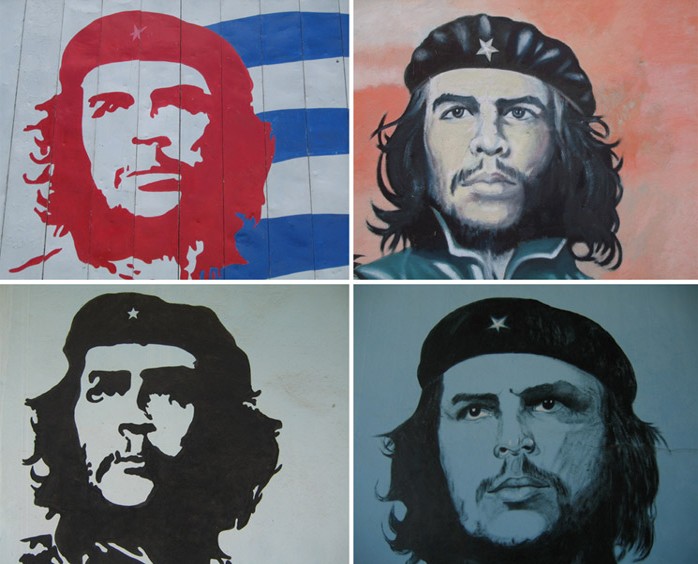 Author Michael Casey notes how Che's image has become a logo as recognizable as the Nike Swoosh or McDonald's Golden Arches.[229] 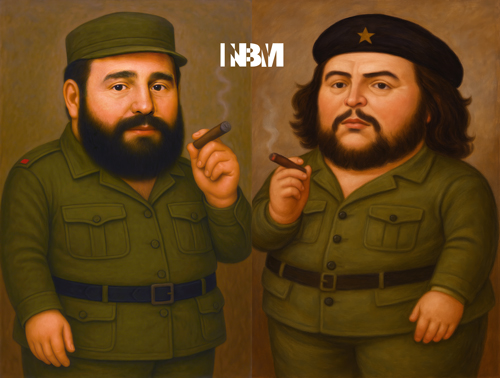 Conversely, Jacobo Machover, an exiled opposition author, dismisses all praise of Guevara and portrays him as a callous executioner.[343] Exiled former Cuban prisoners have expressed similar opinions, among them Armando Valladares, who declared Guevara "a man full of hatred" who executed dozens without trial,[344] and Carlos Alberto Montaner, who asserted that Guevara possessed "a Robespierre mentality", wherein cruelty against the revolution's enemies was a virtue.[345] Álvaro Vargas Llosa of the Independent Institute has hypothesized that Guevara's contemporary followers "delude themselves by clinging to a myth", describing Guevara as a "Marxist Puritan" who employed his rigid power to suppress dissent, while also operating as a "cold-blooded killing machine".[181] Llosa also accuses Guevara's "fanatical disposition" as being the linchpin of the "Sovietization" of the Cuban revolution, speculating that he possessed a "total subordination of reality to blind ideological orthodoxy".[181] On a macro-level, Hoover Institution research fellow William Ratliff regards Guevara more as a creation of his historical environment, referring to him as a "fearless" and "head-strong Messiah-like figure", who was the product of a martyr-enamored Latin American culture which "inclined people to seek out and follow paternalistic miracle workers".[346] Ratliff further speculates that the economic conditions in the region suited Guevara's commitment to "bring justice to the downtrodden by crushing centuries-old tyrannies"; describing Latin America as being plagued by what Moisés Naím referred to as the "legendary malignancies" of inequality, poverty, dysfunctional politics and malfunctioning institutions.[346] |
 著者マイケル・ケイシーは、チェのイメージがナイキのスウッシュやマクドナルドのゴールデンアーチと同じくらい認識しやすいロゴになったことを指摘している。[229]  一方、亡命中の反体制作家ヤコボ・マチョーバーは、ゲバラに対する称賛をすべて否定し、彼を冷酷な死刑執行人だと描写している。[343] 亡命中の元キューバ囚人たちは同様の意見を表明しており、その中にはゲバラを「憎しみに満ちた男」と称し、裁判なしに数十人を処刑したと述べたアルマン ド・ヴァラダレス[344] や、ゲバラが「ロベスピエール的な思想」を持ち、革命の敵に対する残酷さを美徳としていたと主張したカルロス・アルベルト・モンタナーがいる。[345] 独立研究所のアルヴァロ・バルガス・ロサは、ゲバラの現代の支持者たちは「神話に固執することで自己欺瞞に陥っている」と仮定し、ゲバラを「マルクス主義 のピューリタン」と形容し、彼は厳格な権力を用いて異議を弾圧し、同時に「冷酷な殺戮マシン」として機能したと説明している。[181] ロッサはまた、ゲバラの「狂信的な性格」がキューバ革命の「ソビエト化」の要であったと非難し、彼が「現実を盲目的なイデオロギー的正統性に完全に従属さ せる」傾向を持っていたと推測している。[181] マクロレベルでは、フーバー研究所の研究員ウィリアム・ラトリフは、ゲバラを「大胆不敵」で「頑固な救世主のような人物」と表現し、彼を「殉教者に憧れる ラテンアメリカ文化の産物」であり、「人民を父権的な奇跡の行者を求め、従うように仕向けた」人物だと評価している。[346] ラットリフはさらに、地域の経済状況がゲバラの「数百年にわたる独裁政権を打倒して抑圧された人々への正義をもたらす」というコミットメントに適合してい たと推測し、ラテンアメリカをモイセス・ナイムが「伝説的な悪性腫瘍」と呼んだ不平等、貧困、機能不全の政治、機能不全の機関に悩まされていると描写して いる。[346] |
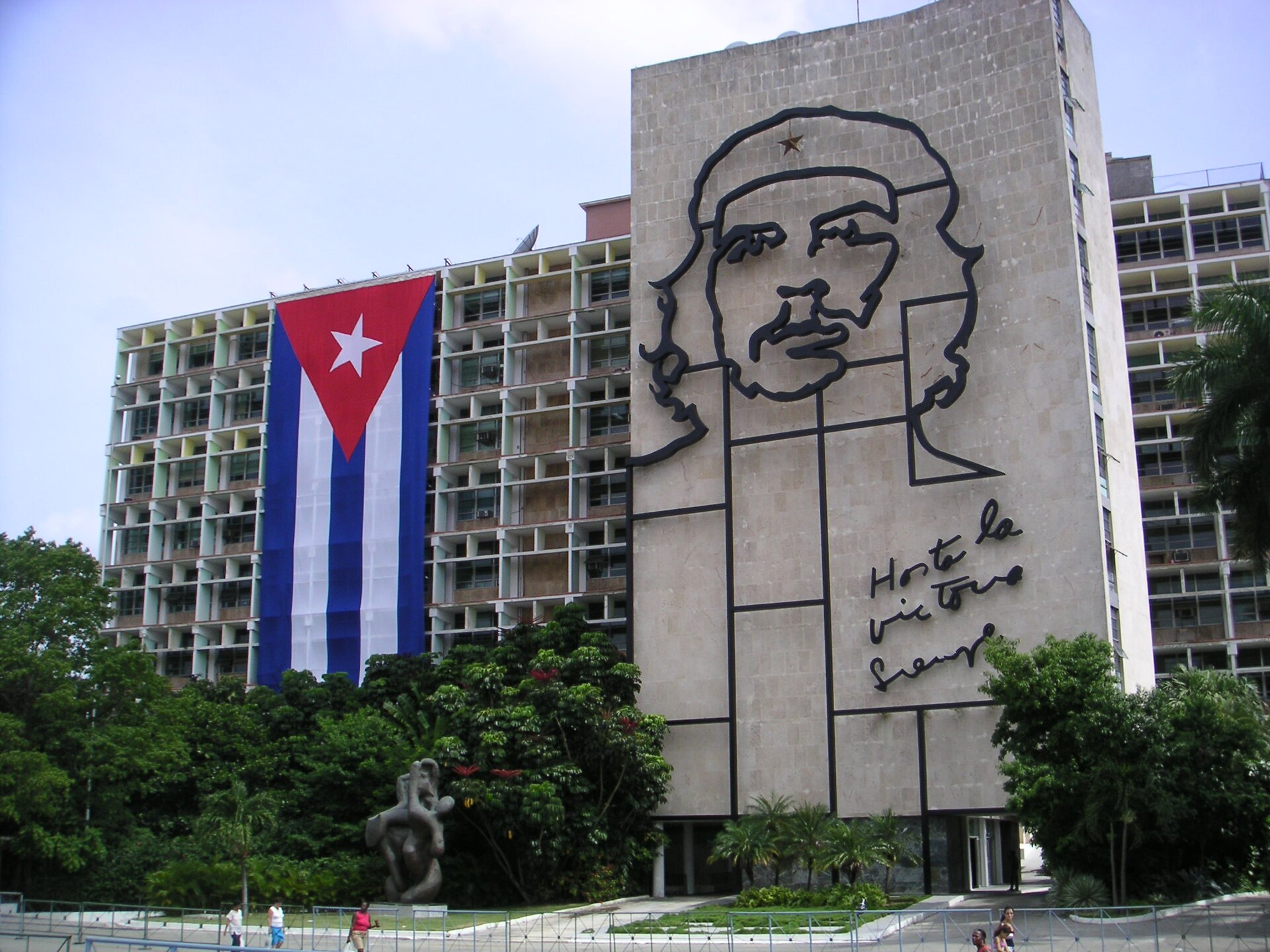 Plaza de la Revolución, in Havana, Cuba. Aside the Ministry of the Interior building where Guevara once worked is a 5-story steel outline of his face. Under the image is Guevara's motto, the Spanish phrase: "Hasta la Victoria Siempre" (English: Until Victory, always). In a mixed assessment, British historian Hugh Thomas opined that Guevara was a "brave, sincere and determined man who was also obstinate, narrow, and dogmatic".[347] At the end of his life, according to Thomas, "he seems to have become convinced of the virtues of violence for its own sake", while "his influence over Castro for good or evil" grew after his death, as Fidel took up many of his views.[347] Similarly, the Cuban-American sociologist Samuel Farber lauds Che Guevara as "an honest and committed revolutionary", but also criticizes the fact that "he never embraced socialism in its most democratic essence".[348] Nevertheless, Guevara remains a national hero in Cuba, where his image adorns the 3 peso banknote and school children begin each morning by pledging "We will be like Che."[349][350] In his homeland of Argentina, where high schools bear his name,[351] numerous Che museums dot the country, and in 2008, a 3.5-metre (12 ft) bronze statue of him was unveiled in the city of his birth, Rosario.[352] Guevara has been sanctified by some Bolivian campesinos[353] as "Saint Ernesto", who pray to him for assistance.[354] In contrast, Guevara remains a hated figure amongst many in the Cuban exile and Cuban American community of the United States, who view him as "the butcher of La Cabaña".[355] Despite this polarized status, a high-contrast monochrome graphic of Che's face, created in 1968 by Irish artist Jim Fitzpatrick, became a universally merchandized and objectified image,[356][357] found on an endless array of items, including T-shirts, hats, posters, tattoos, and bikinis,[358] contributing to the consumer culture Guevara despised. Yet, he still remains a transcendent figure both in specifically political contexts[359] and as a wide-ranging popular icon of youthful rebellion.[342] Addressing the wide-ranging flexibility of his legacy, Trisha Ziff, director of the 2008 documentary Chevolution, remarked that "Che Guevara's significance in modern times is less about the man and his specific history, and more about the ideals of creating a better society."[360] In a similar vein, the Chilean writer Ariel Dorfman has suggested Guevara's enduring appeal might be because "to those who will never follow in his footsteps, submerged as they are in a world of cynicism, self-interest and frantic consumption, nothing could be more vicariously gratifying than Che's disdain for material comfort and everyday desires."[361] |
 キューバのハバナにある革命広場。ゲバラがかつて働いていた内務省の建物の横には、彼の顔の5階建ての鉄骨の輪郭が立っている。その下には、ゲバラのモッ トーであるスペイン語のフレーズ「Hasta la Victoria Siempre」(英語:勝利まで、常に)が刻まれている。 英国の歴史家ヒュー・トーマスは、ゲバラを「勇敢で誠実、決意に満ちた人物である一方、頑固で偏狭、独断的だった」と評価している。[347] トーマスによると、ゲバラは生涯の終わりに「暴力そのものの美徳を確信するようになった」一方で、「カストロへの影響力」は死後さらに強まり、フィデルが 彼の多くの思想を採用した。[347] 同様に、キューバ系アメリカ人の社会学者サミュエル・ファーバーは、チェ・ゲバラを「誠実で献身的な革命家」と評価する一方で、「最も民主的な本質を持つ 社会主義を決して受け入れることがなかった」と批判している。[348] それにもかかわらず、ゲバラはキューバでは依然として国民的英雄であり、彼の肖像は 3 ペソ紙幣に描かれ、学童たちは毎朝「私たちはチェのようになる」と誓って 1 日を始めている。[349][350] 彼の故郷であるアルゼンチンでは、高校に彼の名前が付けられ[351]、チェ・ゲバラ博物館が数多く点在し、2008年には、彼の生誕地であるロサリオ に、3.5メートル(12フィート)の青銅製の像が除幕された。[352] ゲバラは、一部のボリビアの農民たち[353]によって「聖エルネスト」として崇められ、彼に助けを祈っている。[354] 一方、キューバの亡命者やアメリカ在住のキューバ系コミュニティの多くの人々からは、ゲバラは「ラ・カバニャの屠殺者」として憎悪の対象となっている。 [355] しかし、この対立した立場にもかかわらず、1968年にアイルランドのアーティスト、ジム・フィッツパトリックが作成したチェの顔のハイコントラストなモ ノクログラフィックは、普遍的に商品化され、物象化されたイメージとなった。[356][357] Tシャツ、帽子、ポスター、タトゥー、ビキニなど、数え切れないほどのアイテムに採用され、ゲバラが軽蔑した消費文化に貢献した。しかし、彼は依然とし て、特定の政治的文脈において[359]、そして若者の反乱の広範な人気アイコンとして、超越的な存在であり続けている。[342] 彼の遺産の幅広い柔軟性について、2008年のドキュメンタリー映画『Chevolution』の監督、トリシャ・ジフは、「現代におけるチェ・ゲバラの 意義は、彼の人物や具体的な歴史よりも、より良い社会を創り出すという理想にある」と述べている。[360] 同様の観点から、チリ人作家アリエル・ドルフマンは、ゲバラの持続的な魅力は「彼の足跡をたどることはない人々にとって、皮肉、自己利益、そして激しい消 費に浸った世界において、チェの物質的快適さや日常の欲望への軽蔑ほど、代理的な満足感を与えるものは何もないから」かもしれないと指摘している。 [361] |
| Archival media Video footage Guevara addressing the United Nations General Assembly on 11 December 1964, (6:21), public domain footage uploaded by the UN, video clip Guevara interviewed by Face the Nation on 13 December 1964, (29:11), from CBS, video clip Guevara interviewed in 1964 on a visit to Dublin, Ireland, (2:53), English translation, from RTÉ Libraries and Archives, video clip Guevara interviewed in Paris and speaking French in 1964, (4:47), English subtitles, interviewed by Jean Dumur, video clip Archived 14 September 2013 at the Wayback Machine Guevara reciting a poem, (0:58), English subtitles, from El Che: Investigating a Legend – Kultur Video 2001, video clip Guevara showing support for Fidel Castro, (0:22), English subtitles, from El Che: Investigating a Legend – Kultur Video 2001, video clip Guevara speaking about labor, (0:28), English subtitles, from El Che: Investigating a Legend – Kultur Video 2001, video clip Guevara speaking about the Bay of Pigs, (0:17), English subtitles, from El Che: Investigating a Legend – Kultur Video 2001, video clip Guevara speaking against imperialism, (1:20), English subtitles, from El Che: Investigating a Legend – Kultur Video 2001, video clip Guevara visiting Algeria in 1963 and giving a speech in French, from the Algerian Cinema Archive, video clip Audio recording Guevara interviewed on ABC's Issues and Answers, (22:27), English translation, narrated by Lisa Howard, 24 March 1964, audio clip |
アーカイブメディア ビデオ映像 1964年12月11日、国連総会で演説するゲバラ(6:21)、国連がアップロードしたパブリックドメインの映像、ビデオクリップ 1964年12月13日、CBSの番組「フェイス・ザ・ネイション」でインタビューを受けるゲバラ(29:11)、ビデオクリップ 1964年にアイルランドのダブリンを訪問したゲバラのインタビュー(2:53)、英語翻訳、RTÉライブラリーおよびアーカイブより、ビデオクリップ 1964年にパリでインタビューを受けたゲバラ、フランス語で発言、(4:47)、英語字幕、ジャン・デュムールによるインタビュー、動画クリップ 2013年9月14日にウェイバックマシンにアーカイブ ゲバラが詩を朗読、(0:58)、英語字幕、El Che: Investigating a Legend – Kultur Video 2001より、動画クリップ ゲバラがフィデル・カストロへの支持を示す(0:22)、英語字幕付き、El Che: Investigating a Legend – Kultur Video 2001より、ビデオクリップ ゲバラが労働について語る(0:28)、英語字幕付き、El Che: Investigating a Legend – Kultur Video 2001より、ビデオクリップ ゲバラがピッグス湾事件について語る(0:17)、英語字幕付き、El Che: Investigating a Legend – Kultur Video 2001、ビデオクリップ ゲバラが帝国主義に反対して語る(1:20)、英語字幕付き、El Che: Investigating a Legend – Kultur Video 2001、ビデオクリップ ゲバラが1963年にアルジェリアを訪問し、フランス語で演説する様子、アルジェリア映画アーカイブより、ビデオクリップ 音声記録 ゲバラがABCの「Issues and Answers」でインタビューを受ける様子(22:27)、英語翻訳、ナレーション:リサ・ハワード、1964年3月24日、オーディオクリップ |
| See also: Bibliography of Che Guevara A New Society: Reflections for Today's World, Ocean Press, 1996, ISBN 1875284060 Back on the Road: A Journey Through Latin America, Grove Press, 2002, ISBN 0802139426 Che Guevara, Cuba, and the Road to Socialism, Pathfinder Press, 1991, ISBN 0873486439 Che Guevara on Global Justice, Ocean Press (AU), 2002, ISBN 1876175451 Che Guevara: Radical Writings on Guerrilla Warfare, Politics and Revolution, Filiquarian Publishing, 2006, ISBN 1599869993 Che Guevara Reader: Writings on Politics & Revolution, Ocean Press, 2003, ISBN 1876175699 Che Guevara Speaks: Selected Speeches and Writings, Pathfinder Press (NY), 1980, ISBN 0873486021 Che Guevara Talks to Young People, Pathfinder, 2000, ISBN 087348911X Che: The Diaries of Ernesto Che Guevara, Ocean Press (AU), 2008, ISBN 1920888934 Colonialism is Doomed, Ministry of External Relations: Republic of Cuba, 1964, ASIN B0010AAN1K Congo Diary: The Story of Che Guevara's "Lost" Year in Africa Ocean Press, 2011, ISBN 978-0980429299 Critical Notes on Political Economy: A Revolutionary Humanist Approach to Marxist Economics, Ocean Press, 2008, ISBN 1876175559 Diary of a Combatant: The Diary of the Revolution that Made Che Guevara a Legend, Ocean Press, 2013, ISBN 978-0987077943 Episodes of the Cuban Revolutionary War, 1956–58, Pathfinder Press (NY), 1996, ISBN 0873488245 Global Justice: Three Essays on Liberation and Socialism, Seven Stories Press, 2022, ISBN 1644211564 Guerrilla Warfare: Authorized Edition, Ocean Press, 2006, ISBN 1-920888-28-4 I Embrace You with All My Revolutionary Fervor: Letters 1947-1967, Seven Stories Press, 2021, ISBN 1644210959 Latin America: Awakening of a Continent, Ocean Press, 2005, ISBN 1876175737 Latin America Diaries: The Sequel to The Motorcycle Diaries, Ocean Press, 2011, ISBN 978-0980429275 Marx & Engels: An Introduction, Ocean Press, 2007, ISBN 1920888926 Our America And Theirs: Kennedy And The Alliance For Progress, Ocean Press, 2006, ISBN 1876175818 Reminiscences of the Cuban Revolutionary War: Authorized Edition, Ocean Press, 2005, ISBN 1920888330 Self Portrait Che Guevara, Ocean Press (AU), 2004, ISBN 1876175826 Socialism and Man in Cuba, Pathfinder Press (NY), 1989, ISBN 0873485777 The African Dream: The Diaries of the Revolutionary War in the Congo, Grove Press, 2001, ISBN 0802138349 The Argentine, Ocean Press (AU), 2008, ISBN 1920888934 The Awakening of Latin America: Writings, Letters and Speeches on Latin America, 1950–67, Ocean Press, 2012, ISBN 978-0980429282 The Bolivian Diary of Ernesto Che Guevara, Pathfinder Press, 1994, ISBN 0873487664 The Great Debate on Political Economy, Ocean Press, 2006, ISBN 1876175540 The Motorcycle Diaries: A Journey Around South America, London: Verso, 1996, ISBN 1857023994 The Secret Papers of a Revolutionary: The Diary of Che Guevara, American Reprint Co, 1975, ASIN B0007GW08W To Speak the Truth: Why Washington's "Cold War" Against Cuba Doesn't End, Pathfinder, 1993, ISBN 0873486331 |
関連項目:チェ・ゲバラの参考文献 新しい社会:今日の世界のための考察、オーシャン・プレス、1996年、ISBN 1875284060 再び旅に出る:ラテンアメリカを旅して、グローブ・プレス、2002年、ISBN 0802139426 チェ・ゲバラ、キューバ、そして社会主義への道、パスファインダー・プレス、1991年、ISBN 0873486439 チェ・ゲバラ、グローバル・ジャスティスについて、オーシャン・プレス(オーストラリア)、2002年、ISBN 1876175451 チェ・ゲバラ:ゲリラ戦争、政治、革命に関する過激な著作、フィリクアリアン・パブリッシング、2006年、 ISBN 1599869993 チェ・ゲバラ・リーダー:政治と革命に関する著作、オーシャン・プレス、2003年、ISBN 1876175699 チェ・ゲバラが語る:選集、パスファインダー・プレス(ニューヨーク)、1980年、ISBN 0873486021 チェ・ゲバラ、若者たちへの語りかけ、パスファインダー、2000年、ISBN 087348911X チェ:エルネスト・チェ・ゲバラの日記、オーシャン・プレス(オーストラリア)、2008年、ISBN 1920888934 『植民地主義は滅びる』、キューバ共和国外務省、1964年、ASIN B0010AAN1K 『コンゴ日記:チェ・ゲバラの「失われた」アフリカの一年』、オーシャン・プレス、2011年、ISBN 978-0980429299 政治経済学の批判的ノート:マルクス経済学への革命的人間主義的アプローチ、オーシャン・プレス、2008年、ISBN 1876175559 戦闘員の日記:チェ・ゲバラを伝説にした革命の日記、オーシャン・プレス、2013年、ISBN 978-0987077943 キューバ革命戦争のエピソード、1956–58、パスファインダー・プレス(NY)、1996年、ISBN 0873488245 グローバル・ジャスティス:解放と社会主義に関する三つのエッセイ、セブン・ストーリーズ・プレス、2022年、ISBN 1644211564 ゲリラ戦争:公式版、オーシャン・プレス、2006年、 ISBN 1-920888-28-4 私は革命の情熱を込めてあなたを抱きしめる:1947-1967年の手紙、セブン・ストーリーズ・プレス、2021年、ISBN 1644210959 ラテンアメリカ:大陸の覚醒、オーシャン・プレス、2005年、ISBN 1876175737 『ラテンアメリカ日記:モーターサイクル日記の続編』、オーシャン・プレス、2011年、ISBN 978-0980429275 『マルクスとエンゲルス:入門』、オーシャン・プレス、2007年、ISBN 1920888926 『私たちのアメリカと彼らのアメリカ:ケネディと進歩同盟』、オーシャン・プレス、2006年、 ISBN 1876175818 キューバ革命戦争の回想:公認版、オーシャン・プレス、2005年、ISBN 1920888330 チェ・ゲバラの自画像、オーシャン・プレス(オーストラリア)、2004年、ISBN 1876175826 キューバにおける社会主義と人間、パスファインダー・プレス(NY)、1989年、ISBN 0873485777 アフリカの夢:コンゴ革命戦争の日記、グローブ・プレス、2001年、ISBN 0802138349 アルゼンチン人、オーシャン・プレス(オーストラリア)、2008年、ISBN 1920888934 ラテンアメリカの覚醒:ラテンアメリカに関する著作、書簡、演説、1950-67、オーシャン・プレス、2012年、ISBN 978-0980429282 エルネスト・チェ・ゲバラのボリビア日記、パスファインダー・プレス、1994年、ISBN 0873487664 政治経済に関する大論争、オーシャン・プレス、2006年、ISBN 1876175540 モーターサイクル・ダイアリーズ:南米一周の旅、ロンドン:ヴェルソ、1996年、ISBN 1857023994 革命家の秘密文書:チェ・ゲバラの日記、アメリカン・リプリント社、1975年、ASIN B0007GW08W 真実を語る:ワシントンのキューバに対する「冷戦」が終わらない理由、パスファインダー、1993年、ISBN 0873486331 |
| https://en.wikipedia.org/wiki/Che_Guevara |
|
リ ンク
文 献
そ の他の情報
CC
Copyleft,
CC, Mitzub'ixi Quq Chi'j, 1996-2099